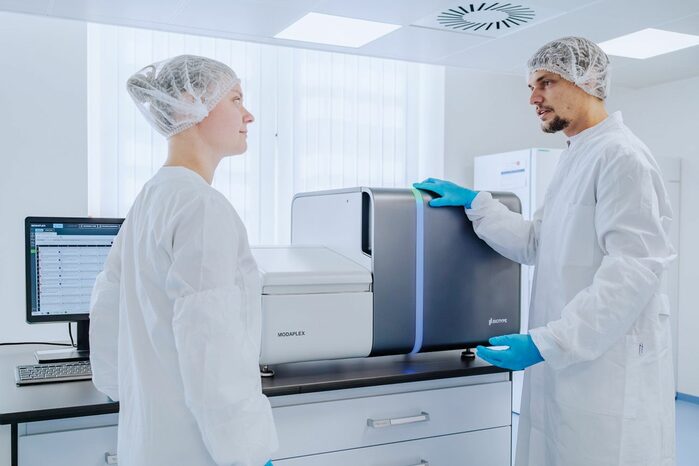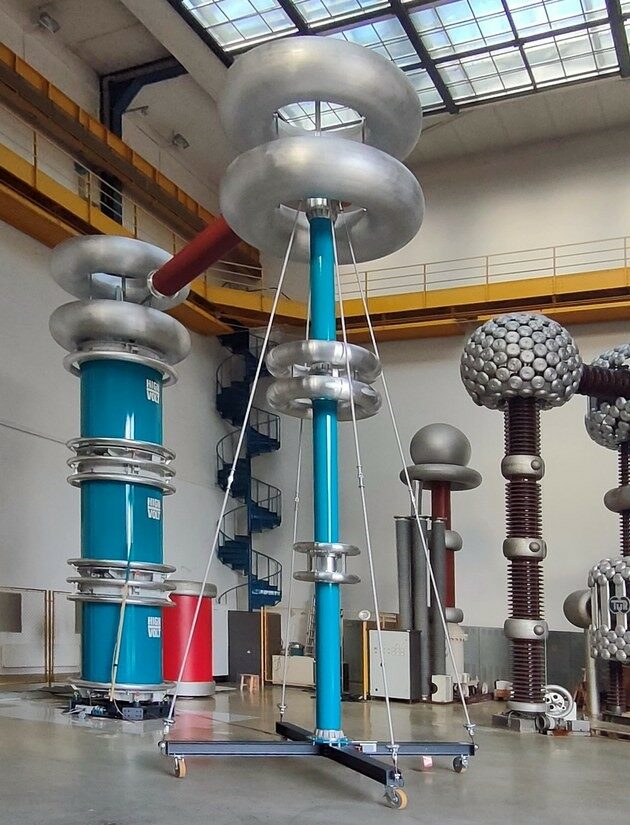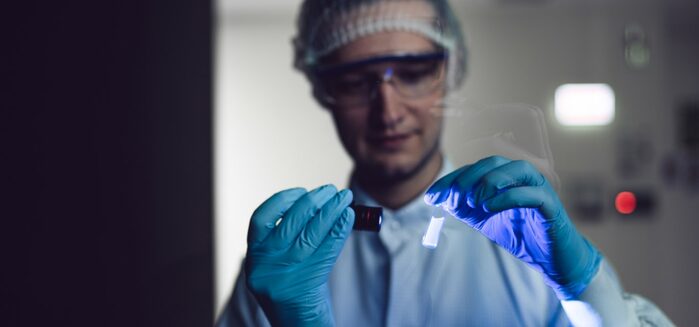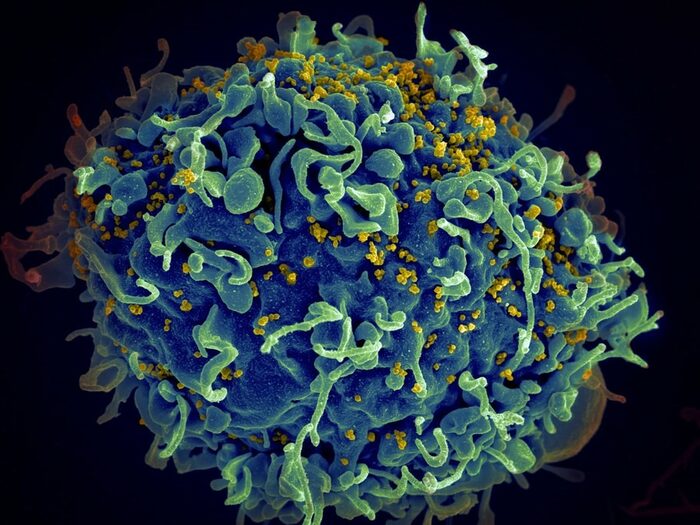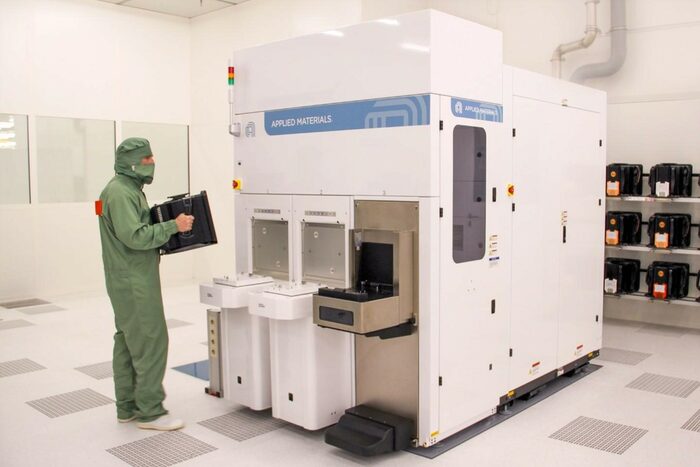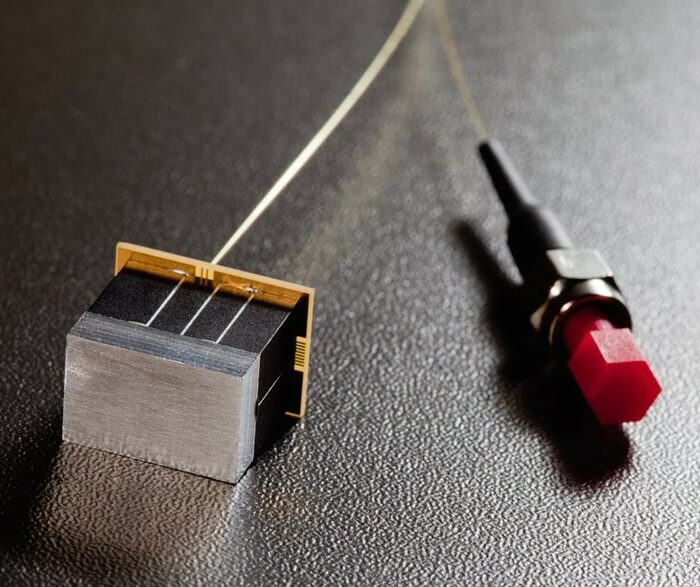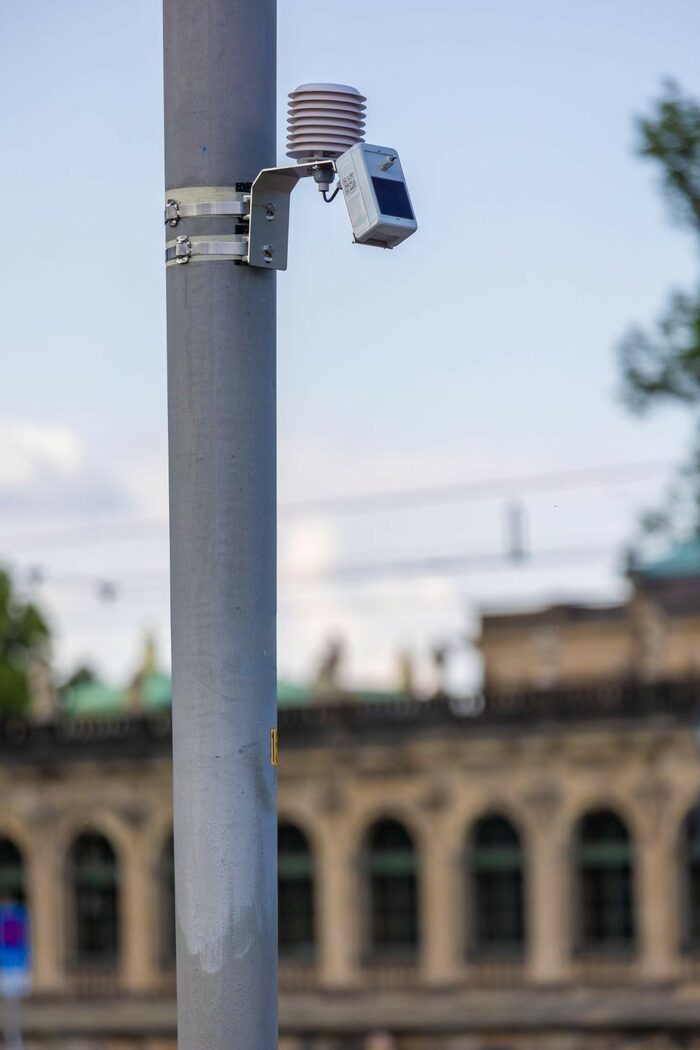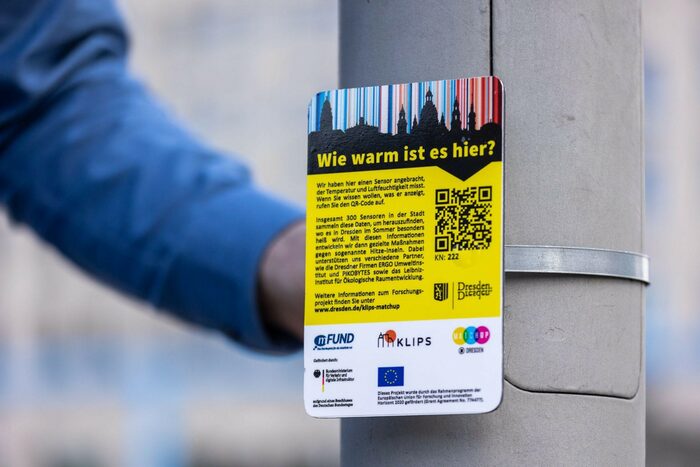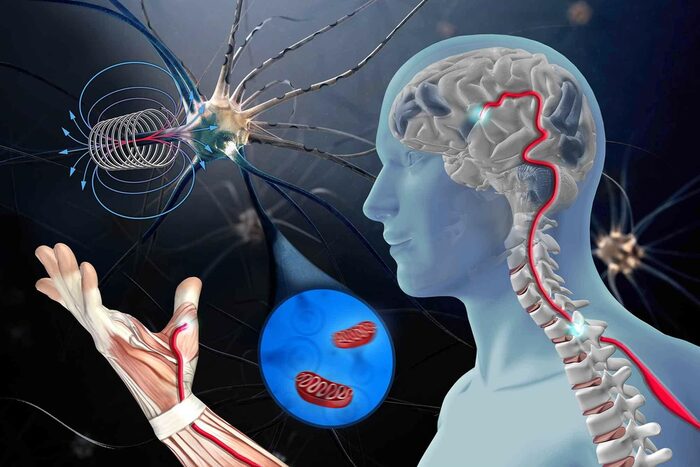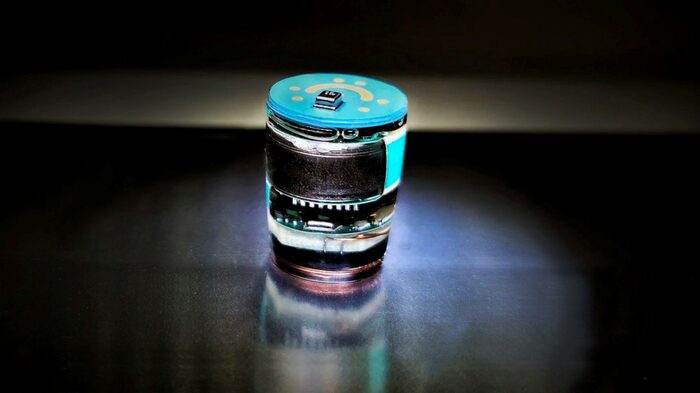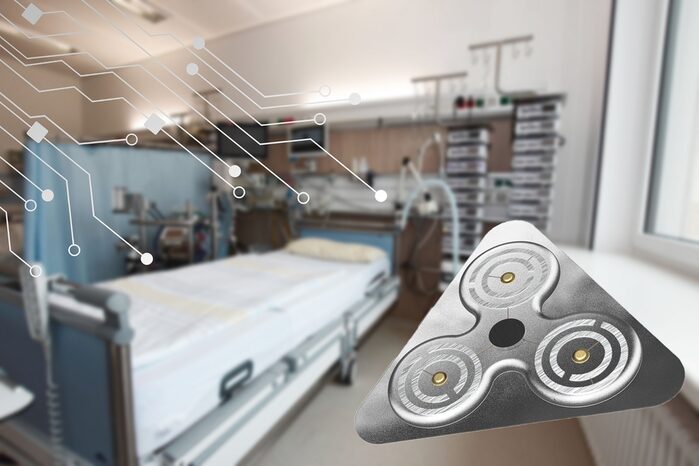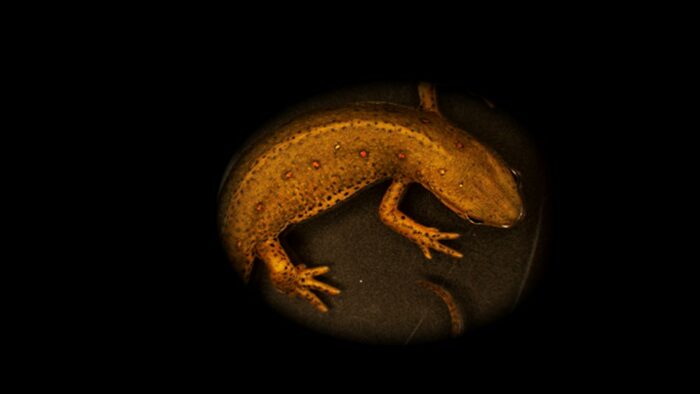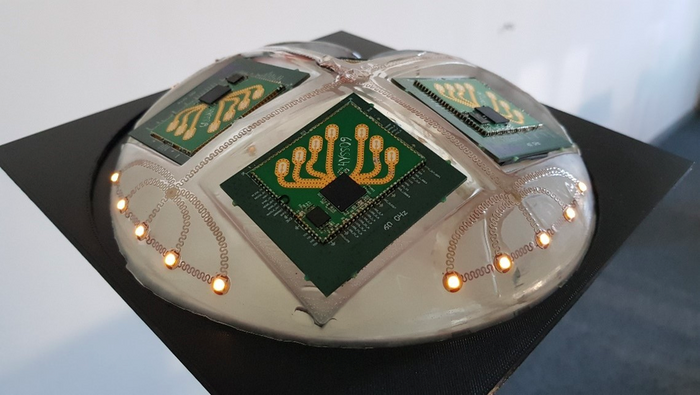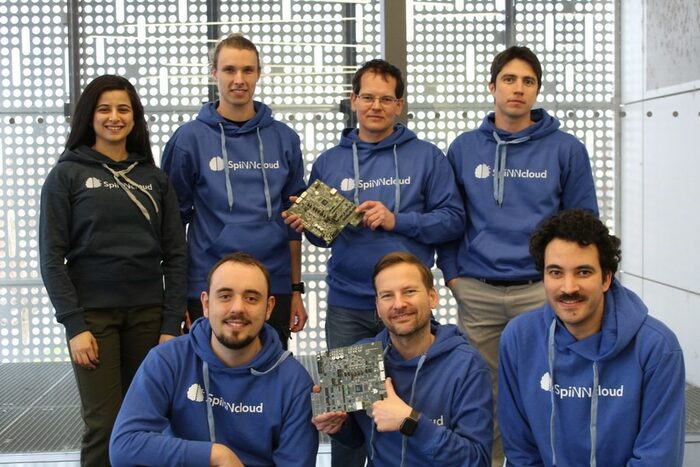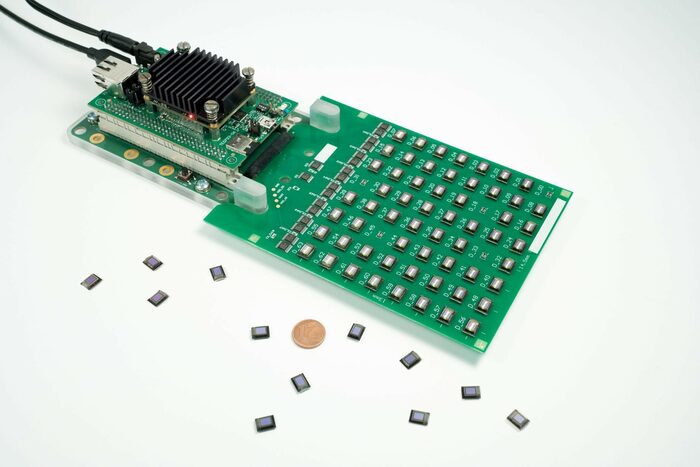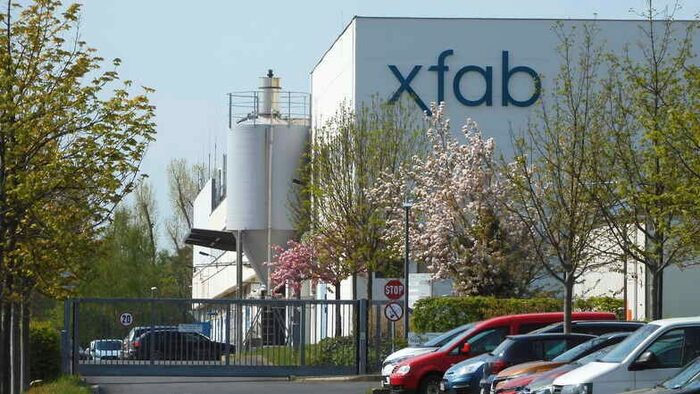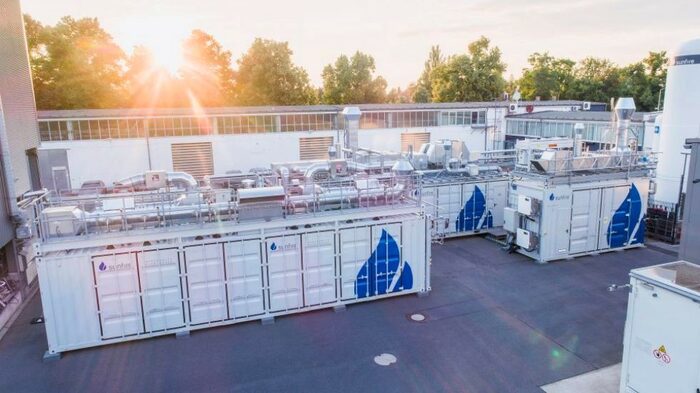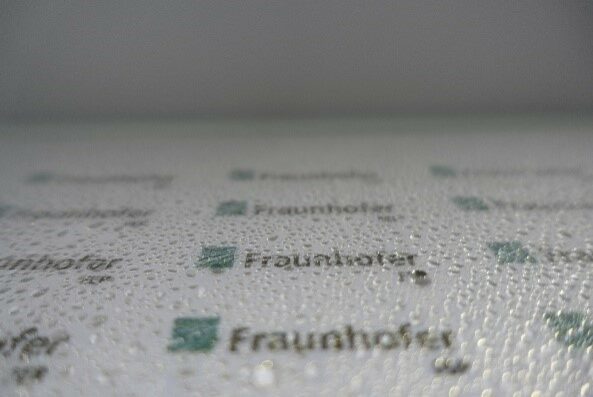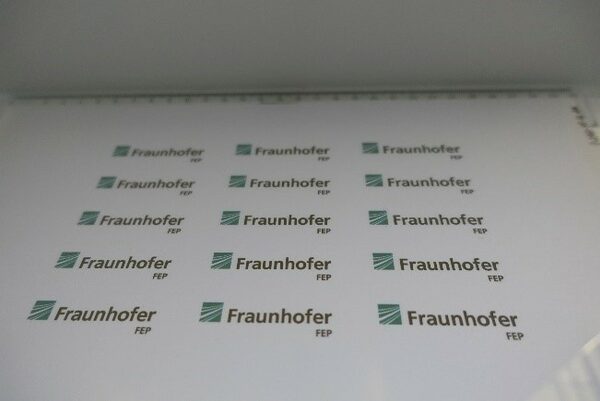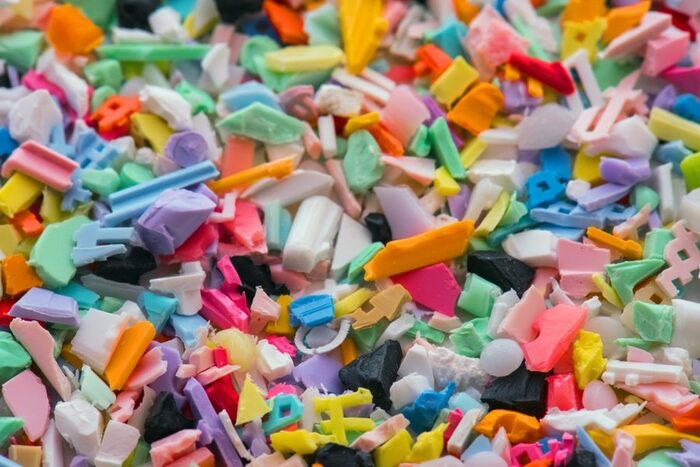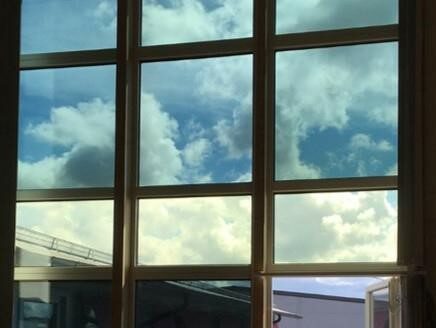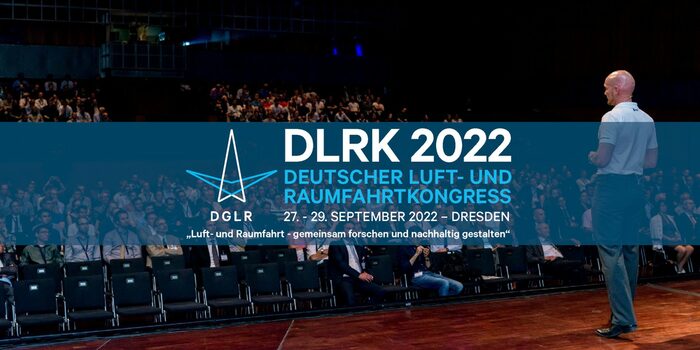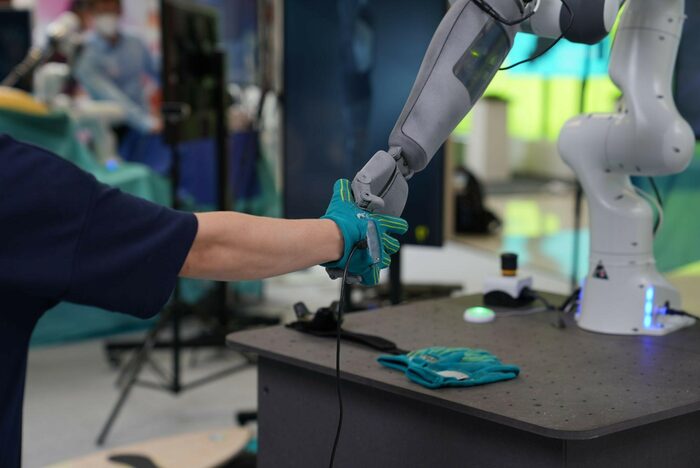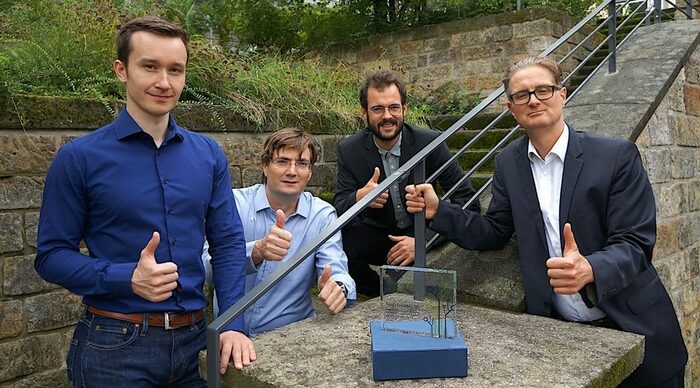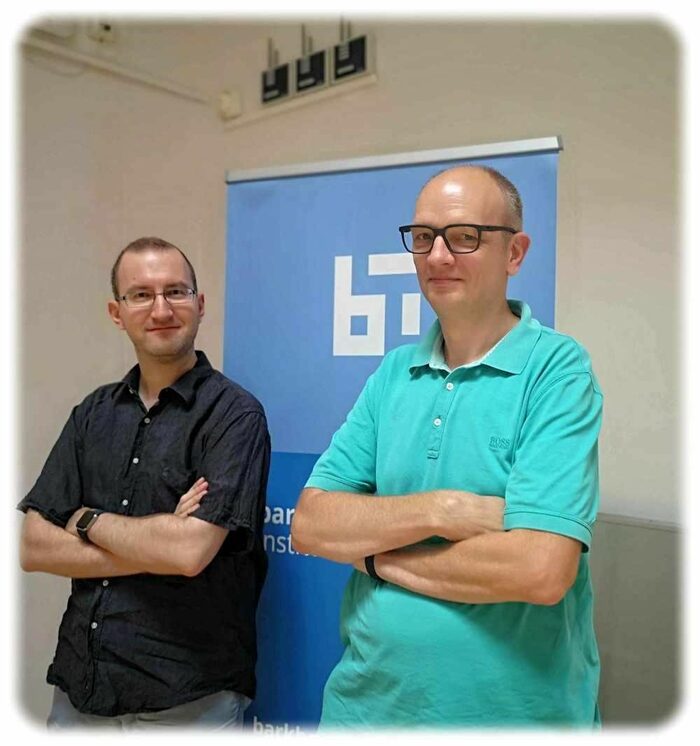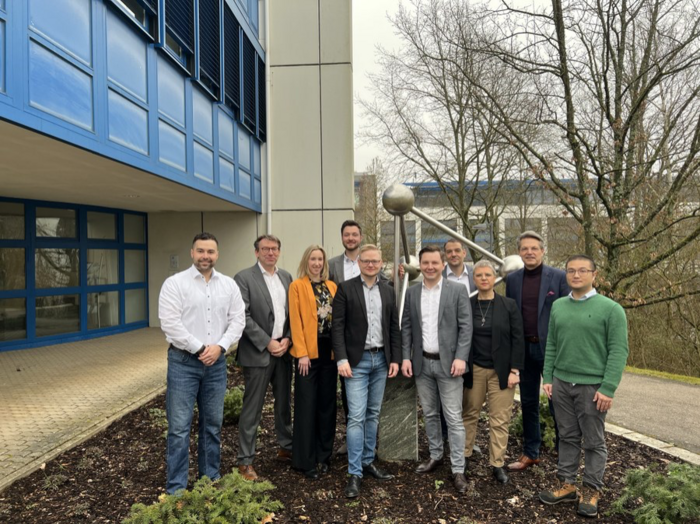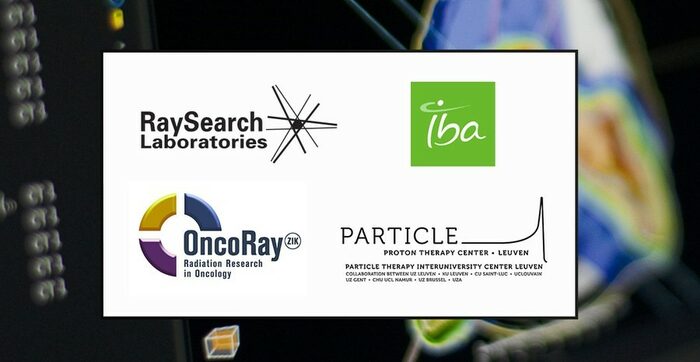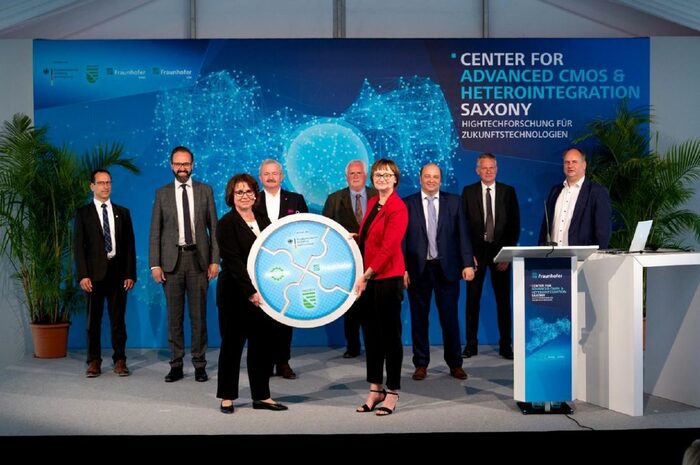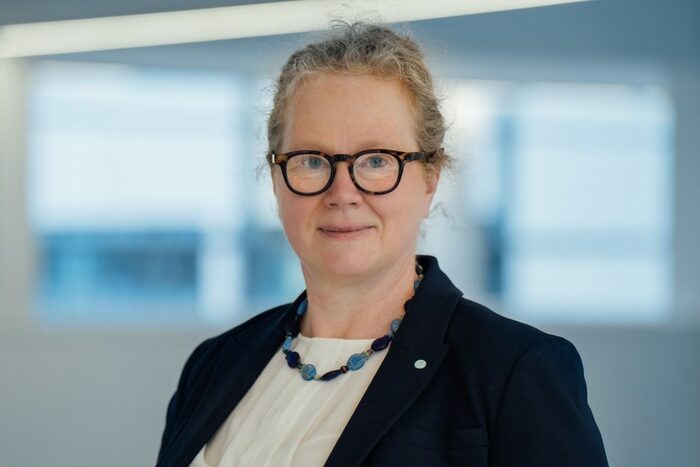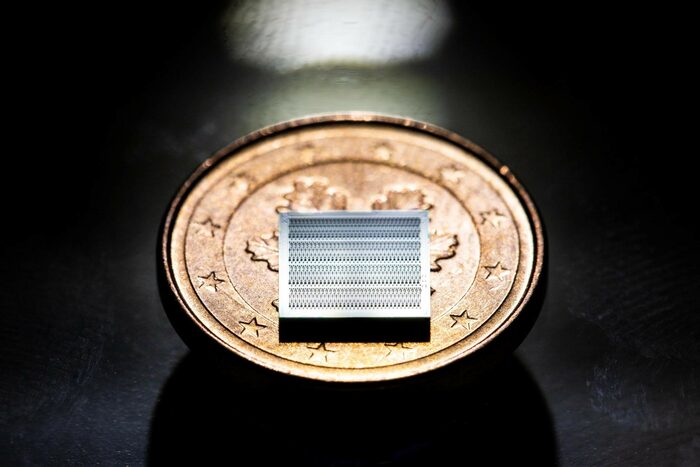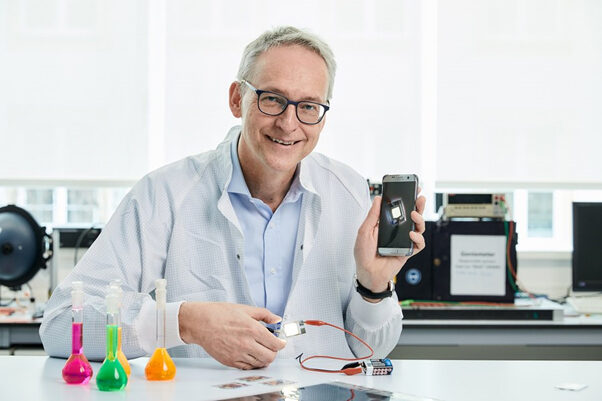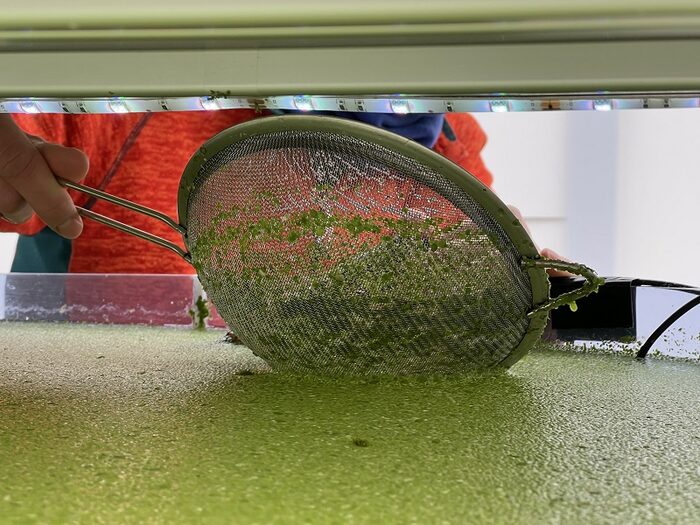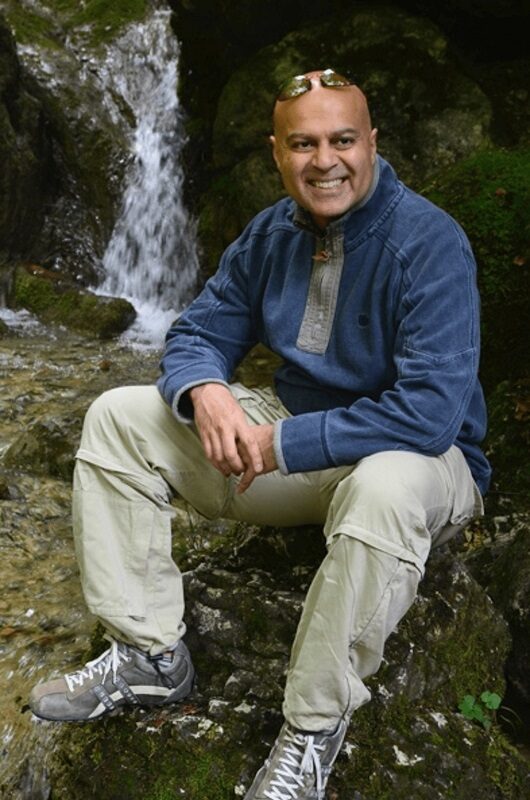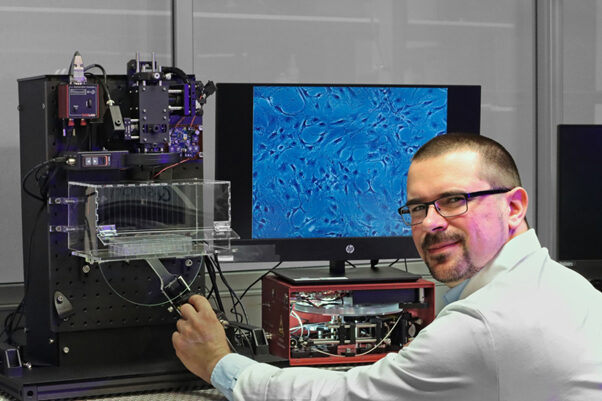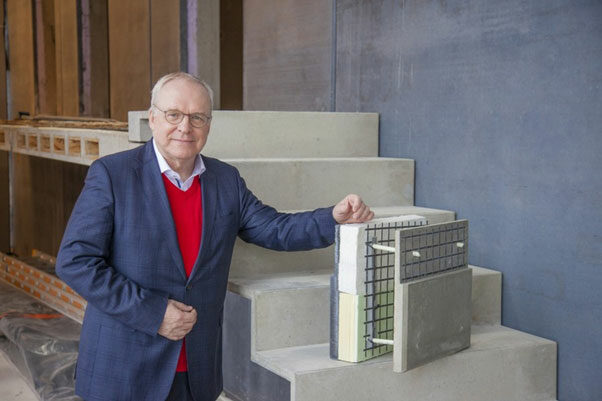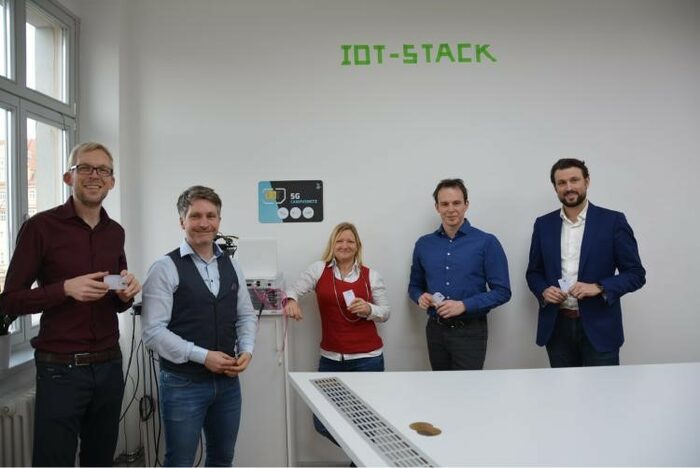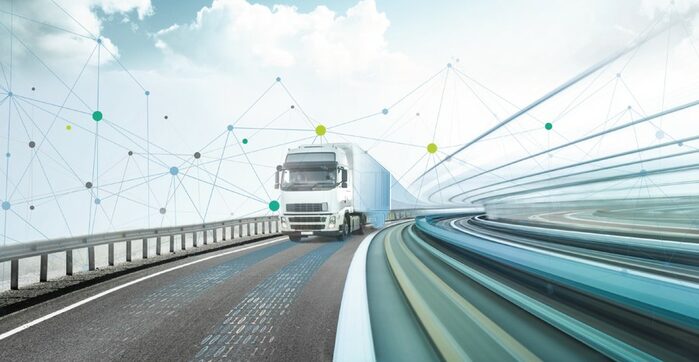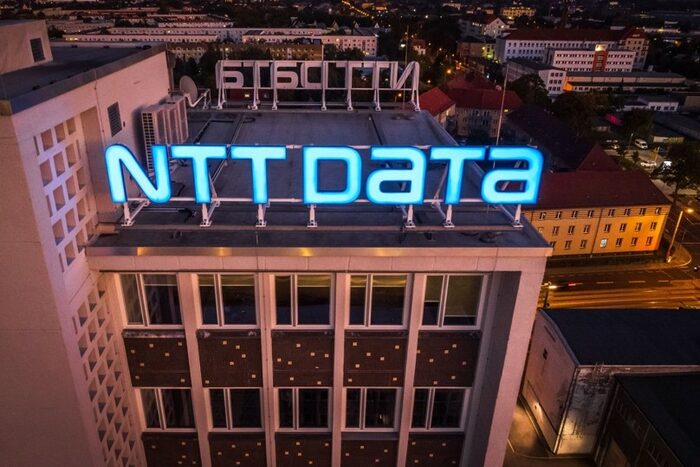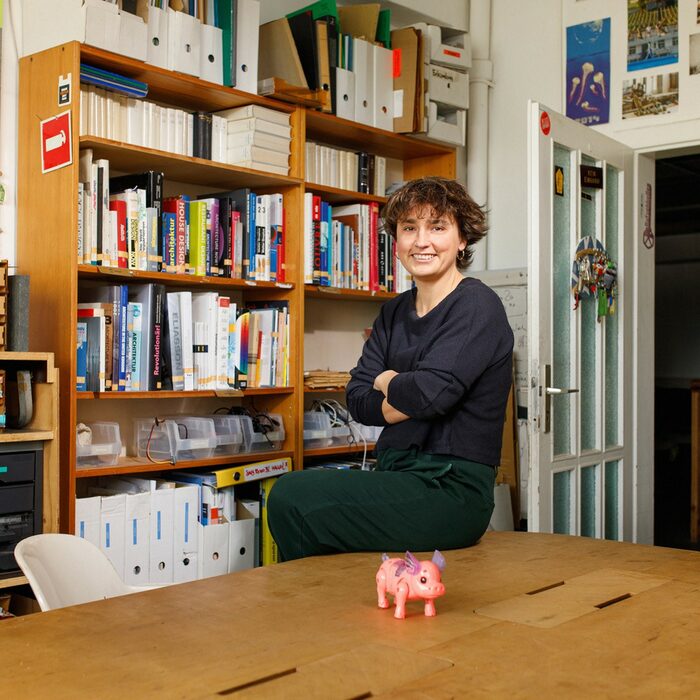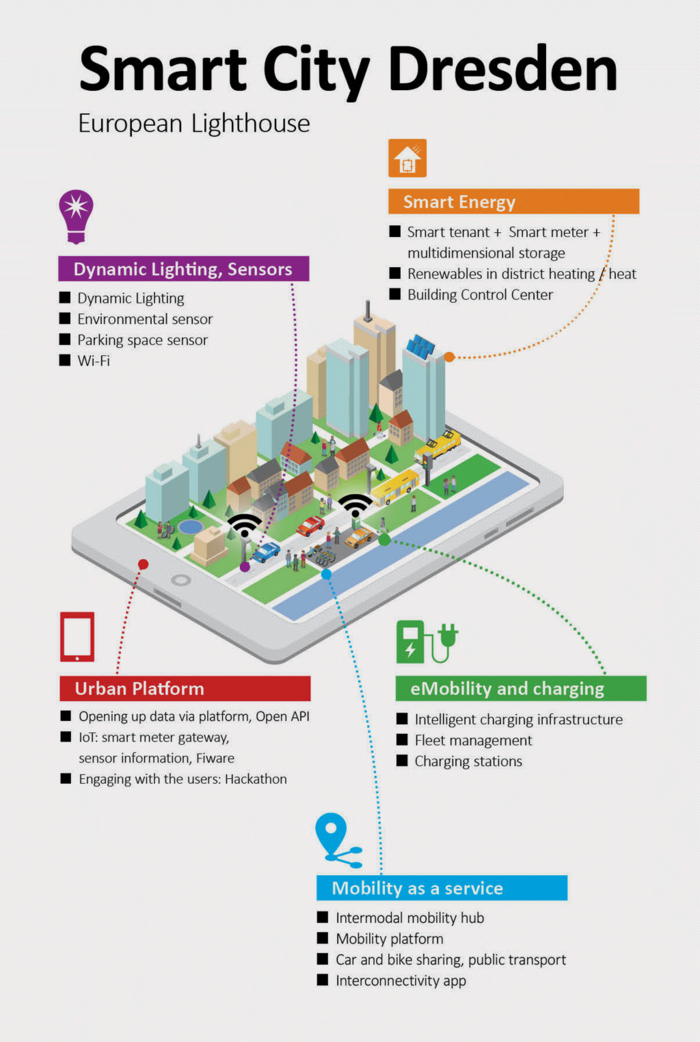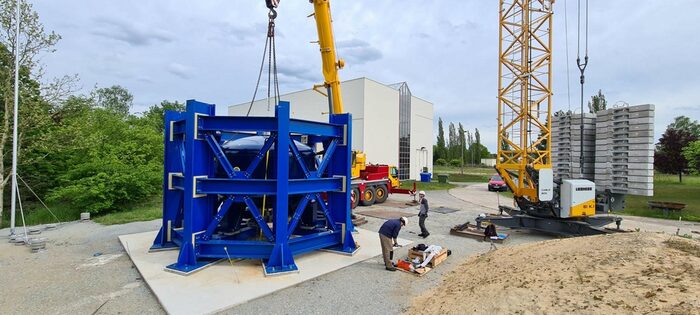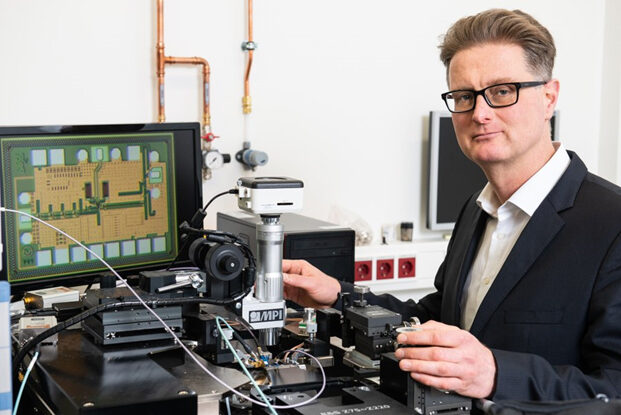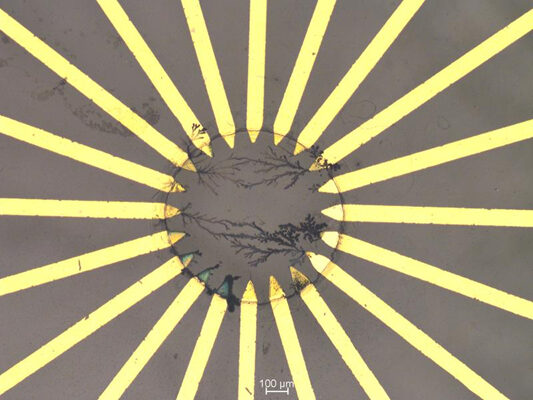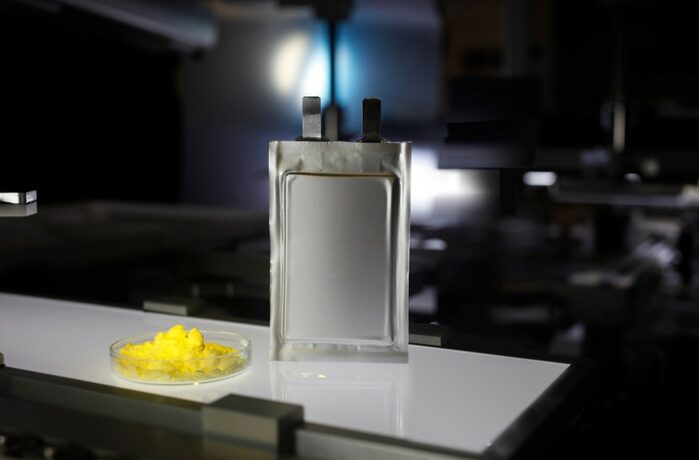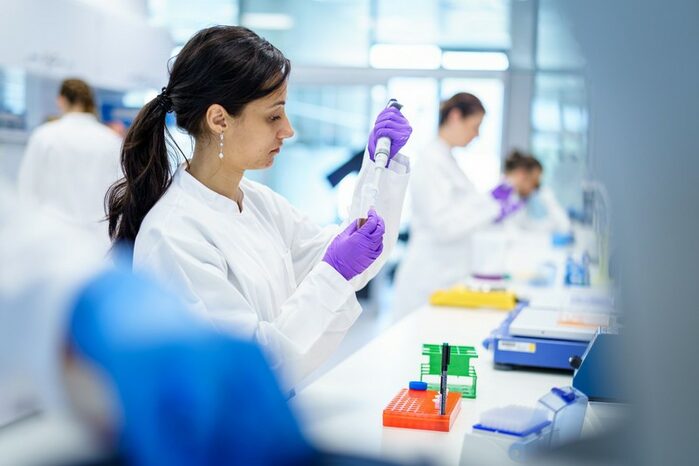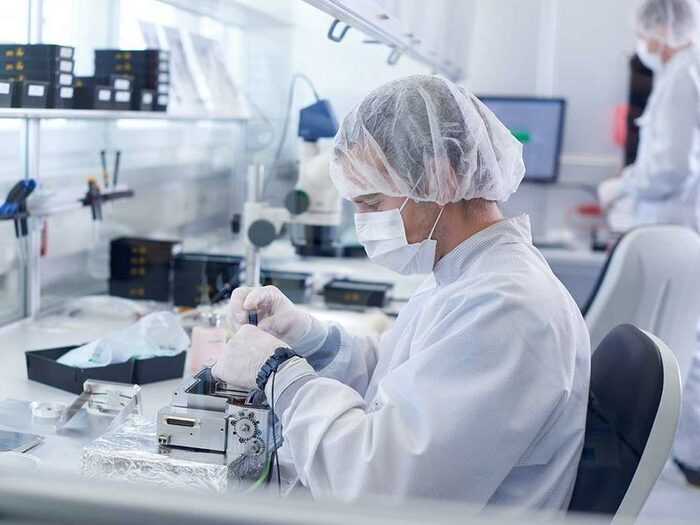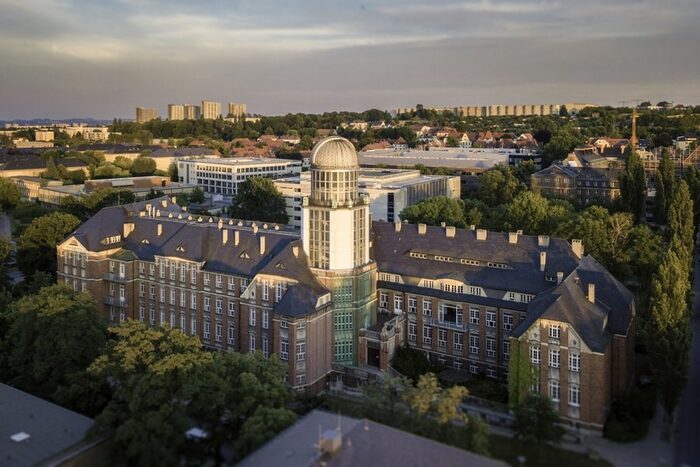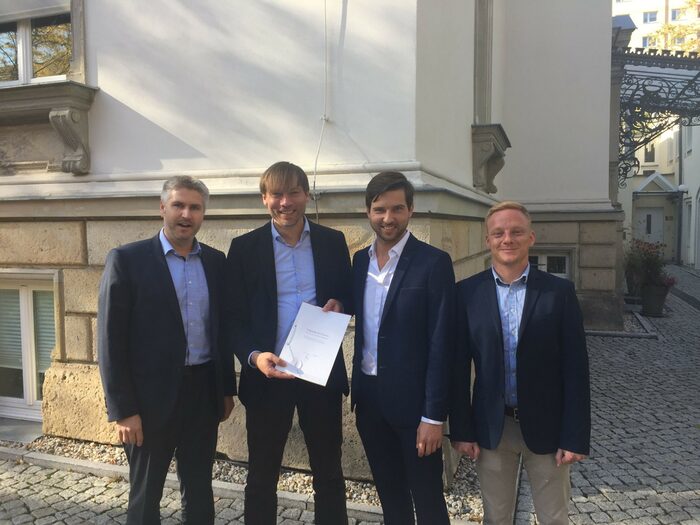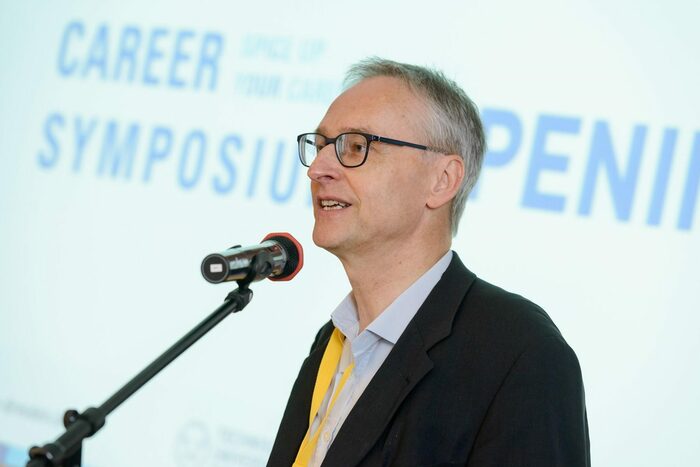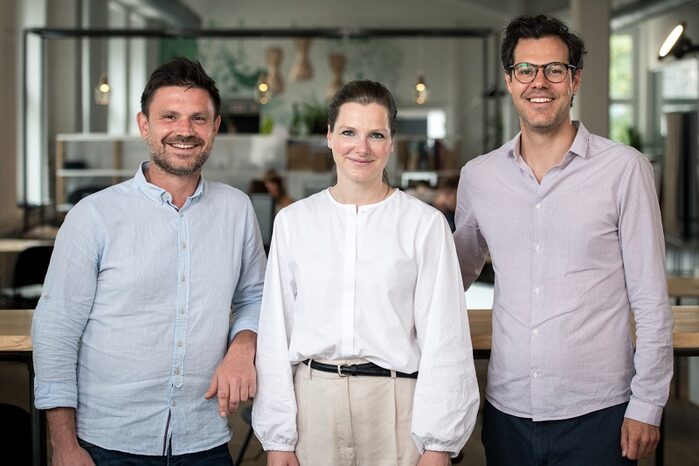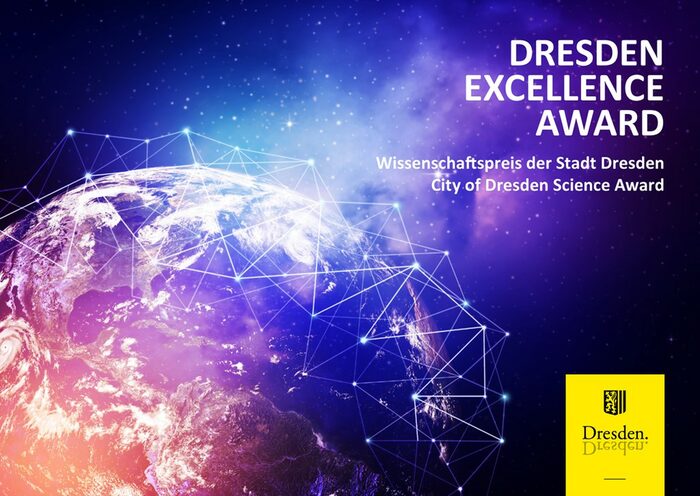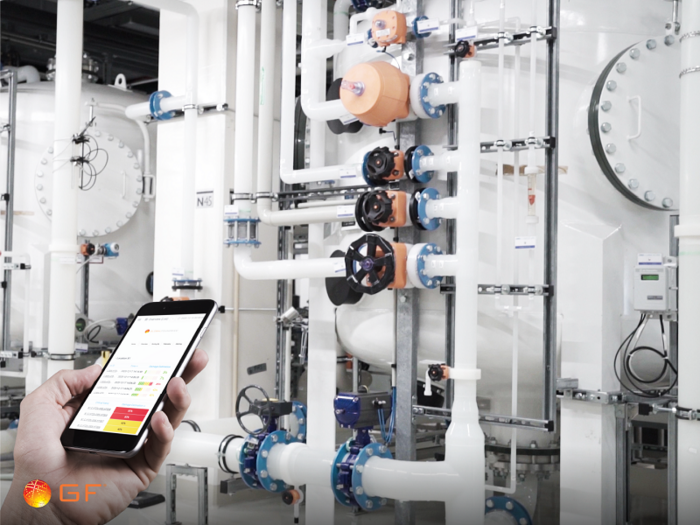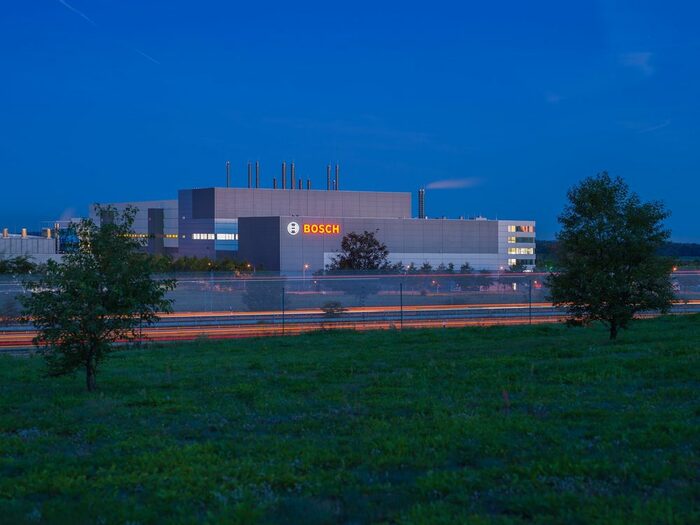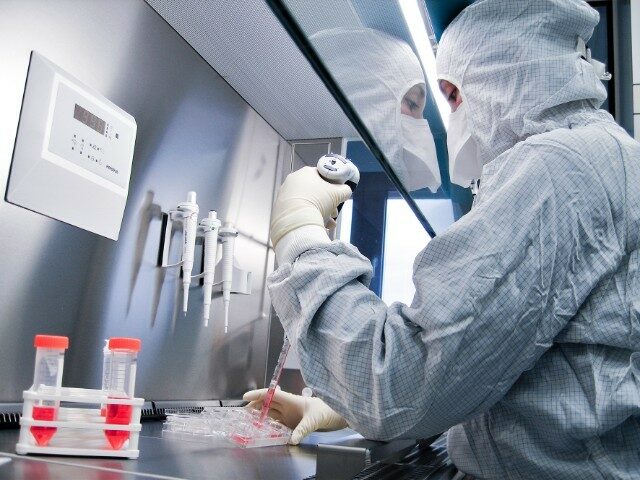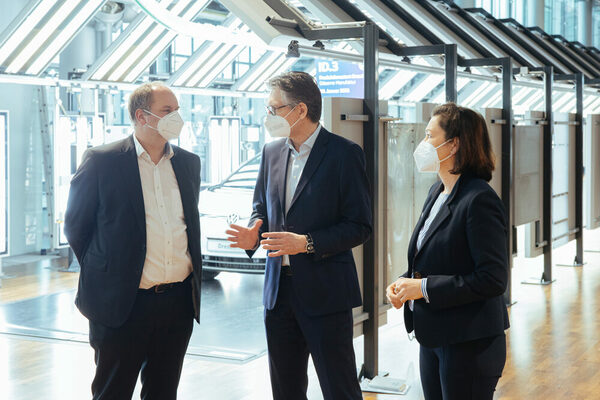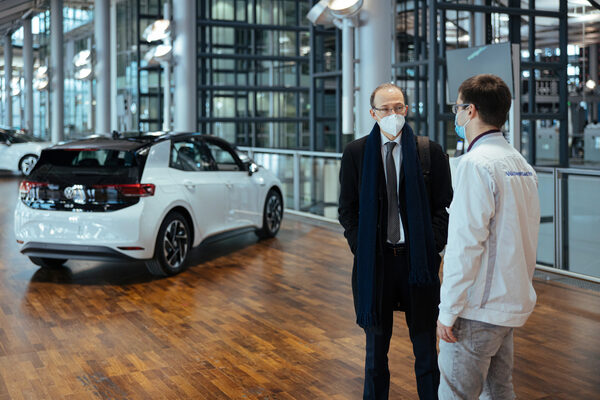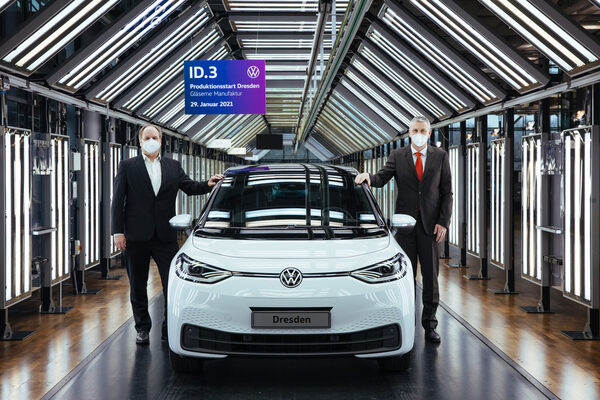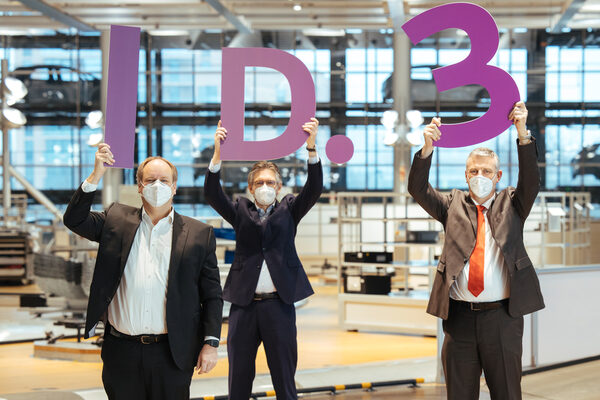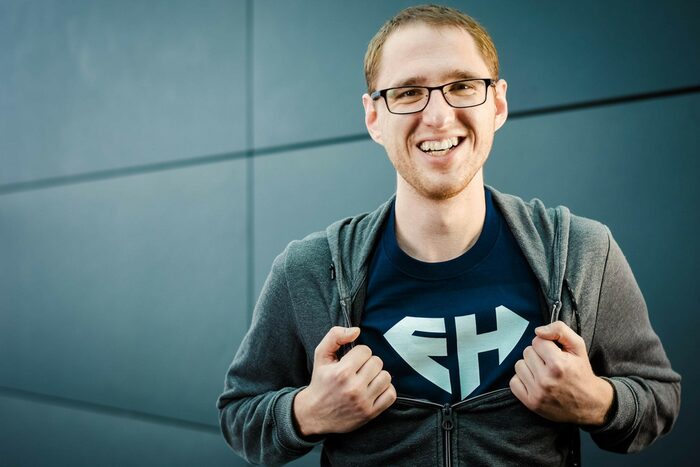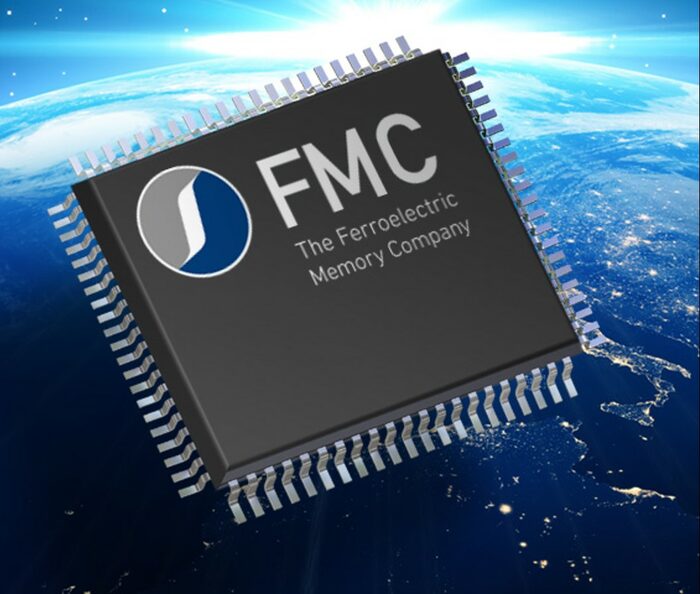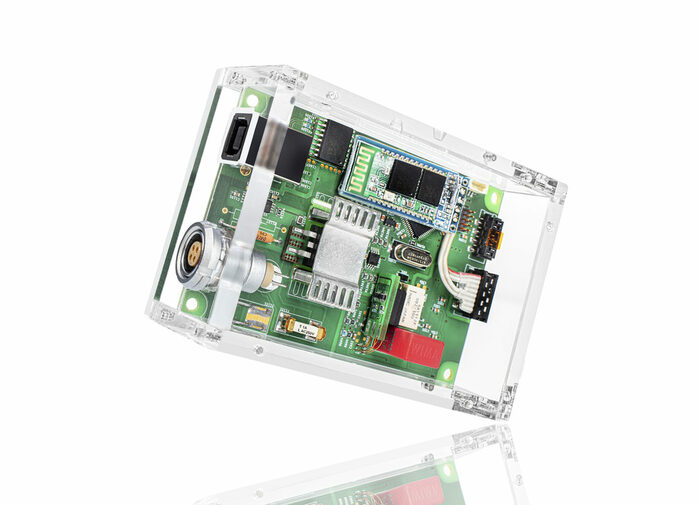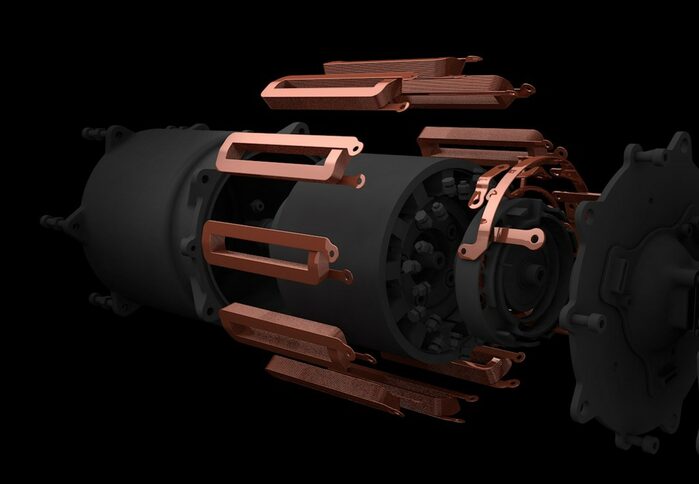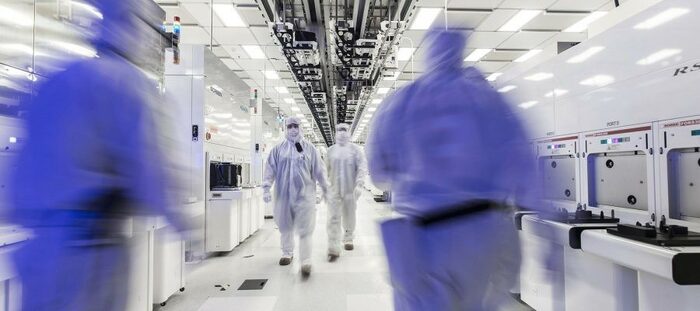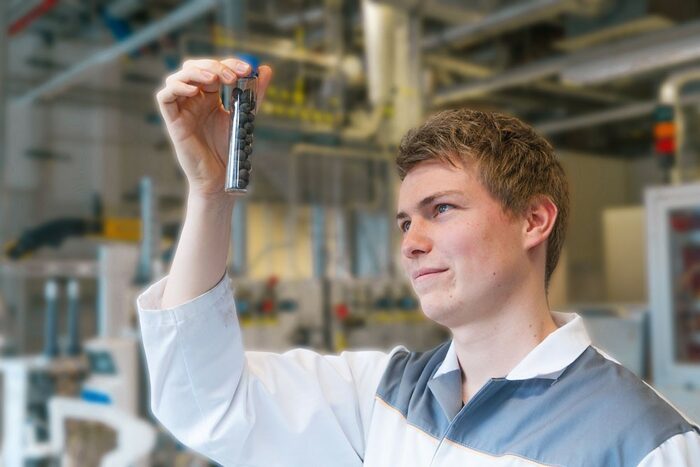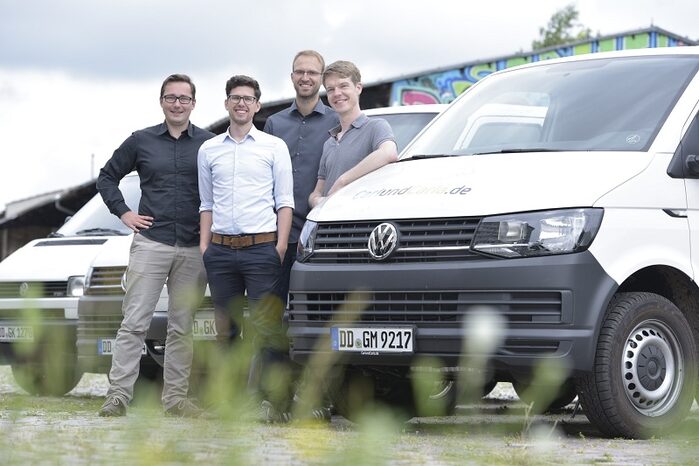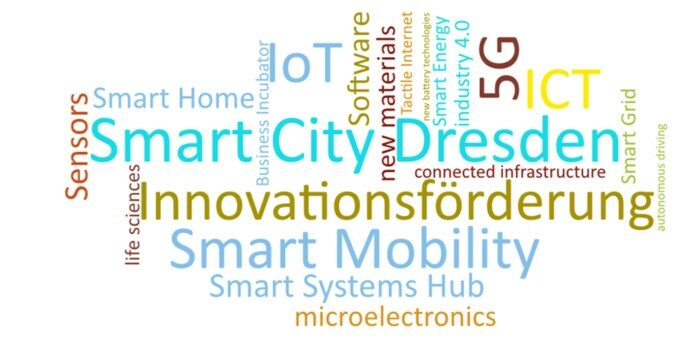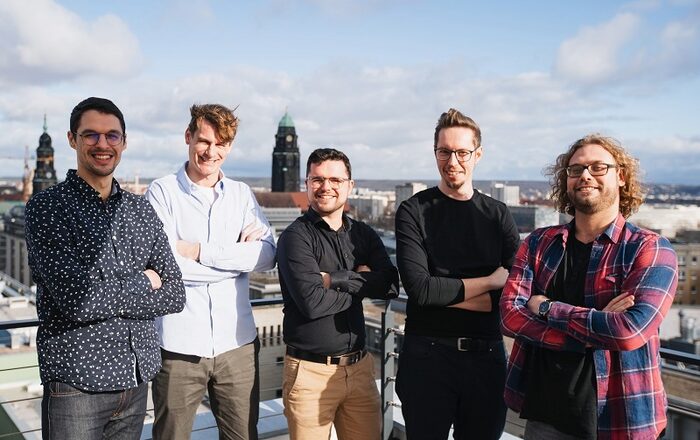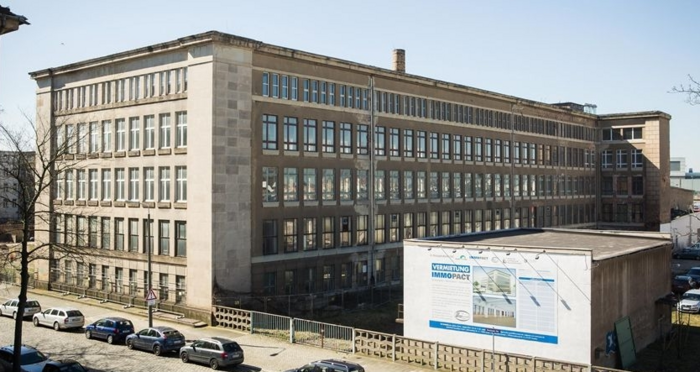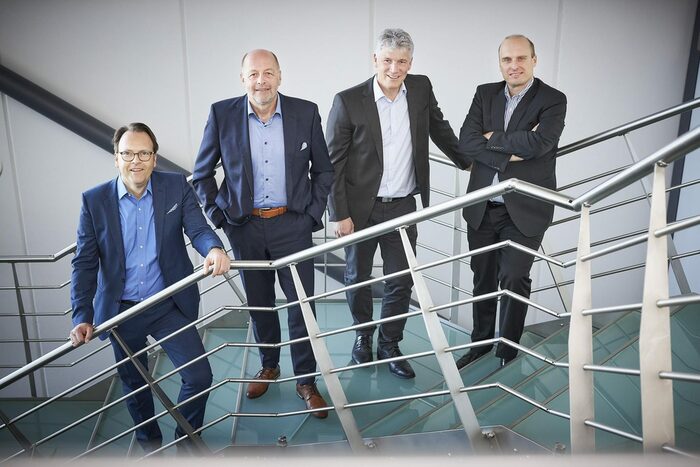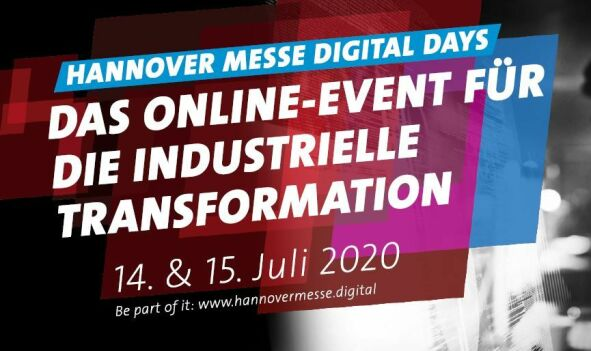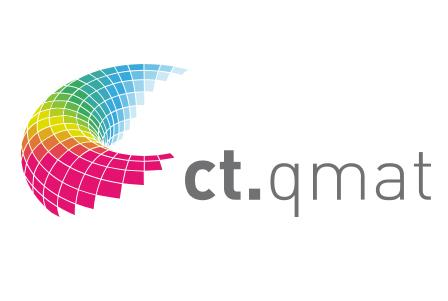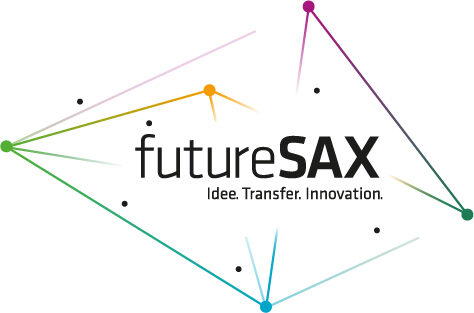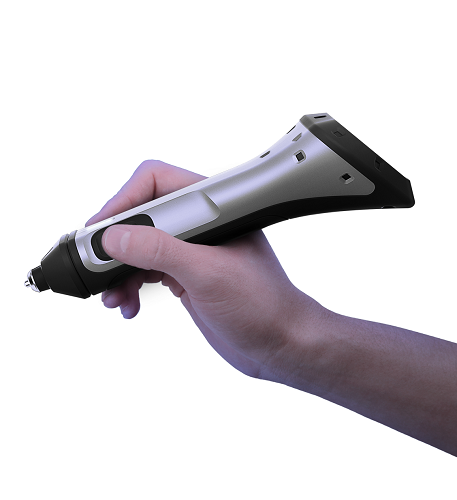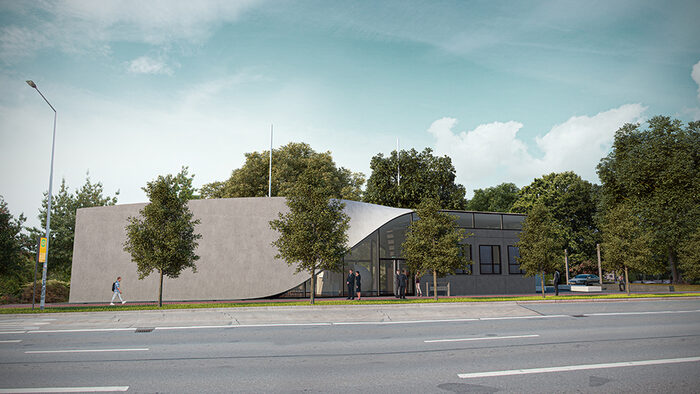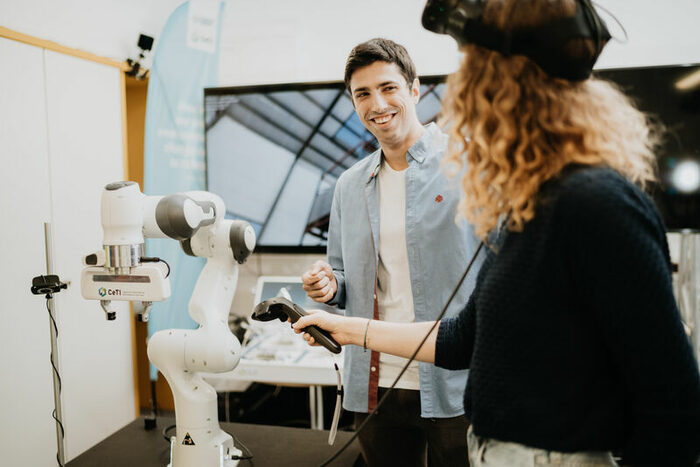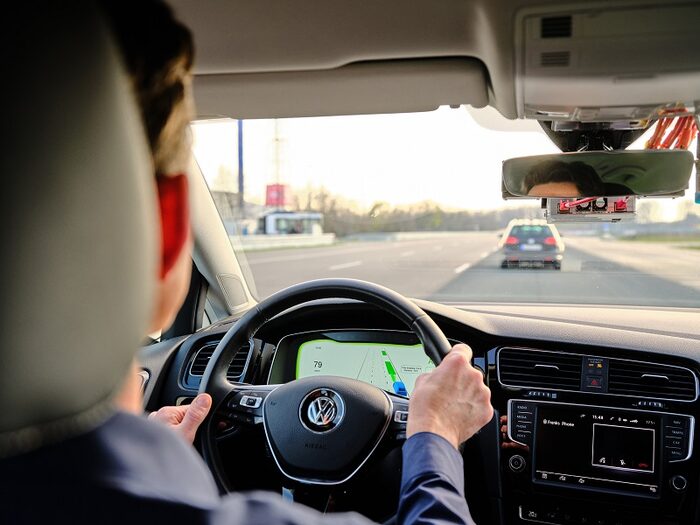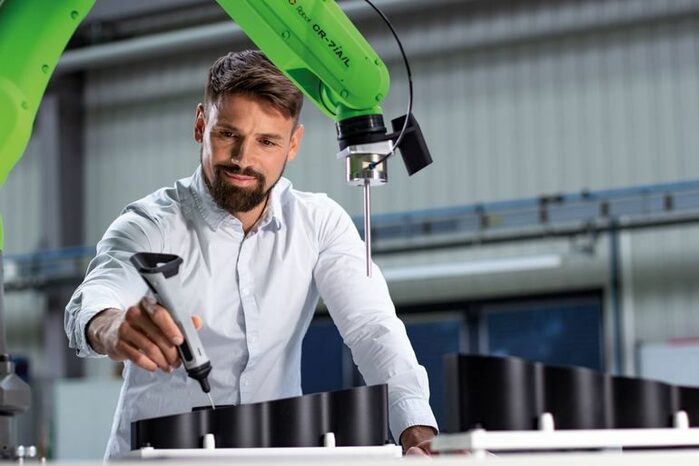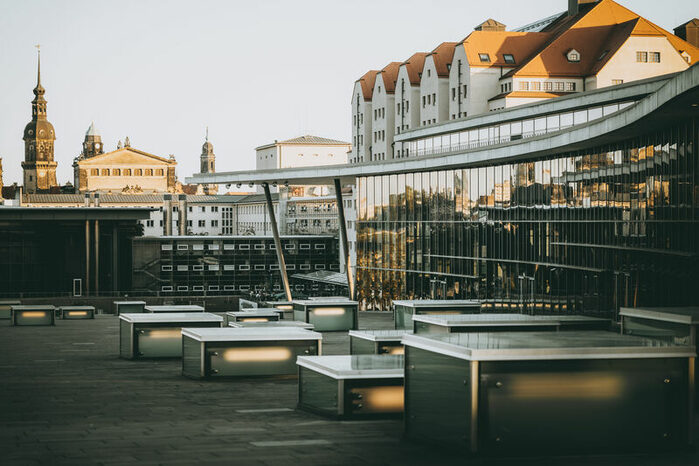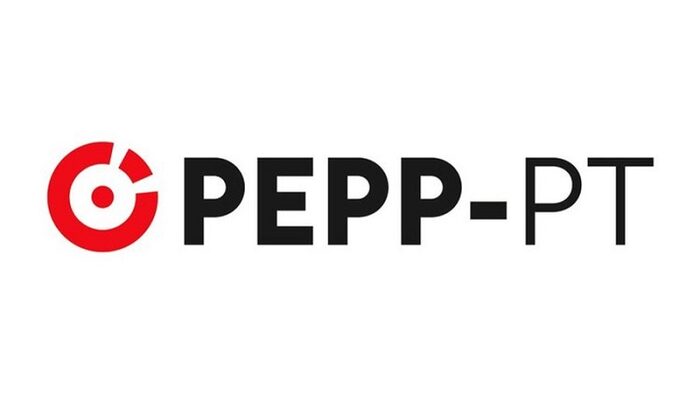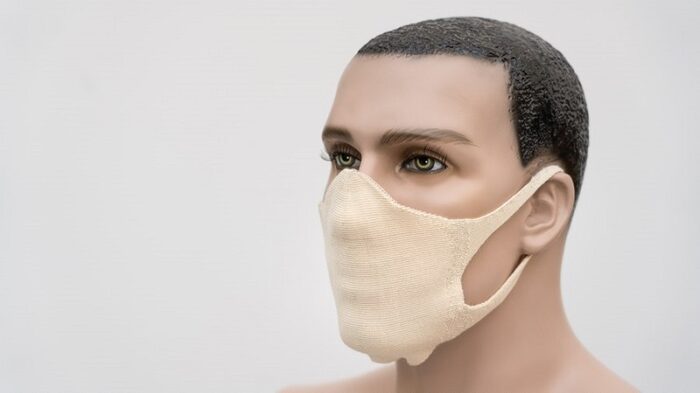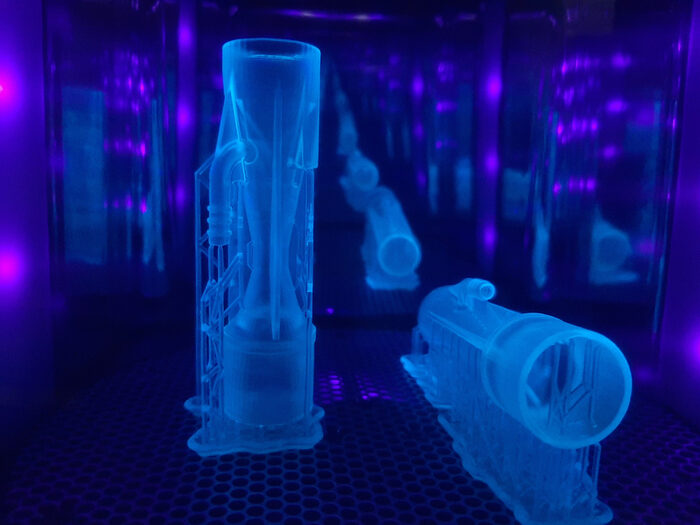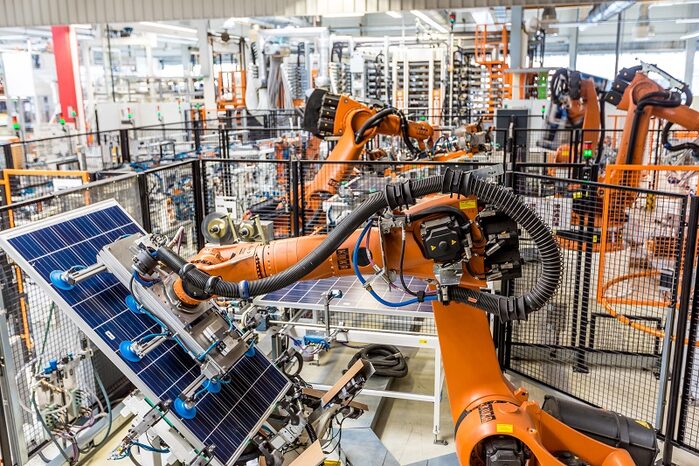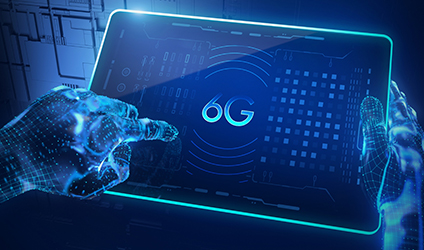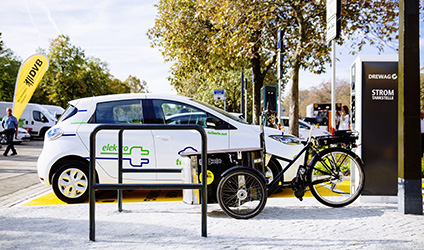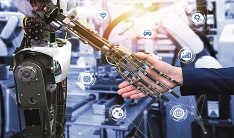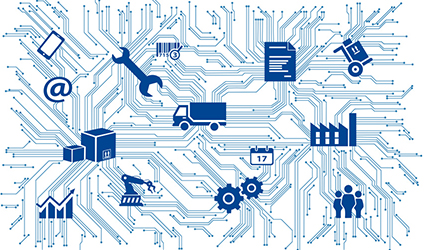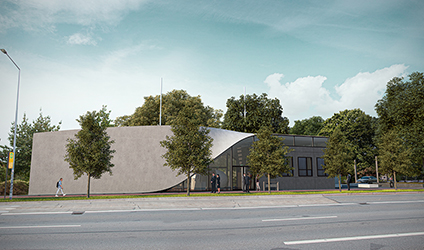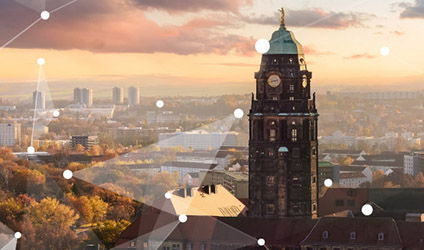|
Landeshauptstadt Dresden - www.dresden.de https://www.dresden.de/en/business/tomorrow-s-home/news-archive.php 27.01.2025 11:55:05 Uhr 22.04.2025 04:33:59 Uhr |
|
News-Archive
December 21, 2023 | For climate protection and science: „Soil of the Year“ 2024 lies in Dresden forest.
After arable soil or mudflats in previous years, the choice for "Soil of the Year" in 2024 fell on the forest - and on Dresden: the soil from Tharandt Forest was chosen to represent the great diversity of the 11.4 million hectares of forest in Germany. This is because it provides important data for climate research and sustainable forest management. It serves as an "open-air laboratory" for the forestry sciences at TU Dresden and provides deep insights: Through freely accessible pits, it offers insights into the usually hidden underground part of the forest ecosystem.
The forest floor - which exists in countless different forms - is a real all-rounder: its importance for humans, animals, plants and the climate is enormous. More organisms live in a handful of soil than there are people on earth, it is a greater carbon store than vegetation, absorbs heavy rainfall and thus contributes to flood protection. And it is the largest freshwater reservoir in Germany.
The soil in the Tharandt Forest serves as an „open-air laboratory“ for the forest sciences at the Faculty of Environmental Sciences at TU Dresden. It is also part of a soil nature trail that the soil scientists at TU Dresden have created on behalf of the Saxon State Office for the Environment, Agriculture and Geology (LfULG). Here, visitors can take a look beneath the surface of the forest ecosystem in six soil profile pits. Several display boards provide information about the soil, the plants rooted in it, the geology of the Tharandt Forest, the regional climate and climate development. Several degree programmes at TU Dresden, TU Bergakademie Freiberg and other universities use the soil nature trail. Extensive analysis material is available for this purpose.
„High-resolution information on the nature of the ground cover is indispensable for sustainable forest management, especially in changing climatic conditions,“ explains Prof Karl-Heinz Feger from the Institute of Soil Science and Site Ecology at TU Dresden. „But soil data is also essential for complex calculation models, for example for deriving climate change scenarios and planning corresponding adaptation measures. The basis for this is still a precise soil description and targeted sampling in the field.“
Federal Minister of Agriculture Cem Özdemir is the patron of the „Soil of the Year“. On this year's World Soil Day, 5 December 2023, the Federal Ministry of Food and Agriculture (BMEL) solemnly declared forest soil to be Soil of the Year 2024.
More information
December 11, 2023 | Strong together: Eleven Saxon cooperation partners for „Future Mobility“
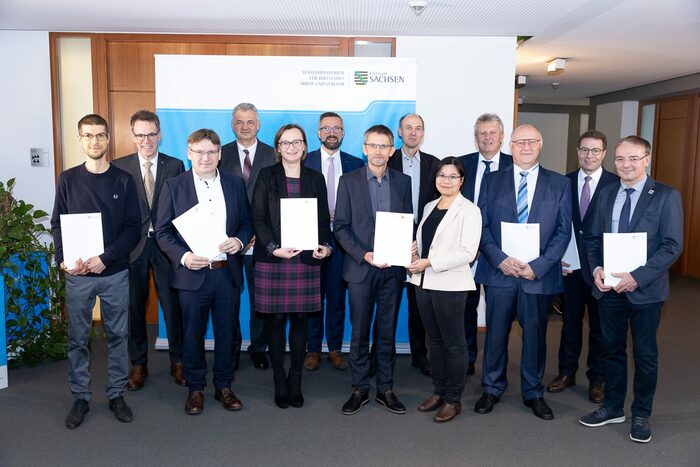
Being faster on the market and working more energy-efficiently – that is the goal: in future, Dresden will join forces to work on technologies for „Future Mobility“. Semiconductor manufacturer Infineon, three medium-sized companies and seven research institutions from Saxony have joined forces for the research and development project „Green Mobility 'made in Saxony' - Innovative solutions for future-oriented automotive and industrial applications“. The project is now starting its work.
The results for green mobility "made in Saxony" are to be incorporated into automotive and industrial applications - for example through significantly more efficient and functional microcontrollers for cars. Due to the increasing digitalisation of car mechanics, these are becoming more and more in demand. The new technologies from Saxony should not only help to save energy in the future, but also resources thanks to increased functionality and a longer service life. They will therefore make an important contribution to climate protection.
The project is also researching new technology concepts to enable the development and manufacture of these semiconductor products with the highest quality and reliability. This makes the production process more controllable - and therefore more sustainable. Ultimately, the aim is to find solutions for manufacturing the electronic components that are so sought-after by the automotive industry in high quantities, with excellent quality and under attractive working conditions in Saxony, which will enhance the value of the business location.
„Cooperation between important stakeholders from research and industry in Saxony to create innovative semiconductor solutions is of great importance for the business location," says Martin Dulig, Saxon State Minister for Economic Affairs, Labour and Transport. „The work of the partners in the joint research project is an important building block for the next innovations 'made in Saxony'. The project results will form the basis for future-oriented products that improve people's quality of life and contribute to achieving climate targets."
The project is funded by the EU and the Free State of Saxony. Following the symbolic handover of the funding decisions totalling around 17.7 million euros for three years, the project can now really get underway. Although the funding decisions had already been available since the end of October, the official go-ahead has now been given with the ceremonial handover.
In addition to Infineon, the project partners include the Dresden companies Fabmatics GmbH and SYSTEMA Systementwicklung Dipl.-Inf. Manfred Austen GmbH, LEC GmbH from Eibenstock as well as Chemnitz University of Technology, Dresden University of Technology, Dresden University of Applied Sciences, Zwickau University of Applied Sciences, Helmholtz Centre Dresden-Rossendorf, the Fraunhofer Institute for Photonic Microsystems Dresden and the Fraunhofer Institute for Material and Beam Technology IWS Dresden.
More information
Saxon State Ministry of Economic Affairs, Labour and Transport
December 5, 2023 | Sustainable building: Dresden and Saxony lead the way
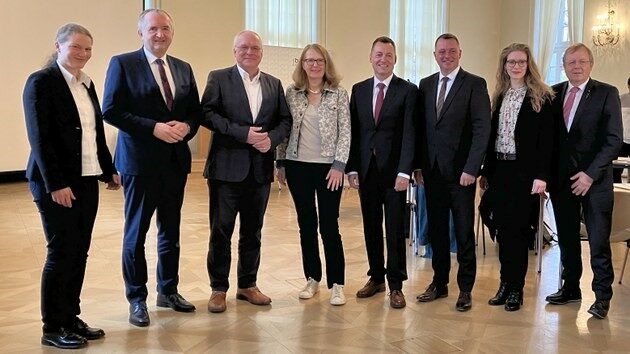
Construction and climate protection: do they go together? The figures are sobering: the construction industry accounts for more than a quarter of global CO2 emissions. It also accounts for a whopping 40 percent of global energy consumption. In Germany, construction waste accounts for almost 60 percent of the annual waste volume. High time for innovative concepts for sustainable construction! The “Living Art of Building” (LAB) research center, initiated by the TU Dresden, will soon be developing such concepts. The LAB is to be based in Bautzen and set up at various locations across Germany.
The multi-year development of the LAB is set to begin in 2024. Through intensive basic research into climate-neutral and resource-efficient construction, solutions and ideas for the development of new materials, technologies and processes are to be found on a large scale. “Research at the LAB can create technology leadership from Germany for new construction,” says initiator Prof. Manfred Curbach from TU Dresden. “If you want to have a positive impact on climate change, you have to start with construction.”
In the future, a total of around 1,250 employees from science and technology will conduct research and development in laboratory facilities that are unique in the world. Close cooperation with industry will create up to 40,000 jobs in and around the LAB in the long term. All interested parties throughout Germany who can contribute the necessary expertise and resources can participate. The aim is also to cooperate with strong partners from science and industry across Germany, Europe and worldwide.
Since 2021, the LAB concept has been developed by a multidisciplinary team of experts. In addition to Prof. Curbach, the team includes Jan Wörner, President of acatech, Dr. Birgit Beckmann from TU Dresden and Prof. Edeltraud Günther and Franziska Stölzel from the United Nations University.
The Budget Committee of the German Bundestag recently decided to provide a total of 3.6 million euros for the establishment of the LAB in the 2024 federal budget. For the following four years, up to 65 million euros have also been anchored as so-called commitment appropriations. In addition, the districts of Bautzen and Görlitz have pledged to make up to 450 million euros of their structural change funds available with the help of the cities and municipalities.
More information
November 21, 2023 | When do algae grow best - and how loud do ship engines roar? The Dresden "Minilab" finds out!
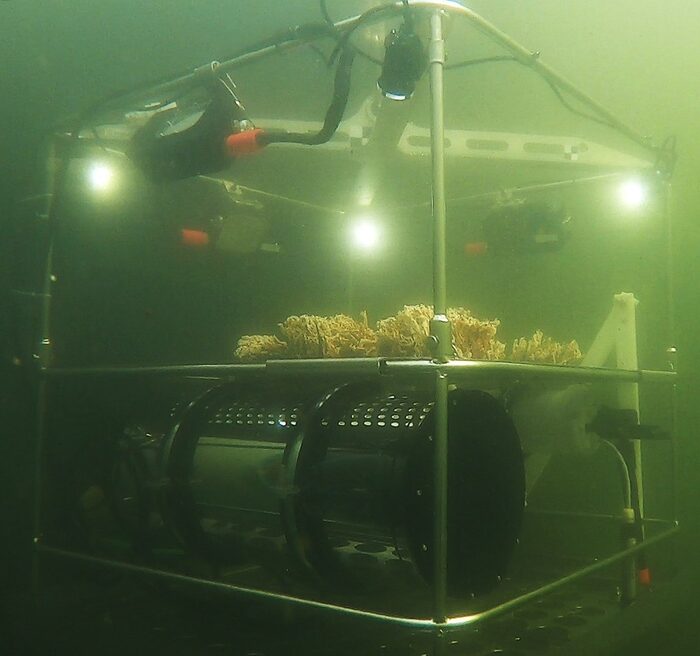
A major appearance for innovative power from Dresden at the Baltic Sea this week: the Fraunhofer research group Smart Ocean Technologies (SOT) presented the “Minilab” service and test platform at the “Rostock Ocean Convention”. The mobile underwater laboratory was successfully tested under the leadership of the Dresden-based Fraunhofer Institute for Ceramic Technologies and Systems IKTS. It can be used in a variety of ways at depths of up to 100 meters in lakes, rivers and oceans - from testing new coatings for ship hulls or monitoring ship noise to monitoring algae cultures for the green smoothies of tomorrow. And it helps to bring innovative future technologies to market more quickly.
How long does it take for algae, sea snails and small crustaceans to colonize the fresh underwater paint on a yacht? How do underwater ecosystems react to new offshore constructions? Important questions like these can now be answered quickly and easily with the help of the “Minilab”.
The underwater laboratory consists of an open tubular steel construction with basic sensor equipment that can be flexibly equipped with samples and other sensors and measuring devices. Thanks to an edge length of only around 70 centimeters, it can be easily transported by car. It is equipped with four cameras and a temperature and pressure sensor as well as various sensors. It can use these, for example, to determine whether a body of water is acidic or alkaline, how high the oxygen content or UV radiation is. The energy required for this still comes from land via a power line and the recorded data is also sent by cable to an electronic measuring case above the water. “However, we are already planning a self-sufficient follow-up solution,” reveals SOT research group leader Dr. Kathrin Baumgarten. The laboratory will be powered by batteries in a buoy. The recorded sensor data is then forwarded directly to a mobile router in the buoy.
Due to the many possible applications, the “Minilab” is not only interesting for sensor manufacturers and developers of new underwater materials, but also for aquatic farmers, for example. In view of climate change, population growth and changing eating habits, attempts are now also being made to produce sugar kelp and edible large algae in the Baltic Sea. These algae cultures are used to the cooler temperatures of the world's oceans. The “Minilab” could monitor the water temperature and other vital parameters to ensure that such green settlements succeed. “We bring the samples and equipment to be analyzed into the water for our partners,” says Baumgarten. “This helps them to bring innovations to the market more quickly.”
November 9, 2023 | Fraunhofer IKTS from Dresden presents innovative technology for shorter root canal treatments
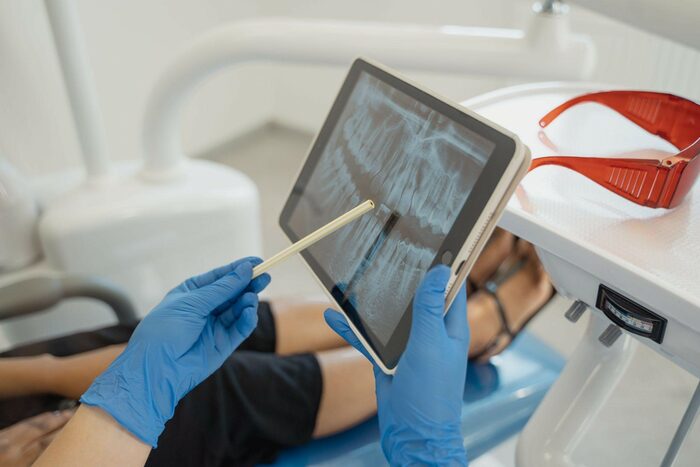
Root canal treatments are one of the most unpleasant things we can expect at the dentist: Painful and almost always lengthy. Researchers at the Fraunhofer IKTS in Dresden have now discovered how the file, which penetrates deep into the root canal, does not stick so quickly, thus speeding up the treatment. A huge relief for dentists and a blessing for patients! Next week, IKTS will be presenting the innovative technology, which is based on the special material piezoceramic, at COMPAMED in Düsseldorf.
When deep-seated caries and inflammation have attacked the tooth roots, root canal treatment is usually unavoidable. The doctor then opens the tooth to remove inflamed tissue. The problem is that the rotating file used for this has to be constantly cleaned in between. Researchers at the Fraunhofer Institute for Ceramic Technologies and Systems IKTS in Dresden have now developed a tiny piezoceramic stack actuator as part of the joint research project “IPUCLEAN”, which means that the file no longer sticks so often and the treatment ends more quickly.
In so-called stack actuators, several layers are placed on top of each other and interconnected. This enabled the scientists to design the device so small that it can still be moved easily in the confined space of the oral cavity.
Piezoceramics are ceramic materials that exhibit a so-called charge separation as soon as they are deformed by an external force and this is precisely what the Dresden team is taking advantage of: The rotation of the file is superimposed by an oscillating movement, so the file rotates and oscillates at the same time.
“By superimposing the rotation with an axial oscillation, the file becomes clogged less quickly,” says Dr. Holger Neubert, Head of the Intelligent Materials and Systems department at IKTS. “The dentist can concentrate much better on the already difficult work in the root canal. The risk of file breakage is also reduced.”
The company Gebr. Brasseler GmbH & Co. KG was the coordinator of the project, which was funded by the German Federal Ministry of Education and Research (BMBF). Doctors from the Faculty of Dentistry at the University of Rostock have already tested the technology on plastic teeth and have given positive feedback!
The technology can also be used for other medical applications, for example in diagnostics or cancer treatment. “Piezoceramic components enable a wide variety of different applications and are attractive for medical technology due to their compactness and performance,” says Dr. Neubert. “We are able to develop individual solutions for customers that are tailored to their specific needs.”
From November 13 to 16, Fraunhofer IKTS, which is a leader in working with piezoceramic materials, will be presenting its innovative technology for shorter root canal treatments – and the further potential of piezoceramic technology – at the COMPAMED medical technology trade fair in Düsseldorf.
More information
November 9, 2023 | Impulses for green energy: 3D printer unique in Europe in Dresden

Combustion chambers for hydrogen energy systems or blade wheel enclosures for turbines: These and other complex components made of metal are the specialty of the new 3D printer at the Fraunhofer Institute for Material and Beam Technology (IWS) in Dresden. Thanks to a special layering process, it produces large components with complicated geometry in a short time. This makes it unique in Europe - and opens up great opportunities, especially for medium-sized companies.
Additive manufacturing is becoming increasingly important. This is a particularly innovative and resource-saving manufacturing process: Unlike conventional methods, in which material is removed - comparable to the sculptor's block - here material is added step by step. Exemplary for this process is 3D printing.
Now the Fraunhofer IWS in Dresden has installed an industrial 3D printer that is unique in Europe. The manufacturing system is based on selective laser beam melting in a powder bed. In this process, a laser beam melts fine metal particles. From this melt, the system creates the desired component layer by layer according to a computer model. Components made of titanium, copper and other metals or their alloys can be produced in this way.
The special feature of the new IWS 3D printer is that it can also produce large and complex components - volumes of up to 62 by 62 by 110 centimeters are possible. This opens up great opportunities for SMEs: "With this kind of system technology, SMEs in eastern Germany can develop special unique selling points with the help of the Fraunhofer IWS," emphasizes institute director Prof. Christoph Leyens. The state-of-the-art plant also plays a key role in the "SpreeTec next" project. It is to contribute to the development of new manufacturing processes and value chains.
"SpreeTec neXt," initiated by the Brandenburg University of Technology Cottbus Senftenberg (BTU) and the Fraunhofer-Gesellschaft, sees itself as a bridge between industry and research to help small and medium-sized companies in the plastics and metal processing industries make the transition to green energy technology. By 2029, the project partners want to establish an innovation center in Lusatia for this purpose and provide advice on the use of advanced technologies related to additive manufacturing. The German Federal Ministry of Education and Research (BMBF) is funding these specific subtasks of "SpreeTec neXt" with five million euros each.
More information
October 27, 2023 | New surgical robot "HUGO RAS" consolidates Dresden's status as an important smart health location.
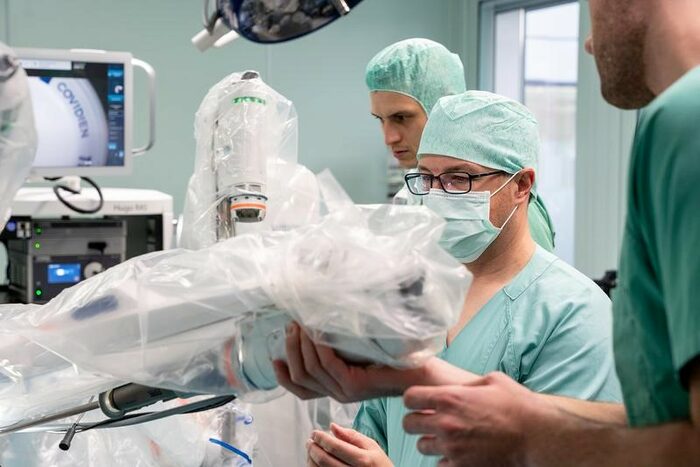
German premiere in Dresden: At the University Hospital Carl Gustav Carus (UKD), the robot HUGO RAS has performed a urological operation for the first time. It is a new member of the UKD's robotics park, which also includes three Da Vinci models. This creates the best conditions for setting up a versatile range of therapies. The new "Robotic diversity" also makes the UKD an even more attractive place for research and teaching.
An incision no larger than a keyhole: Minimally invasive surgery is characterized by its gentle handling of the body. In recent years, the technique has undergone rapid development. The main drivers are new technologies, especially high-end surgical robots.
One of the most advanced in the evolution of these devices is the HUGO RAS, where RAS stands for "robotic assisted surgery". It has been part of the UKD's impressive robotics park since recently and was put to the test right away: it was the first HUGO in Germany to perform a urological operation. The patient was a 78-year-old man whose prostate had been reduced in size.
The UKD already had three Da Vinci surgical robots before the arrival of the high-end robot. Both the HUGO and the Da Vinci consolidate Dresden's position as a major location for care, research and teaching. For patients, the various robotic systems open up new opportunities. Depending on the findings, the surgical teams can choose between the two systems.
The HUGO has four highly individually adjustable arms and an open console. This allows the surgeon to work close to the patient and in the middle of his team. The device also ensures a better view of the overall scene in the OR. By comparison, the four arms of the Da Vinci surgical robot are operated via a separately standing console away from the operating table. Both systems enable minimally invasive and thus gentle interventions.
"The new robotic system takes Dresden University Medical Center to a new surgical level," says Saxony's Minister of Science Sebastian Gemkow. Prof. Michael Albrecht, Medical Director at the University Hospital, is also excited about being able to offer the "two most highly developed robotic systems" under one roof: "This is an enormous advantage when it comes to attracting employees to us." Prof. Christian Thomas, Director of the Clinic and Polyclinic for Urology, gives the specific reasons for this. In the future, for example, he says, they want to offer training in the use of the Hugo and conduct research with AI. "Robotic diversity at the university hospital should ensure that modern minimally invasive surgery is not automatically associated with a manufacturer in the future," says Prof. Thomas.
UKD staff in abdominal, lung and vascular surgery will also benefit from the support of both robotic systems in the future. In addition to clinical use, the device will also be used scientifically. Patients can be included in studies and treated accordingly.
More information
October 23, 2023 | Dual-ion technology with Dresden participation as a game changer?

Balcony power units are booming – not least because bureaucratic hurdles are currently being removed for private energy generation in miniature power generation. However, the question of how to store surplus electricity has not yet been answered satisfactorily. This is where dual-ion batteries (DIBs) as rechargeable stationary energy storage devices come into play. With the participation of Dresden's Fraunhofer IKTS and TU Dresden, the novel technology is now being made fit for industrial application.
With these small power units, tenants and property owners can easily produce solar power – much more cheaply than with rooftop photovoltaic systems. But how can unused electricity in the home be stored in a cost-effective and environmentally friendly way?
The answer could be a real game changer: Emerging dual-ion technology. Unlike previous lithium-ion storage systems, this technology uses graphite and materials available in Germanyrather than environmentally harmful and expensive metals such as nickel or cobalt. Their charging and discharging process is also faster. Dual-ion batteries thus promise lower costs, more safety, greater independence - and above all: more sustainability! However, research to date has focused on the production of laboratory cells. Industrially relevant cell formats have remained largely unexamined.
The "TransDIB" project (Development and Transfer of Cost-efficient, Sustainable and Safe Dual-Ion Batteries for Stationary Energy Storage Solutions) now aims to improve the industrial transfer of this battery cell technology. To this end, the project partners intend to produce prototypes on a pilot plant for lithium-ion batteries. The planning of industrial cell production for DIBs is to be based on this, so that graphite electrodes can later be produced on a large scale.
To this end, partners from industry (VARTA Microbattery GmbH, SGL Carbon GmbH, E-LYTE Innovations GmbH, Sixonia Tech GmbH) and research (Dresden University of Technology, Fraunhofer Institute for Ceramic Technologies and Systems IKTS, Westphalian Wilhelms University Münster) are working hand in hand on the project. “TransDIB” runs from February 2023 to January 2026 and is funded by the German Federal Ministry of Education and Research with 2.3 million euros.
More information
October 19, 2023 | Biotype analysis device from Dresden revolutionizes cancer therapy and forensics
Precision medicine is currently creating a new industry of the future - and Saxon companies, hospitals and research institutions are leading the way. One of them is the biotech company Biotype from Dresden. The improved version of its Modaplex analysis device is now paving new paths - both in cancer therapy and in tracking down criminals.
Dresden is increasingly becoming the most important hotspot and driving force in precision medicine. It is already one of the top three locations in Germany in terms of artificial intelligence and data expertise - two key technologies for the development of state-of-the-art diagnostic procedures.
A key player in this field is Dresden-based biotech company Biotype, which is setting new standards in the analysis of blood samples with Modaplex. It has now launched an improved version of the procedure: the table-sized device enables individualized treatment methods for cancer patients. Blood samples are fed into the device. Small biomarkers then evaluate the results and design personalized therapies.
In less than four hours, the automated workflow of the Modaplex platform delivers fast and accurate results. In this time, the decision-relevant RNA and DNA biomarkers are measured simultaneously from one sample. On this basis, the best possible therapy can be initiated. Biotype thus makes a significant contribution to relieving the burden on the healthcare system.
However, the device is not only suitable for the treatment of cancer patients, but is also used in forensics: Thanks to the technology, tissue, blood or urine can now be used to determine precisely whether or not a crime suspect was present at the scene of the crime. On the one hand, this opens up new opportunities for prisoners who may have been convicted in error to be pardoned. On the other hand, cases that have already been closed and not uncovered can be taken "out of the fridge" and reopened with the help of the Modaplex.
More information
October 5, 2023 | Membranes for climate-neutral waste incineration from Dresden
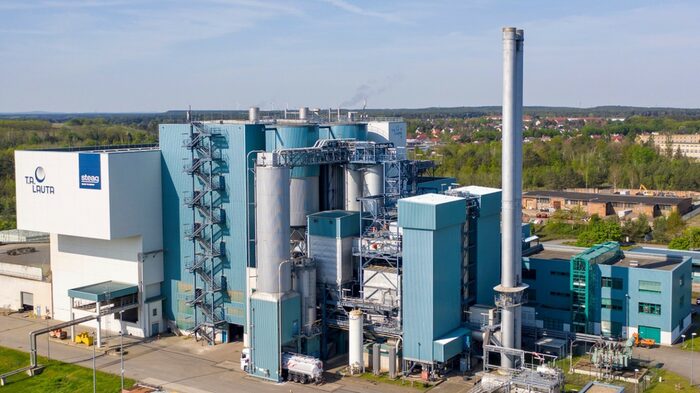
Worldwide, 280 million tons of waste are incinerated every year. In many countries, energy is generated from the resulting heat. The problem is that the resulting flue gas contains climate-damaging carbon dioxide (CO2). The joint project “KlimProMem”, coordinated by Fraunhofer IKTS in Dresden, therefore aims to separate the CO2 from the flue gas in order to use it for production in the basic materials industry. An innovative membrane technology is used for this purpose.
The “KlimProMem” project focuses on the further development of climate-neutral processes in the basic materials industry, i.e. those areas of industry that extract basic materials and prepare them for further processing. For these, the project participants are testing membranes, plant and process concepts to enable the climate-neutral production of important basic materials.
In this case, special carbon membranes are being developed for separating CO2 from flue gas at Fraunhofer IKTS in Dresden and scaled up for large plants. The special feature: To make the process as energy-efficient as possible, geothermal energy is being combined for the first time with energy-efficient membrane distillation – a thermally driven separation process. The principle is to be tested at two waste incineration plants.
Compared to the polymer membranes usually used in this process, carbon membranes offer more favorable chemical and mechanical stability. They can be used in the project to test the further processing of the separated CO2 into soda, soda ash or other products by means of electrochemical membrane processes. Soda and soda are basic chemicals that are used in many areas of industry and everyday life (e.g. glass production, cleaning agents, water treatment).
In addition to the Dresden Fraunhofer IKTS as coordinator, “KlimProMem” involves E.S.C.H. Engineering Service Center und Handel GmbH, Vulcan Energie Ressourcen GmbH and the CIECH Group. With IQONY GmbH and PreZero Energy, the field trials are being carried out at waste treatment plants in Lauta (Saxony) and Zorbau (Saxony-Anhalt). The German Federal Ministry of Education and Research (BMBF) is supporting the project with around 1.5 million euros over three years.
More information
September 28, 2023 | Dresden-based start-up “HolyPoly” expands and plans recycling pilot plant
The Dresden-based start-up “HolyPoly” for innovative plastics recycling has been growing for three years. Now the company is planning a so-called “closed-loop factory” and wants to finance it with a crowdinvesting campaign. Through the recycling pilot plant, the Dresden-based company wants to further expand its competitive advantage.
HolyPoly develops ideas, concepts and processes to fully exploit the potential of recycled plastics: recycling thus creates high-quality products with high utility value and good market opportunities. The start-up's team brings a broad range of expertise to the table in all relevant disciplines, from product development and material selection to sustainable design and manufacturing, logistics and marketing.
This has made the young company so successful that it is now expanding: A planned production and research center will provide enough space and comprehensive equipment for the upcoming projects. In the closed-loop factory, new plastic recycling cycles are to be developed on an industrial scale. Closed-loop manufacturing is understood as a closed manufacturing and measurement process for an entire value chain in which new data sources collaborate and are connected.
HolyPoly is also breaking new ground in financing the 750,000-euro investment by relying on crowdinvesting. Whereas the company had still been financing its first two rounds by acquiring larger investment sums, investors can now also participate with smaller amounts starting at 100 euros. A corresponding campaign will start in the first week of November.
“When we started three years ago, we would not have expected that we would already realize such extensive projects for renowned brands such as Mattel or Bosch,” says HolyPoly Managing Director Fridolin Pflüger. “But the spectrum of our service offering is obviously unique and the demand for individual recycling solutions very high.”
The first machines are scheduled to start up in the closed-loop factory this year. The modern hall will then be able to accommodate prototype production, test procedures, material analyses, recycling processes and sample production using the latest technology. The site will be opened as early as October 2, and Saxony's Prime Minister Michael Kretschmer has also announced his attendance.
“It is absurd how many high-quality materials from unused end-of-life products will be destroyed in our waste systems even in 2023 and how old-fashioned recycling still is,” says Fridolin Pflüger. “This has to change, and we are starting to do it at this site.”
More information
September 22, 2023 | Is magnesium the key? IFW Dresden receives 1.5 million euros for further development of thermoelectrics?
When waste heat from large industrial plants is turned into electricity, the thermoelectric effect is behind it: two unequal temperature levels generate a voltage that enables current to flow and vice versa. This effect has been known for 200 years. And yet the development of the technology has stagnated for half a century. Among other things, because it requires the extremely rare element tellurium. With funding from the European Research Council (ERC), Dr Ran He from the Leibniz Institute is now doing everything he can to overcome this standstill - for example, by replacing tellurium with magnesium.
There is great potential in thermoelectric technology (TE). If you look at the use of industrial waste heat, for example, this becomes particularly clear: according to the UBA, Germany's central environmental authority, only seven per cent of district heating has been generated from it so far. Yet the theoretical potential of industrial waste heat is about 226 terawatt hours - which is significantly greater than the entire current district heating sales.
The problem: Until now, most heat-to-electricity converters have required the extremely rare element tellurium. It occurs in less than 0.001 parts per million in the earth's crust - which is why the development of the technology has stagnated for half a century.
Dr. Ran He from the Leibniz Institute for Solid State and Materials Research Dresden is researching the solution. As part of the TENTATION project (Tellurium-free Thermoelectric Technology for Near-room-temperature Applications), the physicist is working on the development of a new generation of thermoelectric modules - which are based on the abundant element magnesium instead of tellurium and are intended to surpass the performance of previous technology. This is because, until now, the efficiencies of thermoelectrics have been low compared to other methods of energy generation. "I am aiming to double the conversion efficiency to about 12 per cent," says Ran He, who has been at IFW since 2017. He has just received the "ERC Starting Grant" for his work from the ERC, a research grant worth 1.5 million euros.
Ran He has his sights set high - but if he actually succeeds in achieving his project goal, he will pave the way for sustainable energy generation and temperature regulation with a wide range of applications based on a long-known principle.
More information
September 19, 2023 | Gigantic direct current measurement facility: Dresden sets new impetus for energy transition
TU Dresden has commissioned a test facility for measuring direct current, the size of which there are only a few of its kind in Germany. Researchers want to use it to answer important questions about the power grids of the future. After all, by 2030, at least 80 percent of our electricity is to come from renewable energies - according to the German government's plan. This also involves converting the power grid from alternating to direct current. This poses special challenges for which solutions are now being developed in Dresden.
"Electricity highways": this is the name given to the cable routes that will supply Germany with green electricity in the future. Most of the electricity generated from the sun and wind will be generated in the windy north and east and in large offshore parks off the coasts. However, it is mainly used in the industrially strong southwest and south of Germany. Thick cables are needed to transport it several hundred kilometers across the country - and they are designed for direct current. This is because it is significantly more efficient than alternating current, can be transmitted without major losses, and is virtually predestined for large amounts of electricity and long distances.
The TU Dresden has its eye on the growing importance of direct current for the future of our power supply: Its high-voltage hall has recently been home to a gigantic measuring system that looks a bit like science fiction with its rings and spheres. It is a good eight meters high, generates voltages of up to 1.2 million volts and cost just under one million euros. The money comes from the large-scale equipment initiative of the German states, which is dedicated to financing large-scale equipment with outstanding, innovative technology.
With the help of the facility, Dresden University plans to significantly advance research in the field of direct current technology. "We are grateful that we now have this modern device at our disposal," says Stephan Schlegel, acting head of the Chair of High Voltage and High Current Technology. A former DC system from 1994 had become obsolete and was no longer suitable for current research questions. Now Dresden is one of the few research locations in the country where this possibility exists.
Various research tasks await Stephan Schlegel's team. One involves the cables that will be used for DC voltage in the future: "We are trying to understand physically what happens in the insulating layer of such a cable, for example," explains Schlegel. This layer is much thicker than, for example, in common underground cables for medium voltage. How big does the insulating body have to be? What happens during a lightning discharge? Problems like these can now be investigated with the new test facility. But Schlegel adds that it's not just about the cables, but about all the questions that arise around the technologies for direct voltage and direct current. Schlegel is convinced that precisely this knowledge will become increasingly important in the future: "Today, we have the technical possibilities to work much more with direct current than in the past."
Thanks to the new test facility, Dresden is now an important contact when it comes to tomorrow's energy supply.
More information
14 September 2023 | Research cluster with TU Dresden: think tank for sustainable recycling management

In the past, major burdens on the environment emanated from here. Today, the site is a meeting place for sustainable ideas for the future: The research cluster “CircEcon – Green Circular Economy” is being created in the “Schwarze Pumpe” industrial park, which is located in equal parts in Saxony and Brandenburg. Here, four universities are jointly developing new ideas for a greenhouse gas-neutral circular economy. The TU Dresden is also involved. The idea is to bundle expertise along the production chain - starting from materials to production and process technologies to recycling. The project is funded with 108 million euros by the federal government and the state of Saxony.
The Schwarze Pumpe industrial park in Lusatia is emblematic of the comprehensive transformation from formerly coal-based to renewable energy: what was once the world's largest gas and lignite distribution centre is to be transformed into a green industrial location in the coming years. An important component of this transformation is the circular economy, which plays a central role in the transformation of industry and society.
Now four universities and colleges want to pitch their tents here to establish a research campus for greenhouse gas-neutral recycling management that is unique in Europe. In addition to the TU Dresden, these are the Bergakademie Freiberg, the TU Chemnitz and the Zittau/Görlitz University of Applied Sciences. They have 108 million euros from the federal and state governments at their disposal for this purpose. The interdisciplinary working group wants to focus on the entire value chain from raw material extraction and processing to materials, processes and structures to reuse. The tools of choice: artificial intelligence, digitalisation, energy management and eco-hydrogen.
“Bundling the expertise of the universities and colleges leads to an outstanding pooling of know-how and technology,” says Prof. Ursula M. Staudinger, Rector of TU Dresden. “This allows groundbreaking solutions to be developed for the challenges of the circular economy and at the same time strengthens the region's competitiveness.” Prof. Alexander Kratzsch, Rector of the Zittau/Görlitz University of Applied Sciences, emphasises the project's “international expertise” that leads to “sustainable solutions”. “CircEcon transforms university know-how into industrial innovations and thus directly promotes economic growth,” explains Kratzsch.
The first important step was taken with the constituent meeting of the CircEcon steering committee. With the help of pilot lines, test facilities and demonstration systems, new ideas for a highly efficient circular economy are now to be developed, tested and brought to market maturity together with companies.
More information
August 30, 2023 | Lighting specialists from Dresden solve efficiency problem with OLED displays
Whether smartphone, tablet or television: OLED technology for displays is on the advance. However, it has a problem with the colour blue: the emitters used so far to produce the blue colour are not very efficient. The Dresden-based start-up beeOLED GmbH has now presented a deep blue emitter at the International Meeting on Information Display (IMID) in South Korea, one of the most important industry events, which could significantly reduce the energy consumption of displays.
The deep blue emitters currently used in OLED displays are either long-lasting (fluorescent emitters) or efficient (phosphorescent emitters). But there is no technology on the market that combines these two properties. It is true that the intra-metallic emission technology developed by the Dresden-based start-up beeOLED has proven high stability and high efficiency in other display technologies in the past. However, it could not yet be used in OLED displays - until now!
Because now, for the first time, the light specialists from Dresden have succeeded in making such molecules compatible with the vacuum manufacturing process used today in the large-scale production of OLED displays. The new deep blue emitters are significantly more efficient and will reduce the power consumption of smartphones, for example. BeeOLED's latest development could open up a billion-dollar market for itself.
More information
August 25, 2023 | Dresden company helps the energy transition in the power grid achieve a breakthrough
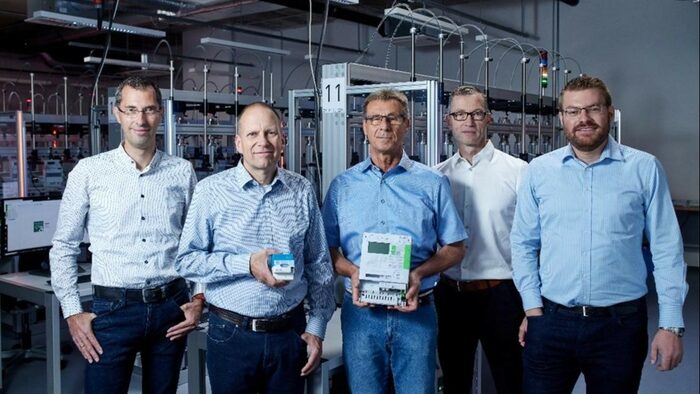
For the energy transition to move forward, smart metering systems for electricity are crucial. Such digital meters, called smart meters, can already be found in some private households. The economy, on the other hand, still has some catching up to do. But this may soon be satisfied - thanks to an innovation from Saxony: the Dresden-based Robotron Datenbank-Software GmbH, in cooperation with other partners, has successfully tested digital meters for industry, commerce and large generation plants.
Approximately three quarters of the energy consumed in Germany is recorded by smart metering systems via recording load profile measurement (RLM). However, the number of RLM metering points is still very low at around one percent of the total 53 million metering points in Germany. By the end of 2028, RLM metering points should account for at least 20 percent of all metering points according to the law. Five companies from the industry have joined forces to drive forward the development: E.ON, Netze BW GmbH, Robotron Datenbank-Software GmbH, Power Plus Communications AG and Landis+Gyr GmbH.
Their innovation: By linking an RLM meter with a smart meter gateway (SMGW), they have realised the intelligent, recording load profile measurement system "iRLMSys". In the process, an RLM meter from Landis+Gyr was connected to Robotron's backend system via the CLS interface of PPC's smart meter gateway. The trialled solution is tailored to the specific requirements of industrial customers, which differ significantly from those for normal household customers. The latest trial has shown that the metering system is marketable, offers a high level of security and is available in a timely manner.
A name with tradition
When they hear the name Robotron, many people think of the combine from GDR times - and clunky computers from Dresden. And rightly so, because there is actually a lot of history in the Dresden company: Robotron was wound up by the Treuhand in 1990. But Dr. Rolf Heinemann, a leading employee of the former combine, founded Robotron Datenbank-Software GmbH in August 1990 with eight partners and 26 employees. The company's field of activity then as now: the realisation of projects for the effective administration and evaluation of large amounts of data on the basis of database software. Robotron's customers include energy providers. The company makes about two thirds of its turnover with their data management. More than half of all remotely read meters in Germany are now run by a Robotron system, and the company has achieved market leadership. The company, which employs 466 people, is now run by Heinemann's son Ulf Heinemann. Turnover last year was just under 63 million euros - and is expected to rise when the smart metering systems now being tested prove themselves in practice.
August 18, 2023 | TU Dresden develops promising HIV blocker
An important success in AIDS research: scientists from Dresden and the USA have discovered how the HI virus replicates in the body. Three proteins are responsible for this. Now they have synthesized molecules as antagonists to block the invasion. This opens up opportunities for new drugs and therapies - also for other viral diseases and certain types of cancer.
Worldwide, nearly 40 million people are living with HIV, the human immunodeficiency virus. Another 1.5 million are added each year. The virus invades cells, multiplies in them and finally destroys them. As a result, the immune system is significantly weakened.
The big question that interests researchers worldwide is: How does the virus manage to penetrate the cell nucleus? Scientists at TU Dresden and Touro University in Nevada now have an answer to this question: They have identified three proteins that interact via a signaling pathway and thus open the door to the virus.
This newly discovered pathway begins with HIV entering the cell wrapped in a membrane package. It pushes the protective envelope around the
the cell nucleus inward and forms a kind of invagination. The package containing the virus then moves to the tip of this invagination, where the virus slips into the nucleus.
In order for the virus to make this journey, it relies on the work of proteins: The first of them is located at the envelope of the membrane package, number two at the nuclear membrane, where invasion takes place, and number three finally links the first two proteins together.
The approach of the Dresden researchers: Invasion of the virus is only possible if all three proteins successfully interact with each other. If the chain is blocked, the virus remains locked out. Together with their American colleagues, they have therefore developed special molecules. What they observed in the laboratory raises great expectations: In the presence of the molecules, the virus was unable to replicate further.
Even though the research is still at an early stage: Based on the new findings, new drugs could be developed for the fight against AIDS. Other diseases in which the transport of particles into the cell nucleus plays a role could also be the target of these therapies. These include other viral diseases and certain types of cancer.
Research is therefore far from over, as Dr. Denis Corbeil, research group leader at the Biotechnology Center (BIOTEC) of TU Dresden, points out: "Since this new approach can also be applied to other diseases such as cancer, it is very interesting to further decipher all the molecular players involved." So his team continues to work on deciphering molecular processes to pave the way for new therapies in virology and oncology. The start has been made!
More information
July 28, 2023 | Dresden researchers advance superfast neural computer
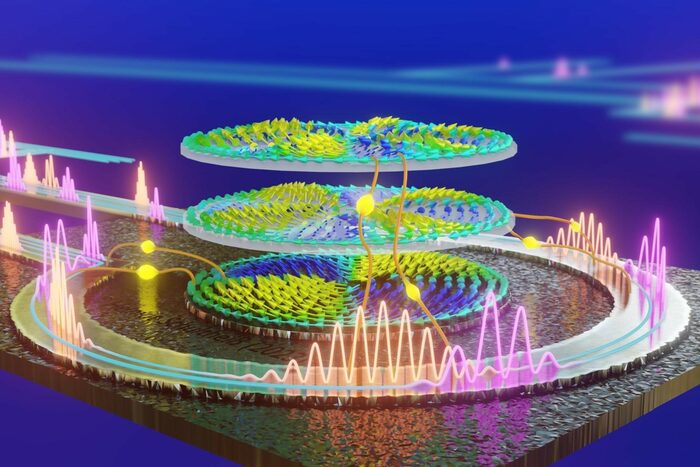
They are small, powerful and indispensable for many everyday tasks: computer processors. In certain areas of application, however, they have so far struggled to recognise patterns in large data streams and to grasp their complexity. And they consume a lot of energy. So-called neuromorphic computers are superior to them. Researchers at the Helmholtz Centre Dresden-Rossendorf (HZDR) have now taken this technology a big step forward.
Today's computers break down tasks in their processors and memories into long sequences of zeros and ones. They then compare them with elementary logical operations, adding and subtracting them. This binary logic and digital computing technology can solve most maths problems faster than any human. But: in many areas of automation, industry is currently struggling with fast data transmission. Examples are autonomous driving, the Internet of Things or edge computing, i.e. data processing at the edge of a network. Here, sensors deliver small data packets at high speed. Recognising patterns in them is very energy-intensive for contemporary computer architectures. The solution for the researchers at the HZDR: spin waves, also called magnons.
The idea of using magnons to create a new data processing technology is somewhat older. But the HZDR team's work has solved a problem that was hindering practical implementation. All previous concepts rely on the fact that spin waves have to propagate from A to B in order to be manageable. But so far there are no really suitable materials for this. The Dresdeners now took a different approach: they shifted the entire process into a magnetic disc only a few micrometres thick and set it oscillating. Now the whole body vibrates, simultaneously at different frequencies. You can imagine it like a drum: If you sprinkle sand on a drum and beat it rhythmically, patterns emerge. These are modes of vibration. And they exist in the entire space. So they don't move from A to B. They are standing waves that exist resonantly on the entire body. The knocking of the drum is the data input, which can come from a sensor, for example. It causes an interplay of different vibrations and resulting non-linear processes. Because the processes are similar to those in the human brain, the new technology is also called "neuromorphic computing".
From the researchers' point of view, the new, extremely energy-efficient technology is not intended to replace existing computers, but to complement them. One possible field of application is traffic optimisation. For neuromorphic computers could search the mountain of data provided by services such as Google in combination with smartphones and cars for patterns and predict a traffic jam before the first car has even stopped. This is a highly complex matter that conventional computer architectures like PCs struggle with enormously. They need many computing steps. For neuromorphic computing, on the other hand, it is the ideal field of application. Intelligent maintenance could also benefit from neuromorphic computers. In wind turbines, for example, they could look for vibration patterns in the drive shafts that indicate bearing damage. This would make maintenance possible before the bearing even fails. That saves money, energy and resources.
More informations
July 20, 2023 | New center for semiconductor metrology in Dresden: For more precision, quality and efficiency.
They are built into laptops and smartphones, cars and washing machines, and are a key driver of digitalization: we are talking about semiconductors. In order to further advance semiconductor research and to target the next milestones in development, Dresden's Fraunhofer IPMS and Applied Materials are now joining forces. In the heart of Silicon Saxony, at the Center Nanoelectronic Technologies (CNT) of the Fraunhofer IPMS, one of the largest technology centers for semiconductor metrology and process analysis in Europe is to be established.
Measurement technology, also known as metrology, is of fundamental importance in the manufacture of microchips. This is because precise measurements enable the quality of individual steps and processes in manufacturing to be accurately monitored, controlled and thus continuously refined. Applied Materials manufactures state-of-the-art measuring equipment for the semiconductor industry, while Fraunhofer IPMS is Germany's leading research center for semiconductors on 300mm. In the new technology center, they now combine their competencies and work together to comprehensively accelerate developments in the field of semiconductor metrology and optimize process steps. New methods, algorithms and software will be developed and tested in the technology hub.
"This unique center of excellence will be able to test and qualify processes on a wide range of substrate materials and wafer thicknesses that are critical for applications in the diverse European semiconductor landscape," explains James Robson, corporate vice president for Applied Materials Europe. Dr. Benjamin Uhlig-Lilienthal, head of the Next Generation Computing business unit at Fraunhofer IPMS adds that his institution and other partners will benefit from "access to Applied's industry-leading eBeam metrology systems." These include major chip manufacturers such as Globalfoundries, with whom Fraunhofer IPMS works closely, as well as smaller and external companies that conduct joint research with the institute. As a meeting place for industry and science, the technology center in Dresden thus brings with it the potential to be an important driver for the semiconductor industry in Europe and to play a significant role in shaping digitization.
More information
Fraunhofer IPMS Press Release
About Fraunhofer IPMS
About Applied Materials
July 18, 2023 | Hydrogel wound dressings from Dresden promise cure for chronic open wounds
After ten years of research: clinical trials for the novel high-tech wound dressing ResCure, developed by scientists at the Leibniz Institute of Polymer Research Dresden e.V. (IPF), will soon begin. The new dressing could solve a major problem: Unlike previous wound dressings, the hydrogel-coated wound dressing tackles the cause of open wounds instead of just reacting to the symptoms.
Normally, the human body has the ability to heal wounds on the skin or mucous membranes itself within a short time. Unfortunately, however, this does not always work, for example if the affected person suffers from a circulatory disorder, a weakened immune system or diabetes. If wounds do not heal after one to three months despite treatment, they are called chronic. In Germany alone, around 900,000 people are currently affected. Giving them hope for a cure was the goal of the IPF researchers.
The hydrogel wound dressings they developed have a very special property that sets them apart from other wound dressings. Until now, excessive or chronic inflammatory processes that prevent wound healing could only be treated with systemic drugs. On the one hand, these often bring side effects and on the other hand, they are only effective to a limited extent.
The novel technology, on the other hand, combats inflammatory processes directly at their cause and can thus dissolve them. For this purpose, the researchers have developed polymer networks from derivatives of the glycosaminoglycan heparin and branched polyethylene glycol, which function like a "molecular sponge" and can absorb pro-inflammatory signal molecules from the wound and inactivate them. At the same time, they leave signalling molecules that promote wound healing largely in the wound.
The new therapy concept has already been successfully tested in animal models and on human wound secretions. And "extremely successfully", as Prof. Dr. Carsten Werner from the IPF emphasised in an interview with the Sächsische Zeitung. According to the study, wound healing is fifty percent faster than with standard therapies.
The clinical trial with around 100 patients is expected to run until the beginning of 2024. If everything goes according to plan, a company producing the ResCure hydrogel wound dressings could be founded as early as the beginning of 2025.
July 14, 2023 | Predictable batteries: Dresden engineers extend life cycles of rechargeable batteries
When you play the video, a connection to an external website is established, your user information is transmitted and possibly processed there. Further information can be found in the privacy policy. (Privacy policy).
The car is slow to start, the laptop won't boot up. Who hasn't experienced it: Batteries with a weak age can make life difficult for us. But there is often more to batteries than meets the eye. The Dresden-based company NOVUM engineering has developed a novel process that uses AI to check batteries in order to use them more efficiently and for longer. This saves a lot of time, money and emissions. For its development, the company won the State’s prize for Innovation this year.
Batteries are a black box for many. Because until now, their state of charge has only been estimated. No one knows exactly how long they will last or when they will break. As a result, batteries are often used inefficiently. According to the German Federal Environment Agency, batteries require up to 500 times more energy to manufacture than they later make available. If they are used incorrectly or are subject to severe temperature fluctuations, performance is further compromised. Under the right conditions, however, they can be used for much longer and recycled for a second or even third life cycle. This is highly relevant not only for private consumers, but also for industries. Efficient batteries are a key issue in e-mobility, for example. The aim here is to use the expensive batteries, which require a lot of energy to produce, for as long as possible.
But how long do rechargeable batteries actually last? How large is their capacity really? And how much energy is still contained at the end of a life cycle? Engineers at NOVUM engineering can now determine these questions precisely and in seconds with their innovative process. They have developed a process that is unique in the world to date for making reliable statements about the condition, capacity and service life of batteries. And they can do this for all types of batteries and battery storage systems of any size, from smaller lithium batteries to LFP batteries installed in cars, mobile homes or motorboats, and even large-scale storage systems in industrial companies.
Smart monitoring uses patented technology and AI-based processes to completely scan and monitor batteries. The AI needs just 90 seconds to test the condition of batteries used in industry, for example. The data collected in the process is uploaded to the NOVUM cloud and analyzed using neural networks. In this way, the state of charge can be determined precisely for the first time. Monitoring takes place on site or remotely via data transfers, as required. For example, a fleet management company can have its vehicle batteries conveniently checked via a mobile service tool.
With the precise assessment of the batteries, so-called predictive maintenance, operations can adjust their usage behavior and derive the ideal use of the battery. This saves a lot of energy, emissions and costs. Large-scale storage systems can be operated more economically and fast-charging processes for small electrical appliances can be optimized. Used batteries are given a second or even third life cycle thanks to diagnostics. This can save up to 90 percent of recycling costs.
Battery storage and its optimization are essential for the energy transition - and NOVUM engineering has found a way to make batteries more predictable and durable. The company has already received several awards for its innovative process, including High-Tech Startup Europe 2017 and, most recently, first place at the Saxony Innovation Award 2023.
More information
July 11, 2023 | Spectral analysis: When the washing machine saves the cashmere jumper
What's in the wool programme again? And is 40 degrees enough to get the stain out of the blouse? These are questions that we will perhaps be able to leave to our washing machine in a few years' time - thanks to the "scanning mirror microspectrometer" (SMMS) that has just been developed at the Fraunhofer Institute for Photonic Microsystems in Dresden. But of course, much more is possible with them than error-free laundry.
The Fraunhofer Institute for Photonic Microsystems IPMS aims to develop pioneering technological solutions and bring them into application. Also in the field of optical sensor technology. Here, the institute presented a demonstrator for the first time this year that uses spectral analysis to detect which materials textiles are made of.
Light is sent onto a sample, reflected back from it and split into its spectral components. The chemical composition of the sample, from the garment to the food, changes the emitted rays so that information can be read out about it - for example, whether a jumper is really made of cashmere or an apple is already ripe enough to eat.
In Dresden, several players are working on such technology, such as "Hiperscan" and "Senorics". In the "Sensorics" system, the splitting is done by means of an arrangement of 16 sensor elements, each with a set spectral sensitivity. This achieves a moderate resolution that is sufficient for simple determinations such as the differentiation of textiles. "Hiperscan" and the "Scanning Mirror Microspectrometer" (SMMS) of the Fraunhofer Institute for Photonic Microsystems, on the other hand, rely on splitting the light at a diffraction grating, which allows for better resolution and more precise measurements.
The technology opens up all kinds of possibilities. Taking the value chain of textiles as an example, from material testing when buying new clothes to care, where the need for cleaning could be determined by analysing the dirt particles and the appropriate washing programme could be selected. This could enable older people in particular to manage their daily lives independently for longer. In textile recycling, the system could sort textiles by colour and material. Other areas of application would be, for example, the freshness testing of food, the sorting of plastic objects during recycling or the determination of the type and concentration of raw materials in pharmacy.
With SMMS, the recognition rates are further improved by combining them with artificial intelligence. In addition, the combination with AI software enables the development of "intelligent" overall systems. There are still development steps to be taken, such as reducing production costs, but smartphones with built-in microspectrometers could be possible in the future.
More Information
July 5, 2023 | Revolutionary speaker technology from Dresden makes smart headphones possible
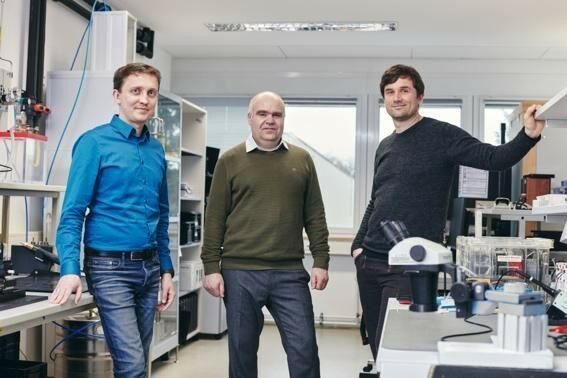
What we still need our smartphones for today, intelligent in-ear headphones with a direct Internet interface could do in the future. Until now, however, the technology for suitable loudspeakers has been lacking – because they not only have to be small, compact and energy-saving, but also able to reach the 120 decibel volume required by the market. Researchers from Dresden have now received the Joseph von Fraunhofer Prize 2023 for the development of just such micro loudspeakers.
Making calls, playing music, having the latest e-mails read to you or making bank transfers: Our headphones could soon do all these things for us. Simply by voice command. Because the new speaker technology is so space- and energy-saving that it can fit an entire smartphone in the headphones. That's still a long way off – and when it will be depends on the technological development of various components.
However, the Dresden team led by Dr. Bert Kaiser and Dr. Sergiu Langa from Fraunhofer IPMS and Holger Conrad from Bosch Sensortec GmbH has now succeeded in taking a decisive step toward the future: The loudspeakers they have developed meet all the conditions to form the previously missing core for intelligent in-ear headphones: They can be manufactured inexpensively using microelectronics technologies and manage the 120 decibels without high energy requirements.
The development was successful due to two novel scientific approaches: On the one hand, a completely new design of the loudspeaker, which is not based on a vertically deflectable diaphragm as usual, but in which the sound-displacing elements are located vertically in a silicon chip. And on the other hand, on a new drive technology for these elements, the Nano e-drive actuators, which make the sound generation possible in the first place.
In awarding the Joseph von Fraunhofer Prize to Kaiser, Langa and Conrad, the jury recognized, among other things, “the scientifically and technologically comprehensive approach to the development of a novel sound transducer concept.”
In order to market the loudspeakers, Arioso Systems GmbH was founded in 2019 as a spin-off of the Fraunhofer IPMS and the research work at the Brandenburg University of Technology Cottbus-Senftenberg. Last summer, Arioso Systems GmbH was acquired by Bosch Sensortec GmbH. The common goal of all players: to develop cutting-edge products for the global mass market based on loudspeaker technology.
More information
IPMS News
June 23, 2023 | More than 600 guests at the 17th Silicon Saxony Day in Dresden
Dresden is the heart of the German semiconductor industry. This was once again impressively demonstrated at the 17th Silicon Saxony Day: More than 600 industry representatives, sector experts and researchers from 20 countries met at Dresden Airport on June 21 to discuss the future of the location. The focus was on financial resources from the EU Chips Act and the IPCEI (Important Project of Common European Interest) program. In addition, figures on the continuous growth of the industry in and around Dresden were presented.
In 2022, around 76,100 people were employed in Saxony's microelectronics and ICT sector. The figures do not yet include the announced increase in personnel from companies that are currently expanding their capacities and commitment in Saxony. Compared to 2021, the industry grew by 4.2 percent. According to Frank Bösenberg, managing director of the Silicon Saxony industry association, it is assumed that "in 2030, around 100,000 employees in Silicon Saxony will be working on the latest developments in many demanding professions that will make our everyday lives easier and more sustainable." The picture is similar in Saxony's software industry, which grew by 7.6 percent year-on-year and currently employs more than 35,000 people.
With its investments, the European Commission is strengthening the microelectronics and semiconductor sector and creating investment and planning security for the industry. Semiconductors are a key technology in climate protection: In photovoltaic cells, they generate electricity from light; in converters, they convert energy in such a way that it can be transmitted to the power grid with minimal loss. Semiconductors make drives more efficient, monitor the various systems involved in the energy chain in sensors, and network sustainable energy generation and consumers with each other via the Internet of Things so that supply and demand are optimally matched. However, their production also consumes considerable resources. That is why the players along the entire semiconductor value chain are intensifying their efforts to make microchip production itself more sustainable.
More information
Silicon Saxony News
20 June 2023 | Smart measurement methods from Dresden against heat islands in the city
It is getting hotter and hotter: Since the 1950s, the number of days a year when the average temperature in Germany is at least 30 degrees has tripled. Large cities in particular heat up strongly in summer. So-called heat islands are a serious health hazard and cause a lot of damage due to burst asphalt surfaces. This is where the KLIPS project comes in, in which two research institutes and several companies from Dresden are involved. The aim is to localise heat islands so that the findings can be taken into account when planning neighbourhoods.
KLIPS stands for "AI-based information platform for the localisation and simulation of heat islands for innovative urban and traffic planning". As part of the research project, sensors record temperature and humidity. An AI determines from the measured values how the temperature is distributed in the city. Applications for improved management of overheating are then created on this basis. Instead of relying on expensive meteorological standard sensors, a project team developed new types of urban climate sensors. The Dresden companies ERGO Umwelttechnik GmbH, PIKOBYTES GmbH, Contronix GmbH, the Institut für Luft- und Kältetechnik (ILK) and Leibniz-Institut für ökologische Raumentwicklung e. V. Dresden are involved. Steffen Rietzschel, Head of the Office of Economic Development: "We are thus developing use cases that create added value for citizens and at the same time open up business models for the participating companies." The research project is funded with 2.3 million euros by the Federal Ministry for Digital Affairs and Transport and is accompanied in the state capital by the EU project MatchUP.
After a successful test phase, around 300 sensors are currently being installed in the city. From summer onwards, they will measure climatic behaviour at representative locations such as the Großer Garten. At selected sensor locations, citizens can inform themselves about measurements and the project on information boards. The special feature of the project is the "swarm sensor technology", i.e. the use of a local sensor network that provides the measurement data via a data interface. The sensor data, which are based on the standards of the German Weather Service, enable improved microclimatic recording of overheating in the city. They are also used for training and operating specific AI models that analyse and forecast the temperature distribution in the city.
The researchers expect the models to deliver results by the end of summer or early autumn. After that, the assessment and evaluation will begin. If the data quality is sufficient, those involved in the project want to produce maps of Dresden's overheating as early as this year. By next summer at the latest, the first information should be available for urban planning and the public.
Further applications are already being considered: for example, the data will provide real-time heat reports in the future and improve the daily information on hot and cool spaces in the city, so that more attention is paid to heat development. The insights gained should also support future city planning and thus prevent overheating. Finally, the heat sensors can help monitor the long-term effects of construction measures.
15 June 2023 | Team of Dresden researchers discovers possible therapeutic approach for ALS
Every year, about 2,500 people in Germany fall ill with amyotrophic lateral sclerosis (ALS) - a neurodegenerative disease of the Motoneurons. So far, there is no treatment for ALS; the disease usually leads to death within two to five years. An interdisciplinary team of researchers from the Helmholtz Centre Dresden-Rossendorf (HZDR) and the Technical University of Dresden has now found a possible therapeutic approach to cure ALS.
Motoneurons are certain nerve cells located in the brain and spinal cord that are responsible for controlling the muscles. ALS destroys these Motoneurons so that the muscles no longer receive instructions, can no longer work and fade away. Patients are often dependent on a wheelchair. In the later course of the disease, they also have difficulty speaking and swallowing. In the final stage, paralysis of the respiratory muscles also occurs, leading to death. The research team around physicist Dr. Thomas Herrmannsdörfer and cell biologist Dr. Arun Pal from the HZDR and medical scientist Prof. Richard Funk from TU Dresden succeeded in reprogramming skin cells from both healthy people and ALS patients into Motoneurons in the laboratory. The Motoneurons prepared in this way were then exposed to magnetic fields of different strengths for different periods of time. The series of experiments showed that the motor neurons of the ALS patients responded to the magnetic fields: The transport of mitochondria - the "power plants" of the cell - and other cell components was reactivated by stimulation with magnetic fields. In addition, the cells' ability to grow and network again was restored.
From the researchers' point of view, the results are a first milestone. The scientists are now planning long-term and in vivo studies, i.e. in the living organism, to further expand the therapeutic potential of magnetic field treatments. They also want to investigate how the cell changes of other neurodegenerative diseases such as Parkinson's, Huntington's disease and Alzheimer's react to stimulation with magnetic fields. In the long term, clinical pilot studies with special devices for magnetic stimulation are planned.
More information
HZDR News
31 May 2023 | Dresden researchers co-invent pill that detects vulnerabilities in machines and people
Machine broken? Man sick? Pill popped, error found! Impedance spectroscopy is not quite as simple as its cumbersome name suggests. But in principle, the picture with the pill comes very close to what researchers at the Fraunhofer Institute IZM have invented in cooperation with Micro Systems Technologies (MST) and Dresden-based Sensry GmbH: a waterproof Internet-of-Things sensor, as small as a candy, that reliably measures the properties of liquids even in hard-to-reach places, making the maintenance of industrial machines much easier and even helping to identify diseases.
The larger an industrial machine, the longer it takes to detect an unwanted deviation in oil pressure or even a leak from the outside in the event of a malfunction. The result: production downtime and high costs. The detection of the causes of illness in humans is similar: if the stomach hurts, a complex gastroscopy or colonoscopy is usually required.
This is where electrochemical impedance spectroscopy can help. It detects changes in materials or liquids, which can be an indication of the corrosion of a component or even a certain disease. Until now, such impedance analyzers have not been small and mobile enough to be used in this way. Fraunhofer IZM, with the support of MST and the Dresden-based company Sensry, has now developed a compact and modular IoT sensor for these applications that can measure impedances and transmit them wirelessly, waterproof and biomedically compatible.
At just 11 by 16 square millimeters, the sensor combines the two necessary electrodes with numerous components for analyzing environmental properties, making it the world's smallest impedance spectroscopy sensor! In addition to temperature, pressure, humidity and sound in the environment, the tiny multi-talent can also record its own acceleration behavior, rotation, light, colors or ambient noise. The data is transmitted wirelessly to a specially developed software with a web interface for PC and smartphone. If a point is reached where the pressure or fluid spectrum deviates from the norm, this is an indication of a problem cause.
The possibilities of electrochemical impedance spectroscopy for medical technology are far from exhausted and research into this is in full swing, including in Dresden!
More information: Fraunhofer Tech News
May 23, 2023 | Rock Cellar Laboratory in Dresden: High-tech research at a depth of 40 meters
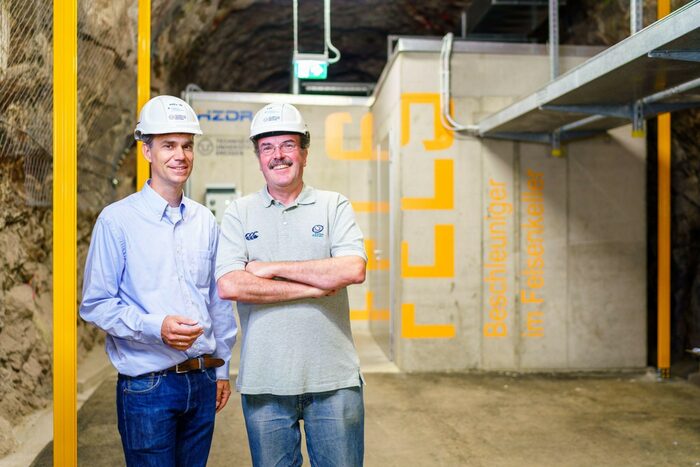
After years of development work, researchers from the Institute of Nuclear and Particle Physics (TU Dresden) and the Institute of Radiation Physics (HZDR) have made it: one of the most sensitive experimental setups in the world goes into operation, and research at a depth of 40 meters can begin. In the laboratory, which is hewn into a tunnel, exotic reactions of particles are provoked and observed. No less than the most powerful processes in the universe are at stake: the Big Bang, neutron stars and dark matter.
A very special place in the underground laboratory is occupied by Germany's most sensitive measuring instrument, which attracts researchers from all over the world to Dresden. It can analyze samples of substances and materials with a radioactivity in the range of 100 microbequerels, which corresponds to just one hundredth of the radioactivity present in the human body.
This requires a low-radiation environment, such as that provided by the Felsenkeller brewery's former ice storage facility. Around 40 meters of rock wall shield the apparatus from cosmic radiation. In addition, a four-ton protective layer of special concrete, lead and copper ensures that the natural radioactivity of the rock does not influence the measurement results.
And why all this effort? A central component of the research in the rock cellar laboratory is rare nuclear transformations in elements such as those that occurred at the very beginning of our universe. In the laboratory, scientists from all over the world are investigating central questions of astrophysics, such as what darkl matter is made of. Only five percent of the universe is known to us, the so-called "normal matter". Galaxies, stars, planets, the things of our everyday life and also we humans belong to it. Dark matter, on the other hand, is largely a mystery. Current estimates assume that it makes up 70 to 80 percent of the universe! Nevertheless, almost nothing is known about its properties, only its gravity reveals them. The Dresden Felsenkeller Laboratory has all the prerequisites to become one of the world's central research facilities for determining this mysterious substance.
Read more
12 May 2023 | Sweet bone healing turbo from Dresden

As we age, our bodies become less able to renew our bones and keep them strong. However, as we humans grow older, research has long been searching for new therapies to improve bone regeneration. An interdisciplinary team from Dresden has now achieved a breakthrough: scientists from the Biotechnology Center (BIOTEC), the Medical Faculty and the Max Bergmann Center for Biomaterials (MBC) at TU Dresden have developed novel bioinspired molecules that improve bone regeneration in mice – and perhaps soon in humans.
Using computer models and simulations, the team from Dresden developed novel bioinspired molecules that can be incorporated into biomaterials and thus delivered locally to bone defects. The novel molecules are based on glycosaminoglycans, long-chain sugars such as hyaluronic acid or heparin – a sweet solution as a bone healing turbo!
The key to success here was the interdisciplinary approach and close collaboration between the various research institutions. “Thanks to the work of our group and others, we know a specific molecular pathway that regulates bone formation and repair,” explains Prof. Lorenz Hofbauer from the Medical Faculty of TU Dresden. “We were able to narrow it down to two brake signals that work together to block bone regeneration.” The major challenge for developing drugs to improve bone healing, he said, is now to simultaneously and efficiently turn off these two blocking proteins.
“For years, we have used the power of computer simulation to study how proteins that regulate bone formation interact with their receptors,” says Prof. Maria Teresa Pisabarro of the Biotechnology Center (BIOTEC). The team at Prof. Hofbauer's “Bone Lab” eventually used biomaterials loaded with these molecules on bone defects in mice to test their effectiveness. In the process, the materials loaded with the new molecules proved to be significantly more effective than standard biomaterials, increasing bone healing by up to 50 percent, indicating tremendous regenerative potential!
“For each molecule, we were then able to measure how strongly it binds to the proteins as well as how it interferes with the binding of the proteins to their natural receptors,” says PD Dr. Vera Hintze of the Max Bergmann Center for Biomaterials. “In this way, we were able to empirically show how effectively they thereby switch off the inhibitory proteins.” Hofbauer's group tested the biological relevance of these interaction studies in a cell culture model and later in mice.
The results are of great value with considerable clinical relevance , to serve as a blueprint for the development of novel and better molecules in the future. Not only will this minimize animal testing. The newly developed molecules could also be used, for example, to knock out proteins that block bone regeneration - and lead to the development of new, more effective therapies for fractures and other bone diseases.
Learn more:
TU Dresden News
May 3 2023 | “Europe’s digital lighthouse”: Groundbreaking ceremony for Infineon’s billion-euro project in Dresden

The symbolic groundbreaking ceremony for the new Infineon chip plant in the Saxon capital was attended by a host of political VIPs – from EU Commission President Ursula von der Leyen to German Chancellor Olaf Scholz, Saxony’s Prime Minister Michael Kretschmer, Economics Minister Martin Dulig and Dresden’s Lord Mayor Dirk Hilbert. Great hopes rest on the project; after all, nothing less than Europe’s technological sovereignty is at stake.
“Dresden is a digital beacon for Europe,” congratulated Ursula von der Leyen, who had come all the way from Brussels to attend the groundbreaking ceremony for the Infineon Smart Power Fab. She said it was great news that Infineon was investing massively in semiconductor production “in times of geopolitical risks.” Because any disruption to trade would “hit our internal market hard,” the EU Commission president warned, referring, for example, to the current tensions between China and Taiwan. “That's why we need more mass production in semiconductors again,” von der Leyen said. “And that’s why Dresden is so important!”
German Chancellor Olaf Scholz emphasized that Germany not only welcomes and supports the EU Chips Act, but is also “filling it with life.” The EU member states would invest up to 43 billion euros in the coming years to double the global share of chip production “made in Europe” to 20 percent. Against this background, the Chancellor hinted that Infineon’s investment “will not be the last major investment we see in Silicon Saxony.”
Infineon CEO Jochen Hanebeck also looked to the future: “Together, we are driving decarbonization and digitalization.” Starting in 2026, power semiconductors based on 300-millimeter manufacturing technology, which are needed for electricity meters and smart meter systems, wind turbines or charging columns, are to be produced in Dresden. The Munich-based group is investing five billion euros in the new factory, the largest single investment in the company’s history. And it will pay off, Hanebeck is sure: “Global semiconductor demand will grow strongly and continuously in view of the high demand for renewable energies, data centers and electromobility.” The plant is expected to create around 1,000 new jobs in Dresden and the surrounding area.
The great importance for the region was also demonstrated by the fact that Minister President Kretschmer and Economics Minister Dulig flew in specially by helicopter to be on site in time from the joint cabinet meeting with Bavaria from Munich – an extremely rare measure, according to the state chancellery.
More information: Infineon news
May 2nd, 2023 | New era for medical electronics begins in Dresden
A globally unique research cluster will start work in Dresden next month. SEMECO's ambitious goal is to bring innovative medical technology into use much faster than before for the benefit of patients. To this end, institutes, the chip industry and medical technology manufacturers in and around Dresden are pooling their expertise to develop intelligent chips specifically for medical applications. The aim is to reduce long approval loops and significantly increase the pace of innovation in the medical field.
The project is based at the Else Kröner Fresenius Center for Digital Health (EKFS), with TU Dresden responsible for coordination. Financial support of 45 million euros is available from the federal government through Clusters4Future , supplemented by another 17 million euros from the Free State of Saxony. Depending on the size of the project, further funding from industry is to be added.
The cluster addresses one of the biggest problems in medical technology: obsolete electronics. Chips usually have to be assembled from other industrial sectors to create special medical applications - which costs time and money. Compared to the latest cell phones, for example, the backlog is usually ten to 20 years. "In principle, what we find in medicine is always ancient technology," says project leader Gerhard Fettweis, institute director and professor of communications engineering at TU Dresden.
New chip technologies made in Dresden and developed specifically for medicine are expected to turn things around. "Instead of kits the size of a shoebox, everything is to be shrunk down to a chip," reports EKFS Director Prof. Jochen Hampe, co-leader of the major project. This paves the way for completely new, miniaturized implants, sensors for analysis as well as evaluation, control and communication with other devices - "all combined in one piece of silicon," Hampe enthuses. In order to also drastically reduce the number of chips used, the Dresden engineers, doctors and chip companies are focusing on medical modules. The automotive industry serves as a model here: "This is our niche, our innovation gap," says Prof. Jochen Hampe.
For Dresden, as the coordinating center of the cluster, a unique opportunity is opening up to lead medical technology into the future. In addition to the TU and the EKFS, the 5G-Lab Germany and the Barkhausen Institute are other Dresden players participating in the project. In the first three years alone, those responsible expect up to half a dozen start-ups to emerge from the project. Up to 150 employees are expected to work at SEMECO itself.
Learn more: saechsische.de (in german, paywall)
April 24, 2023 | Dresden Salamander Study: Zombie cells not as evil as thought!
So-called senescent cells - also known as "zombie cells" - have long been associated with aging and disease. The reason: unlike healthy cells, they stop dividing. A new study by the Center for Regenerative Therapies Dresden (CRTD) at TU Dresden now paints a different picture: using experiments on salamanders, the Dresden researchers demonstrated that the supposed zombie cells can also play a positive role in regeneration.
Salamanders have unique regenerative abilities and can regrow organs in their bodies, including lost limbs. "They are one of the few species that seem to resist the natural aging process," says research leader Dr. Maximina H. Yun. "They don't show typical signs of aging and don't develop age-related diseases such as cancer." The research team wanted to know whether this was linked to the presence of senescent cells - with surprising results!
To this end, the Dresden scientists found a way to modulate the number of senescent cells in the wound. Astonishing: If more zombie cells were present in the wound, the animals developed a larger regeneration bud, a so-called blastema. This refers to a collection of cells that forms all the necessary tissue for the new limb. The larger the blastema, the more cells are available for the regrowth of the limb - and the faster the regeneration process. The physicians explain this phenomenon with special signal substances of the zombie cells. These apparently stimulate neighboring muscle tissue to regress - also known as de-differentiation in technical jargon. In the next step, they can both proliferate themselves and differentiate into new muscle cells, thus promoting the regeneration process.
Senes cells are an important key to better understanding the principles of the regeneration process. Drugs could be developed to delay, halt or at least make the aging process more comfortable. Even new strategies against cancer are conceivable. An answer to whether and how the self-healing abilities of the salamander can be transferred to humans has yet to be found. It remains exciting!
About the Yun-Group at CRTD: Yun-Group
April 21, 2023 | Fabric batteries to give e-cars more range

Batteries for electric cars need to become more resource-efficient! To this end, researchers at the TU Dresden and the Fraunhofer Institute for Organic Electronics, Electron Beam and Plasma Technology (FEP) are developing novel energy storage systems that are partly made of textile materials. In the "revoLect" project, they are pooling their expertise with other partners from industry and business to develop a suitable process by summer 2025. The fabric design makes it possible to increase the energy density of lithium-ion batteries - which in turn increases the range of electric cars. In addition, less copper and aluminum are needed for production compared to conventional processes.
The starting point for all this is two different types of fabric, which are being developed in parallel: Porcher Industries Germany GmbH, based in southern Germany, specializes in manufacturing fabrics from glass fibers. The Institute for Textile Machinery and Textile High Performance Materials Technology at the Technical University of Dresden (ITM) is researching ultralight carbon fabric, which is being tested as a carrier material for the electrodes. Which of the two types of material will ultimately prevail has not yet been decided.
Another development focus is the use of pure silicon as anode material. Anodes in lithium-ion batteries consist of a current conductor and an active material applied to it, predominantly graphite, in which energy is stored in the form of chemical bonds. This is where the specialists at Fraunhofer FEP come in: they specialize in particularly fast processes for coating the fabric electrodes with silicon in a roll-to-roll system.
Lithium-ion batteries are among the key technologies for e-mobility and are thus indispensable for the energy transition. Already, around 16 percent of newly registered passenger cars in Germany have an electric drive - and demand is rising rapidly! In addition, the demand for batteries for smartphones, laptops, electric bicycles and stationary energy storage is also increasing. Together with their project partners, the Dresden researchers are working at full speed on a sustainable solution that will contribute to the success of the energy transition.
Learn more:
Fraunhofer news
April 19, 2023 | Dresden researchers develop new therapy against leukemia virus
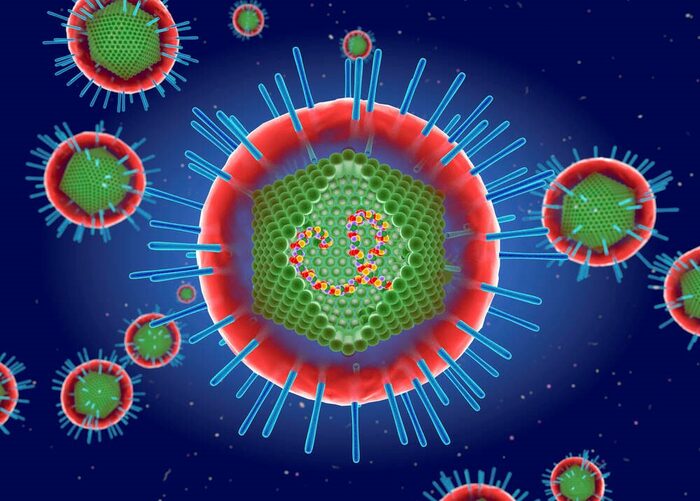
It is closely related to HIV, less well known, but similarly dangerous: the HTLV-1 virus. With the help of the TU Dresden, a group of researchers has succeeded in cutting out the so-called HTLV-1 virus from the DNA of infected cells. To do this, they used a gene scissor developed for this purpose. Unlike the well-known CRIsPR-Cas9 gene scissors, these are based on an enzyme called recombinase. Specifically, it is the designer recombinase RecHTLV, which was produced under laboratory conditions. It docks at the interface between the virus and the human DNA, separates them from each other and in this way reverses the infection. In cells in which the virus had not yet fully integrated, the gene scissors were also able to massively complicate the infection.
The HTLV-1-Virus causes aggressive forms of leukemia, an incurable spinal cord disease that leads to paralysis, and other inflammatory diseases. Between 10 and 20 million people worldwide are infected with the HTLV-1 virus, which is passed on mainly through sexual contact or via breast milk. Of those infected, ten percent develop the disease. The successful use of gene scissors technology in the laboratory is a first but important step on the way to containing the virus.
The findings must now be further intensively researched outside the laboratory: "We have already achieved continuous improvements with designer recombinases with regard to the HI virus - now it is important to further adapt RecHTLV for the HTLV-1 virus, which also belongs to the retroviruses and therefore ticks in a very similar way," explains Prof. Frank Buchholz from TU Dresden. In addition to the Dresden university, biotech company Provirex Genome Editing Therapies and Nuremberg-based university Friedrich-Alexander-Universität Erlangen-Nürnberg also contributed to the success of the project.
Learn more:
TU Dresden news
MDR
About TU Dresden: TU Dresden
March 31, 2023 | New radar system from Dresden's Fraunhofer IZM enables fast help in nursing care
If an elderly person falls in their own home, fast help is needed. A new radar system from the Fraunhofer Institute for Reliability and Microintegration (IZM) in Dresden provides just that. The new technology also assists in the search for lost objects and helps improve individual care in the long term. The system was developed with partners from Berlin and Oldenburg as part of the OMNICONNECT project funded by the German Federal Ministry of Education and Research (BMBF).
In an innovative way, the technology provides people in need of care with both more safety and more self-determination in everyday life: Four radar modules record the entire room and use artificial intelligence to detect dangerous situations. They interact with transponders known as tags, which are attached to movable objects or clothing. Each of these tags has its own target frequency, thanks to which it can be identified by the system. Depending on how long a tag's response to the system takes, this suggests the location of the object or person.
The radar modules are integrated into a ceiling lamp, which is why the system is hardly noticed in everyday life. Privacy is also maintained: instead of images, movement patterns are recorded, which are evaluated on site with the help of an adaptable integrated circuit (FPGA) and forwarded to the OFFIS computer science institute at the University of Oldenburg. The core of the research there is to create behavioral models and predictions based on the determined position data. For example, the system can remind people of a key that they keep forgetting. An overview of the tracked items is provided by an app with a floor plan of the house. The system is operated intuitively by voice control, for example by saying “Where is my key?”
In the long term, it should also be possible to use the recorded movement patterns to draw conclusions about the well-being of the individual. Thanks to the new technology from Dresden, care facilities will have an incredibly important treasure trove of data at their disposal, which they can use to tailor their care even more individually in the future.
Learn more: tech-news Fraunhofer
About the Fraunhofer IZM: www.izm.fraunhofer.de
March 27, 2023 | Electrochromic films: Dresden-based Fraunhofer FEP develops innovative heat protection for windows
Windows that turn dark at the push of a button: in Dresden, what sounds like science-fiction will soon become a reality. Coordinated by the Fraunhofer Institute for Organic Electronics, Electron Beam and Plasma Technology FEP in Dresden, six partners from all over Germany are developing so-called electrochromic films. The innovative glass coating unites a series of advantages: It can be retrofitted in existing buildings and darkens windows without the need for an additional sunshade system. Electrochromic films not only lower indoor temperatures in the summer, but conserve significant amounts of energy at the same time. And yet, the project goes beyond technological innovation: it will be organised in cooperation with a local secondary school in Dresden.
Our summers are getting hotter and hotter. All too often, air conditioning is the only way to cool down indoor spaces. But what if the windows themselves could block out the warmth before it even gets inside? In the FLEX-G research project, funded by the Federal Ministry for Economics and Climate Action, Dresden-based scientists have found an answer to this question: electrochromic films. These smart coatings are applied directly to the window glass and turn dark at the push of a button, while maintaining transparency and the view outside. The objective of the successor project, FLEX-G 4.0, is to make these films fit for cost-effective mass use. In cooperation with its partners, Fraunhofer FEP is researching the entire production process – from the films’ industrial manufacture all the way to application on the construction site.
The new technology will be tested where it is needed the most: besides a Fraunhofer research laboratory that will be newly built, the windows of 46. Oberschule Dresden, a local secondary school, will be retrofitted with the innovative films as well. Over a period of twelve months, this trial will provide the project scientists with valuable insights into the films’ energy conservation potential. At the same time, laboratory measurements will be conducted for comparison. For the school’s students, the trial will provide an exciting opportunity as well: Under the Fraunhofer researchers’ guidance, they will support both the measurements themselves and their evaluation. At the same time, by providing teaching materials and job orientation, Fraunhofer FEP and ISC will promote the students’ environmental awareness and interest in the sciences.
With their extensive experience in the field and important technological solutions for the application process, the two participating Fraunhofer institutes provide the scientific base for the films’ industrial application. From the coating process and the question of how to power the films to wireless control once they have been applied: the questions the project partners are trying to answer are based on the work of the Dresden-based research institute. The important technologies of the future – they are emerging right here in Dresden.
March 20, 2023 | Dresden Fraunhofer spin-off DIVE aims to revolutionize machine vision for the semiconductor industry
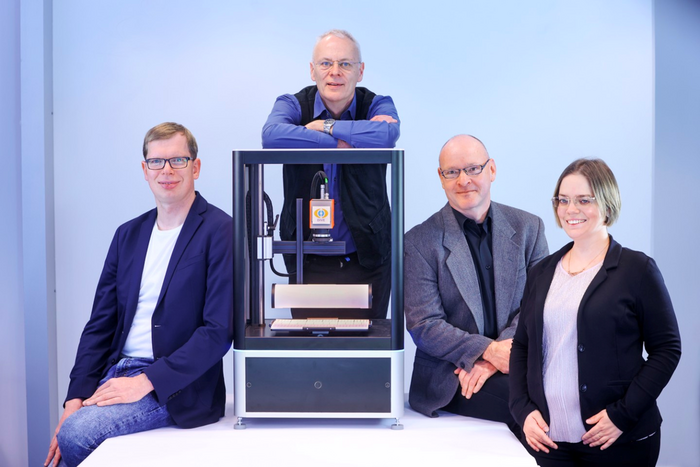
Scientists at the Fraunhofer IWS in Dresden have been working on 'Hyperspectral Vision Technology' for ten years. This could raise quality control in chip production to a whole new level. Now, part of the team spun off as DIVE imaging systems GmbH - and wants to bring the innovative technology to market. To this end, DIVE is receiving funding of 1.2 million euros from the German Federal Ministry of Economics and Climate Protection (BMWK). According to founder Dr. Philipp Wollmann, the company deliberately chose Dresden as its location because important players in microelectronics are concentrated here. "In order to further develop our technology in the best possible customer-oriented way, we have the shortest distances in this city and can also identify further partners with the successive expansion of the already existing network," says Wollmann.
Quality assurance is a fundamental step in chip production. However, desired requirements are often not met, as demonstrated by spot checks and time-consuming visual inspections by employees. The problem here is often impurities and residues on silicon wafers and foils that cannot be detected with known inspection technologies. In addition, safety-relevant applications, such as in the automotive and aerospace sectors, only tolerate defect rates of one in a million (based on the output of chips). If these are exceeded, it costs a lot of money. Correspondingly, high follow-up costs can be prevented if defects are detected and corrected at an early stage.
DIVE aims to revolutionize quality control with a solution that combines hyperspectral sensor technology, artificial intelligence (AI) and special lighting techniques into a powerful, highly flexible inspection system. In the first step, the DIVE system uses visible light and invisible infrared radiation to illuminate those wafers that will later be used to manufacture microchips for laptops, cell phones or cars. A hyperspectral camera captures the reflected light and registers 1,000 'colors' or wavelengths (the human eye registers only the three primary colors red, green and blue). The high-dimensional raw data is then passed to an AI that examines the '1000-color image' for defects and impurities to precisely assess the quality of individual chips or the entire wafer.
The semiconductor industry should be just the beginning for DIVE. In the long term, the founding quartet around Dr. Philipp Wollmann wants to establish its innovative DIVE technology for the inspection and analysis of surfaces and layers broadly in different industries.
Learn more: www.iws.fraunhofer.de
About DIVE: dive.com.de
March 14, 2023 | SAP opens innovation campus in Dresden city centre

The software company SAP is continuing its growth course in Dresden as a business and science location: In the heart of the city, the IT giant is opening a new workspace for another 400 employees, signalling that Dresden is gaining in importance as a location for SAP's global business. With the campus, the company says it wants to network its development capacities in the Saxon state capital more closely. The focus here is on the SAP Business Technology Platform as an innovation driver for forward-looking business transformation processes. "We are very pleased that we can continue to grow in Dresden as a location for science and innovation and strengthen our cooperation with local and regional partners," SAP's head of technology Jürgen Müller told the Dresdner Neueste Nachrichten (DNN). The expansion of the Dresden SAP site is also expected to create new jobs. "The history of SAP is, after all, a real success story," Saxony's Minister President Michael Kretschmer told the DNN. "We've been accompanying it for decades now, and that's a success of a clever science policy that always focuses on excellence and on new topics." If SAP presents itself at the Dresden location with the same consistency as in the past, the state premier's assessment as a "huge opportunity" could soon come true, also in terms of new jobs.
March 9, 2023 | Energy-efficient supercomputer inspired by the human brain: EU millions for Dresden-based deep-tech startup SpiNNcloud
SpiNNcloud Systems, a spin-off of TU Dresden, receives 2.5 million euros for its groundbreaking project "SpiNNode: SpiNNaker2 on the edge". Its primary goal: to save energy!
The Spinnaker 2 is the world's largest and most energy-efficient supercomputer for real-time artificial intelligence (AI). The technology is inspired by the human brain, which requires just 30 watts to perform highly complex tasks. By comparison, the energy requirements of the "Sunway" supercomputer, for example, are more than 8,200 times higher: it consumes a whopping 12 megawatts during corresponding computing operations.
"The extent of future power consumption in the use of AI is not yet foreseeable," says Christian Eichhorn, co-CEO of SpiNNcloud. "We are working on the most energy-efficient computing hardware for large-scale applications, as this will be key to significantly reducing the carbon footprint of AI."
The project's sponsor is the European Innovation Council (EIC), which supports startup research initiatives through its Transition Grant program. From a pool of 286 applicants, SpiNNcloud is one of 27 companies to be awarded the grant. This is the first time a deep-tech company from Saxony has prevailed in the bidding process. "With this funding, we can push ahead with our expansion and will deliver the first systems from Saxony to our customers worldwide in 2024," says SpiNNcloud CTO Matthias Lohrmann, setting the direction.
The supercomputer was developed as part of the European Flagship Human Brain Project, in which a team led by TU Professor Christian Mayer collaborated with the University of Manchester. SpiNNcloud is another prime example of the successful transfer of knowledge into entrepreneurial practice at the high-tech location Dresden.
Read more
February 24, 2023 | Fraunhofer FEP from Dresden accelerates transfer of innovative OLED technology to industry
In mid-March, the Dresden-based Fraunhofer Institute for Organic Electronics, Electron Beam and Plasma Technology FEP will present a technological innovation at the embedded world in Nuremberg that is quite something for experts: At the international trade fair for embedded systems, the Dresden scientists will showcase a test board equipped with 64 microdisplay chips, which is intended to significantly accelerate the transfer of innovative OLED technologies to industry. “Compared to individual evaluation kits, this offering is intended to support new development ideas and their rapid implementation at start-ups, SMEs or large companies,” says Martin Rolle, an engineer in IC and system design at Fraunhofer FEP.
The Dresden-based technologists and IC designers have optimized the designs and manufacturing processes for their ultra-low-power OLED microdisplays (used especially in wearables such as sports glasses or motorcycle helmets) to match the conditions in industrial manufacturing environments – a milestone for transferring the technology to industrial customers!
Fraunhofer FEP regularly offers industrial partners so-called evaluation kits for testing and development purposes: Packages of matching hardware and software to develop computer systems for individual needs. On the new test boards, up to 64 microdisplays can be tested directly via the corresponding drive electronics. “We have been able to significantly expand and optimize our pilot manufacturing processes in the clean room and with our external partners in recent years”, explains FEP engineer Martin Rolle. “Standardized test environments help us to quickly develop and establish customized microdisplays for our customers, such as specific color or brightness requirements.” Standardized manufacturing process technology development plays an important role here – and is taking a leap into the future with the new 64-component microdisplay test unit from Dresden.
OLEDs (organic light-emitting diodes) have a lower electrical current and luminance than inorganic light-emitting diodes (LEDs). They are cheaper to manufacture than conventional LEDs, but their service life and luminous efficacy are still lower. OLED technology is used for screens in smartphones, tablet computers, televisions and monitors or for large-area room lighting. High-volume applications of microdisplays have so far been limited primarily to electronic viewfinders in digital cameras and projectors. Since the first consumer-ready virtual and assisted reality glasses as well as professional applications of augmented reality glasses, the microdisplay market has increasingly shifted there – with great potential.
February 17, 2023 | X-Fab in Dresden wants to produce ten percent more microchips
X-Fab already operates Dresden's third-largest microchip factory. Now, thanks to record orders and new long-term contracts, it is being expanded: Production capacity at the Group's Saxon site is to be increased by a hefty 10 percent – up to 106,000 silicon wafers per year. For this purpose, the approximately 500 employees will get new colleagues: “We are still looking for qualified specialists,” says Group spokeswoman Uta Steinbrecher. (Interested parties can find current job postings at X-Fab here.) X-Fab engineers are also working on further automating production.
X-Fab, which employs 4,200 people around the globe, primarily produces microchips for cars, but also for industry and medical technology. Due to the high global demand for semiconductors, X-Fab is currently expanding capacity at all its sites. Group CEO Rudi de Winter anticipates strong growth: In the largest business segment, automotive, de Winter expects sales to increase by around 35 percent this year. In 2024, sales are expected to break the one billion dollar mark. Last year, X-Fab’s consolidated sales already grew by twelve percent to 740 million dollars.
X-Fab is benefiting from the boom in e-cars and green electricity. More and more semiconductors are being used in new cars to help manage electric drives and parking. But sales have also grown in medical technology, where the chips are used in contactless temperature sensors, ultrasound equipment and DNA sequencing systems.
Every third microchip from Europe is now manufactured in Dresden, which has therefore been given the nickname “Silicon Saxony”.
February 10, 2023 | Sunfire from Dresden sets milestone in hydrogen technology
Great success for hydrogen technologies made in Dresden: After three years of project work, the Saxon company Sunfire has put its new generation of co-electrolysis into operation - and thus set a real milestone: At factory acceptance, the high-temperature electrolyzer achieved an output of 220 kilowatts - an enormous increase compared to its predecessor in the first project phase: in this, the output had been just 10 kilowatts! And that's not all: At 85 percent, the efficiency also significantly exceeds the current market standard of 60 percent. Efficiency provides information about the amount of energy lost during the process. With these key figures, a technology is on the threshold of market maturity that can be an important piece of the puzzle for the emission-free industry of the future. Its unique feature is the process, in which synthesis gas is produced in just one step at temperatures of up to 850 degrees Celsius from water vapor and CO2, which in turn can be further processed into renewable fuels and chemical products. Green electricity is used for this purpose. Sunfire plans to deliver the system shortly to the Karlsruhe Institute of Technology, where it will be integrated into a power-to-liquid plant in the Energy Lab 2.0. The common goal of the project partners: to produce 200 liters of synthetic fuel per day. High-temperature co-electrolysis is an important part of the Kopernikus P2X research project, which is funded by the German Federal Ministry of Education and Research. The project is dedicated to the most promising approaches in the field of so-called power-to-X technologies: solutions that convert renewable electricity into other forms of energy.
February 1, 2023 | Better solar modules thanks to self-cleaning glass from Dresden
The team at the Dresden-based Fraunhofer Institute for Organic Electronics, Electron Beam and Plasma Technology (FEP) has developed a novel, self-cleaning protective glass. It is intended to increase the yield of solar systems in the long term. The special glass is manufactured in a roll-to-roll process in which crystalline titanium dioxide is applied to ultra-thin, flexible glass. The titanium dioxide causes raindrops and dew to bead off the surface of the solar panels overnight, preventing traffic dust, sand or other dirt from settling. This condition is called hydrophobic, or water repellent. During the day, when exposed to UV radiation, the state of the material changes to superhydrophilic, which results in a fine distribution of the droplets over the entire surface – now the sunlight can enter unhindered, and the electricity yield increases.
The Dresden scientists' smart combination of novel material and innovative manufacturing process offers several advantages: The coated thin glasses are flexible and can also be retrofitted to solar systems, windows or other glass house facades - even curved surfaces pose no obstacle. Self-cleaning saves costs as well as time and enables fast, simple and highly scalable production. Finally, the technology holds potential for other fields of application such as medical technology or flexible displays, because of the antibacterial effect of titanium dioxide.
The FEP research team had to struggle during development with the combination of titanium dioxide and thin glass: the latter is a new substrate that breaks easily and is sensitive to temperature differences and pressure. Titanium dioxide, on the other hand, can only switch between hydrophobicity and hydrophilicity when it is crystalline – which in turn requires high temperatures in production. With the first successful coatings on ultra-thin glass, the Dresden researchers have now laid the foundations for bringing the process to market maturity in the near future.
The anti-soiling thin glass was researched and tested as part of the European “New Skin” project. The aim is to bring new nanotechnological surfaces to market maturity.
January 31, 2023 | Helmholtz-Zentrum Dresden-Rossendorf: Nucleus of an emerging Radiopharmaceutical Valley
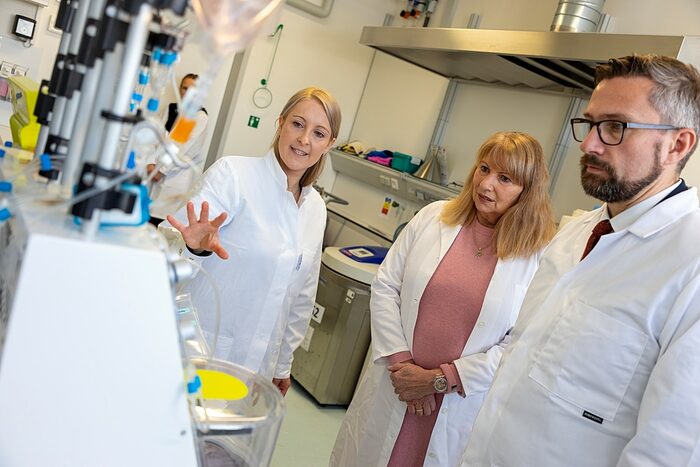
The vision for Saxony: an internationally networked "Radiopharmaceutical Valley" from which cancer is successfully fought - among other things, by local companies and research institutions serving the growing global demand for radiopharmaceuticals. The nucleus and innovation driver here is the Helmholtz Center Dresden-Rossendorf (HZDR).
During a visit to the center, Saxony's Minister of Health Petra Köpping and Minister of Economic Affairs Martin Dulig were informed about the status and perspectives. "Saxon companies, research institutions and clinics are excellently linked in an interdisciplinary way," said Dulig. "The HZDR acts like a nucleus around which expertise in low-level radioactive drugs forms and multiplies." Minister of State Köpping emphasized, "The healthcare industry in Saxony is a significant economic factor. It is highly innovative and of outstanding importance for the well-being of patients in our aging society."
Prof. Klaus Kopka, Director at the Institute for Radiopharmaceutical Cancer Research, sees the close networking of the ZRT with national and international partners from university medicine, non-university institutions as well as industry as an ideal prerequisite for Dresden to soon assume a pioneering role in the field of nuclear medicine: "From my point of view, Saxony as a science location has a unique opportunity to expand today's excellently positioned structures into an internationally active Radiopharmaceutical Valley in the Free State."
With its Institute for Radiopharmaceutical Cancer Research and the Center for Radiopharmaceutical Tumor Research, the HZDR has a unique infrastructure. All steps are united here under one roof: from the production of radionuclides to the design and development of new radiopharmaceuticals to production and transfer to application. Together with various partners from research and industry, the Dresden facility is working to develop highly effective radiopharmaceuticals for new diagnostic and therapeutic fields of application.
Radiopharmaceuticals are low-level radioactive preparations for imaging procedures in medicine and for the fight against cancer. They are used when chemotherapy, radiation or surgery do not help. They attach themselves specifically to growths and thus allow targeted, individually adaptable irradiation from the inside - healthy tissue is not destroyed. More and more researchers and physicians are therefore using radioactive drugs for more precise radiation therapies against cancer and other diseases.
January 20, 2023 | Plasma reactors from Dresden to reduce production costs for e-fuels to 1 euro per liter
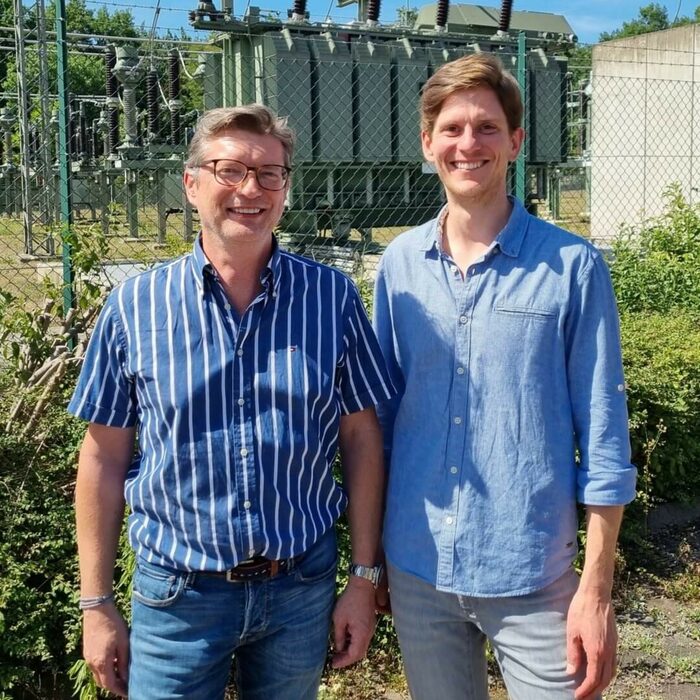
The Dresden-based start-up refuel.green wants to help the future technology e-fuels achieve a breakthrough - and is now receiving start-up financing of 1.2 million euros for this purpose. The High-Tech Gründerfonds (HTGF) as lead investor, the Technologiegründerfonds Sachsen (TGF) as well as two business angels are participating in this. e-fuels are synthetic fuels produced with green electricity, which could be one of the keys to climate-neutral mobility and industry. refuel.green promises to reduce the production costs from currently 2.50 euros per liter to 1 euro. To achieve this, they have developed a highly innovative plasma catalysis process that is efficient, cheaply scalable and sustainable. "The innovative solution approach, which can bring the production of e-fuels to a competitive price level, and the complementary founding team of innovation drivers, developers and plant engineers convinced us," explains HTGF investment manager Nils Lang.
In the plasma catalysis process, carbon and hydrogen are added to a reactor and a plasma is ignited inside. An added catalyst causes them to react to form hydrocarbons, which can then be refined into diesel, gasoline or kerosene. The process is not only climate-neutral, it even removes CO2 from the atmosphere, which is needed as an important raw material. This benefits refineries and chemical plants in particular, which are still dependent on fossil oil. What's more, e-fuels are compatible with conventional combustion engines - so infrastructures and vehicles can continue to be used. The technology is currently on the threshold of industrial application. A prototype is planned for 2023, and series production is expected to start at the end of 2025.
Read more
January 13, 2023 | Multi-organ chips for cancer therapies from Dresden are to replace animal experiments
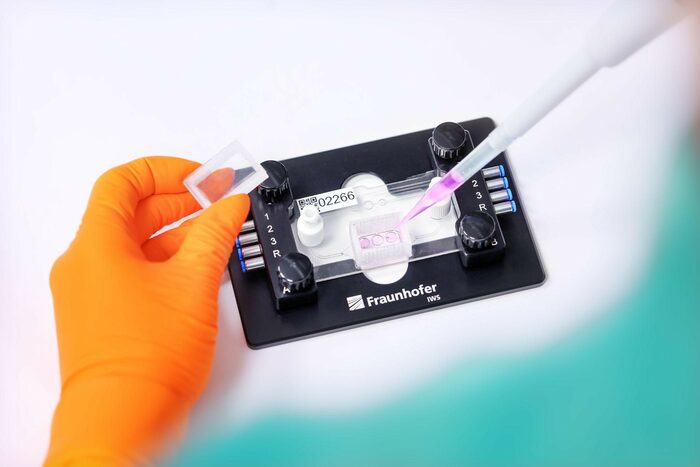
They are smaller than a smartphone and yet could soon save many animal lives: so-called multiorgan chips, which the Helmholtz-Zentrum Dresden-Rossendorf (HZDR) and the Fraunhofer Institute for Material and Radiation Technology (IWS), also located in Dresden, have now decisively developed further.
In multi-organ chips, artificially created cell cultures simulate organ functions, valves and channels simulate the vascular system, and a small pump simulates the heartbeat. In this way, the effects and side effects of drugs can be tested under laboratory conditions - making animal experiments unnecessary.
HZDR and the Fraunhofer IWS are currently working on the simulation of a three-dimensional tumor model. It will be used to test the effect of radiopharmaceuticals that detect cancer cells and enable targeted radiation from the inside - a treatment method that is both effective and gentle. So far, the drugs are still being tested on animals before they come into contact with humans. The use of multi-organ chips could drastically reduce the number of animal tests.
And not only that: "We could put patient-specific cells on a chip and thus simulate how a cancer disease develops," says IWS group leader Florian Schmieder, who also sees decisive advantages for the patients themselves as a result of the new development. In this way, customized individual therapies are possible. In addition, cancer forms tumor-specific antigens that cannot be reproduced in animal models. The medium-term goal of the two institutes is to bring the method to practical maturity. Initial positive tests show that the research team is on the right track.
The cooperation between the two institutes is exemplary for the added value of the DRESDEN-concept science alliance. The association of 36 partners aims to strengthen Dresden as a research location and to create and exploit synergies in research and teaching as well as infrastructure and administration.
January 06, 2023 | Infineon: Sensor technology to protect rainforests
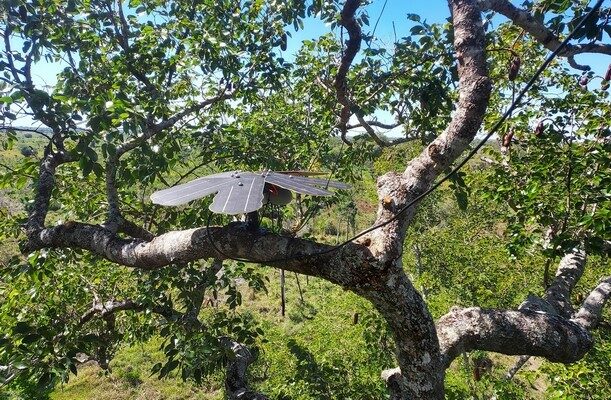
Preventing deforestation of tropical rainforests, preserving biodiversity - the non-governmental organization Rainforest Connection (RFCx) and Infineon AG from Saxony have joined forces to achieve these important goals. Together they have developed the "Guardian" system: Flying robots circle over the rainforest, record acoustic data and upload it to a cloud in real time. There, the data is analyzed with the help of artificial intelligence (AI). Threats can thus be located within a very short time and park rangers navigated to the scene.
Now Rainforest Connection and the Dresden-based semiconductor manufacturer are expanding their collaboration: Infineon is equipping a series of "Guardian" devices with the XENSIV™ PAS CO2 sensor.The goal is to gain further insights into the health of forests and identify areas worthy of protection. "By using gas sensors, we can link acoustic information about biodiversity on the ground with information about the microclimate," explains Bourhan Yassin, CEO of Rainforest Connection. The additional data will also provide information on how animals react to sensitive changes in the microclimate. Ten of these novel devices are already in use in Brazil and are achieving initial successes. For example, it turns out that the CO2 sensor provides valuable data that helps monitor biodiversity. Adrian Mikolajczak, vice president at Infineon's Silicon Valley Innovation Center, is confident: "Innovative technology solutions, like our CO2 sensors, can make an important contribution to protecting the most threatened regions of our planet."
In this way, researchers and environmentalists gain a deep insight into the complex happenings of the huge forest ecosystems. This is important because tropical rainforests play a crucial role in the global climate: if they are cut down, they fail as natural carbon reservoirs. Instead, additional CO2 is even released into the atmosphere. In addition, the rainforests have a unique biodiversity that needs to be protected: around two thirds of all animal and plant species living on land live in the tropical regions around the equator.
Infineon Technologies AG is a leading global supplier of semiconductor solutions for power systems and the Internet of Things (IoT). Products and solutions of Infineon are driving decarbonization and digitalization. With its approximately 3,100 employees, Infineon is one of the most important employers in the region and shapes the image of Dresden as Europe's center for microelectronics.
January 03, 2023 | Subsidiary founded: Lipotype's fat analysis specialists intensify collaboration with U.S. customers
Lipids, known primarily as fats, play a fundamental role in our health. It is now well known that diseases of civilization such as diabetes, cancer and cardiovascular disease are closely linked to lipid metabolism. Yet many questions about the significance of these mysterious molecules remain unanswered. Lipidomics is concerned with the identification and analysis of all fats in a biological system. Lipotype is considered a pioneer in this field and helps scientists worldwide to achieve breakthroughs in their research. As the world's leading provider of lipidomics analyses, they provide important data that offer a deep insight into the lipid cosmos - their credo is: "Lipidomics for a better life". For this purpose, Lipotype uses a mass spectrometry-based method that can analyze thousands of lipids of a sample within a very short time. At the end of the analysis, a lipid profile is obtained that can significantly increase the informative value of a blood lipid measurement. As current research results show, diseases could thus be diagnosed years before their symptoms become apparent.
However, it is not only preventive medicine that benefits from the Lipotypes services; thanks to the new insights, biotechnology, pharmaceuticals and the food industry also gain important knowledge for their research. In order to intensify cooperation with overseas customers, Lipotype is now establishing a U.S. subsidiary in a suburb of the biotech metropolis Boston. Its future CEO will be Oliver Uecke, Ph.D., explains, "Through Lipotype Inc. we're giving U.S. customers access to our services and easier shipping of their samples." Dr. JohnBajor, researcher at Lipotype customer Unilever, also welcomes the establishment of the first overseas branch and is pleased with the new geographical proximity to his own laboratories. "Lipotype offers us a consistent and reliable service in the field of lipidomic sample analysis." In turn, Saxony's Science Minister Sebastian Gemkow (CDU) sees the opening of the U.S. subsidiary as an important signal and precedent for the biotech cluster Biosaxony: "Biotechnology is a pillar of the innovative strength and economic power of the Free State," he said.
December 27, 2022 | Dresden-based startup Carl und Carla expands further and puts 1,000 vehicles into operation
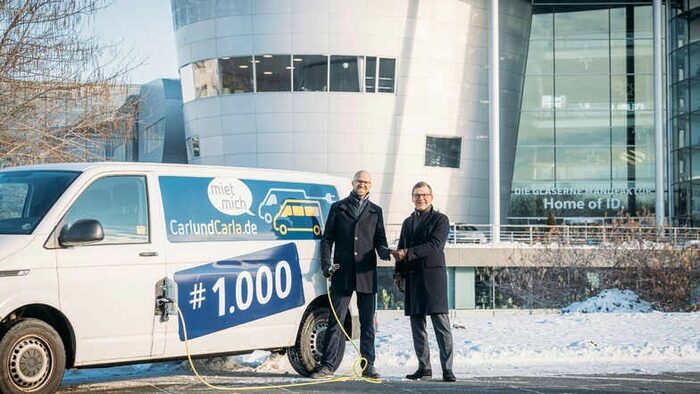
The decorated Christmas tree, the many presents underneath and also relatives visiting - During the holidays, space in one's own four walls can sometimes become tight. The idea to save the day? A quick trip to the recycling center to get rid of items that are just in the way. With Carl and Carla from Dresden, this is possible in more and more German cities. Via their platform, people on short notice can book vans easily and conveniently, pick them up at a rental station and start cleaning up right away. The startup, known for its car sharing with used T4 Bullis, continues to grow steadily and is now a medium-sized company with over 100 employees. Just recently, co-founder and fleet boss Richard Vetter symbolically took delivery of the 1,000th vehicle at the Gläserne Manufaktur, VW's production facility. In addition, an anniversary is just around the corner: in 2023, the startup will celebrate its tenth anniversary.
However, taking a breather is out of the question for Carl and Carla's team of founders, who are friends. "We have already ordered vehicles worth seven million euros for 2023," explains Richard Vetter at the handover of the 1,000 vehicle and announces, "Our plans are to be represented in all 40 German metropolitan areas with more than 200,000 inhabitants by 2025." The Saxon company is now represented in 32 German cities and regions, and Aachen, Bielefeld, Lübeck and Kassel are on the agenda as new locations for 2023. It is possible that Carl and Carla Bullis could soon even be on the road in Austrian and Swiss cities. And that's not all: in addition to expanding its fleet and opening up new locations, the car-sharing service wants to push ahead strongly with the electrification of its vehicle fleet. Tests are currently underway for an "E-Carl". However, the electrically powered minibus is not yet available throughout Germany and the charging infrastructure is also still lacking.
Read more
December 20, 2022 | New research center in Dresden aims to fight cancer
Half a million Germans are diagnosed with cancer every year. 35 percent die in the first five years after diagnosis. At the German Cancer Research Center (DKFZ) in Heidelberg, more than 3,000 employees are therefore researching how the disease develops, identifying risk factors and looking for strategies to prevent the disease. The DKFZ's motto is "Research for a life without cancer". Now a new cancer research center is being built in Dresden, right next to the National Center for Tumor Diseases (NCT). The immediate vicinity will allow research findings to be applied in the clinic as quickly as possible, solidifying Dresden's status as a hotspot for cancer research and therapy. Michael Baumann, Chairman of the Board of the DKFZ, is also convinced that he has made the right choice with the state capital as the new location: "With the TU Dresden, the excellent university medicine, the largest industrial cluster for microelectronics in Europe and a particularly founder-friendly climate, Dresden offers the best conditions." Saxony's Interior Minister Michael Kretschmer added: "The center strengthens Dresden as a top science location, where more than 100 new scientists will find work."
The Dresden location will be the first branch of the DFKZ and will direct its focus on the future topic of digital services. Because the fact is: cancer will increase dramatically worldwide in the coming years. In addition to more effective therapies, there is therefore a need for novel, smart digital technologies to improve cancer prevention, early detection, therapy management and follow-up care. To develop such promising techniques for cancer research, the new center combines various disciplines such as engineering and physics - smart sensors, robotics and artificial intelligence (AI) are used. The research center will also continue to work on early detection based on digital data analysis. "70 percent of all deaths could be avoided if we could detect cancer much earlier," Michael Baumann points out the effect of early diagnoses. In order to also raise awareness of this important topic among the people of Dresden, the center will be expanded to include a prevention outpatient clinic. Here they can find out about cancer prevention options and determine their individual cancer risk. The new cancer research center will be built on the Oncology Campus of the High Molecular Medicine of the TU Dresden and is scheduled for completion by 2026. The new building is being financed with 20 million euros from the Free State of Saxony.
Read more
December 12, 2022 | PowerON from Dresden Enables Robots to Feel
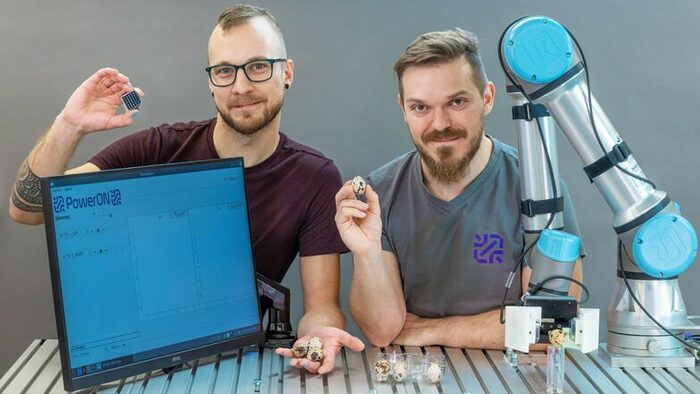
Moving robotic arms are becoming more and more standard in business and industry. Currently, they still have to be programmed in a time-consuming manner so that they can transport certain goods from A to B without damage. This is not a problem for repetitive work processes. However, they reach their limits when it comes to demanding processes that require a delicate touch. PowerON wants to change this and is working on a promising solution: the Dresden-based startup wants to equip robot arms with sentient fingertips and thus turn the gross motorists into agile and flexible workers. A soft silicone pad sits on the fingers of the robot arm, on which there is a wafer-thin film with sensitive sensors printed on it. They let the fingertips feel as soon as they hit the targeted object. The robot then adjusts how strongly it can grip.
For companies, this opens up new possibilities for incorporating robots into production. By handling fragile reagents, robots could be useful aids in the lab. They could unpack return shipments, assist with fruit and vegetable harvesting, or better grip products made of rubber. Safety for working with humans would also reach a new level thanks to the new sense of touch. Ernst-Friedrich Markus Henke, Managing Director of PowerON, explains: "If you get your fingers between the grippers of an industrial robot, the machine squeezes. Currently, it doesn't recognize that there's a human body part in between instead of a component." In the long run, PowerON's innovations could have far-reaching implications for how robots are perceived in the workplace. They could help build confidence in robots and ease fears. For example, they could soon be used to care for sick or elderly people.
The achievements of the robotics company were recently honored with the Start-up Award 2022 from the city of Dresden. Since 2020, CEO Ernst-Friedrich Markus Henke has also been head of a junior research group at the TU Dresden. It is dedicated to researching materials and new manufacturing processes that make flexible robot systems possible.
December 9, 2022 | Record investments in "Silicon Saxony": German global players promote Dresden as a business location
Infineon is planning the largest single investment in the company's history – in Dresden. In November, Infineon Technologies AG published its results for the fourth quarter of 2022: Due to the bulging order books, primarily due to the business areas of e-mobility, autonomous driving, renewable energies, data centers and Internet of Things, the Neubiberg-based group expects sales growth of more than ten percent in the upcoming year – and is therefore expanding its production capacities in the area of 300-millimeter power semiconductors. This is a new design that enables significantly higher production capacity. The sum for the planned facility in Dresden is five billion euros, provided the governments of Germany and the European Union support the project. Around 1,000 new jobs are to be created in Dresden by fall 2026.
The announcement stands out because of the enormous investment sum. Nevertheless, it is by no means the only company that is currently focusing on Dresden as a location. As early as September 6, 2022, the Jenoptik technology group started construction work on its new high-tech factory at Airportpark Dresden. From 2025, micro-optics and sensors for use in semiconductor lithography will be produced there. Jenoptik is investing over 70 million euros; also a record for the company in its recent history. In July 2022, just one year after opening its Dresden fab, Bosch already announced significant capacity expansions and a development center for a total investment of over 300 million euros. "We are also preparing ourselves in the interest of our customers for an undiminished growth in chip demand. For us, there is big business in the smallest components," said Stefan Hartung, chairman of the Bosch board of management, according to Süddeutsche Zeitung. With the construction of the Dresden factory for around 1 billion euros, Bosch had also made the largest single investment in its company history.
December 2, 2022 | AI application hub paves the way for sustainable circular economy
The cheese wrapper, the breakfast yogurt or the shampoo bottle: we all dispose of plastic every day. This generates huge amounts of waste. Innovative solutions are needed to reduce this. Huge potential for this lies dormant in artificial intelligence (AI), with the help of which the sustainability of plastic packaging can be improved enormously. To exploit this potential, the German Federal Ministry of Education and Research (BMBF) has launched the AI Application Hub "Plastic Packaging - Sustainable Circular Economy with Artificial Intelligence". The extensively funded joint project is dedicated to the task of developing recyclable packaging for food, cosmetics and pharmaceuticals. This is a difficult undertaking, as the development and realization of both recyclable and recyclate-based (i.e., made largely from recycled materials) packaging involves regulations and high hygiene requirements. However, the key insight for achieving the project's goal can be gained with AI. It connects, processes and learns from data about the materials and their properties, as well as about the lifecycle stages of a then closed material loop. This results in an interplay between the learning of the AI (so-called learning algorithms) and the learning of the researchers. At the end of this process, it should be clear which materials, packaging, machines and designs are needed to achieve the project goal of recyclable packaging.
The Dresden location of the Fraunhofer Institute for Process Engineering and Packaging IVV is significantly involved, contributing its expertise and experience from more than 50 years of food and packaging science to the innovation laboratory "KIOptiPack". There, practice-ready AI-supported tools are to be developed that enable successful product design as well as the quality-assured production of plastic packaging with a high recycled content. One of the leading minds behind the AI application hub is Prof. Dr. Marek Hauptmann, head of the Packaging and Processing Technologies department at the Fraunhofer IVV. He explains, "With the interdisciplinary team of researchers and other partners from industry and society, the AI Application Hub is pursuing a holistic approach to solutions that tests the diverse possibilities of AI and transfers them into practice. The goal is to close the loop for plastic packaging as much as possible, focusing on the entire value chain from design to re-entry into the loop." TU Dresden is also represented by researchers from two professorships. The Professorship of Machine Tool Development and Adaptive Control is researching how to continuously adapt machines and production processes to compensate for large fluctuations in the recyclability of recyclates. The Professorship of Technical Design, on the other hand, is intensively dedicated to the question of how design can contribute to greater sustainability. Chair holder Prof. Jens Krzywinski: "In our research, the focus is not only on the human-centered development of products, but we are also intensively dedicated to the question of how design can contribute to more sustainability. Especially with regard to the acceptance of sustainable circular economy, this is a topic that should not be underestimated."
November 18, 2022 | 10 Years of Excellence: TU Dresden on the Way to World Leadership
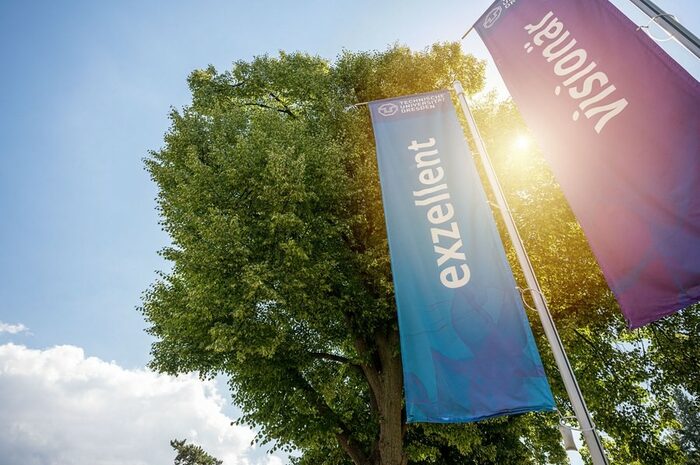
Ten years ago, the promotion of TU Dresden (TUD) as one of the eleven universities of excellence in Germany started - a milestone in the university's history. TUD has been one of the top-performing universities nationwide for a long time – , in some disciplines such as the life sciences and quantum materials even globally. Top international researchers have been recruited for Digital Cultures and the Future of Mobility. The university is also one of Germany's largest centers for interdisciplinary digital sciences as well as artificial intelligence and was instrumental in establishing the National Data Infrastructure (NFDI). Rector Prof. Ursula Staudinger explains, "Excellence is not only a driving force for outstanding research at the frontiers of knowledge - it is an overall engine for innovation."
Prof. Staudinger cites the bundling of competencies from non-university institutions and the university as one of the strengths of Dresden as a location. Thus, the transfer of research results to industry was also significantly expanded during the excellence phase. With 85 priority-securing patent applications and 120 invention disclosures per year, it is now one of the most patent-active universities in Germany. The start-up service ‘dresden|exists’ generates more than 2,000 projects with companies each year and supports around 20 spin-offs. The TUD has given rise to such multi-million dollar companies as Novaled and the robotics start-up Wandelbots. Another important chapter in the success story of the University of Excellence is the ‘DRESDEN-concept Science and Innovation campus’. Twelve years after its founding, a unique science alliance and more than 30 research institutions, including 3 Max Planck, 9 Fraunhofer, 3 Helmholtz and 4 Leibniz institutes, as well as research-based cultural partners such as the Dresden State Art Collections has emerged from the TUD.
The goal now is to perpetuate the status as a university of excellence, according to Prof. Staudinger. "In doing so, we can build excellently on what has been achieved at TUD over the past ten years." To mark the anniversary, the film "Bright Minds. Excellent Research," was produced to provide insight into how passionate TUD researchers are working to find solutions on major global challenges.
When you play the video, a connection to an external website is established, your user information is transmitted and possibly processed there. Further information can be found in the privacy policy. (Privacy policy).
November 11, 2022 | Leading production into the future with AI: New demonstration and transfer center at TU Dresden shows how it's done
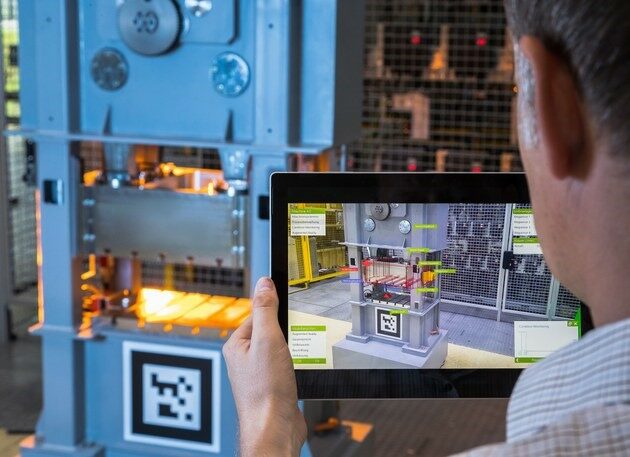
Artificial intelligence (AI) can open up considerable potential in the production and manufacturing industry. But how can small and medium-sized enterprises (SMEs) in particular get started with suitable AI applications? Answers and support are now available from the "Demonstration and Transfer Network AI in Production" at the TU Dresden (ProKI Dresden). Experts from the Faculty of Mechanical Engineering are focusing on forming technology and are introducing companies to the diverse, but hardly widespread application possibilities of AI. The potential in this sector is huge: it can be used to avoid production downtimes and improve quality control. Furthermore, resources can be saved and employees can be supported by collaborative robot systems. The comprehensive and free offer of the emerging center is aimed at manufacturers of forming machines, automation or software companies as well as all branches of industry with forming technology processes. The German Federal Ministry of Education and Research (BMBF) has been funding the ProKI-Net demonstration and transfer network since October 1, 2022, to which seven other universities belong in addition to the TU Dresden. The common goal of the network is to improve the value creation processes of SMEs in manufacturing more quickly, to increase the productivity and quality of components and to use AI potential to strengthen Germany as an economic region.
November 04, 2022 | DUALIS from Dresden enables energy-efficient production and supports mechanical and plant engineering in the crisis
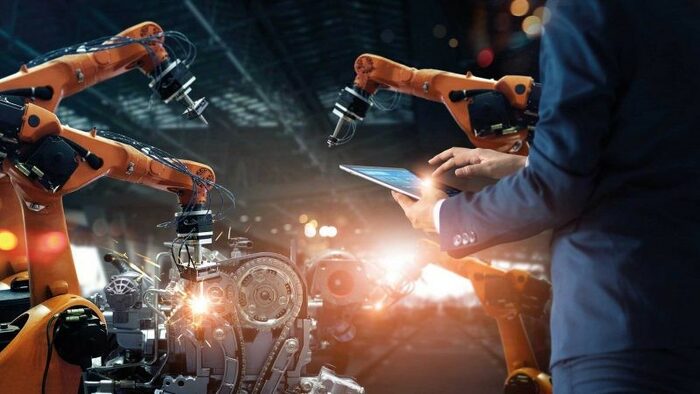
Shortage of materials, shortage of skilled workers, decarbonization of supply chains - the mechanical and plant engineering industry is facing various challenges. Particularly acute are the rising energy costs, which are hitting especially small and medium-sized companies hard. Dresden-based software company DUALIS is helping the industry to save energy by making it easier to plan the regulation of consumption. This is made possible by the planning tool GANTTPLAN, which takes into account various cost points and develops a precise production plan based on them. DUALIS Managing Director Heike Wilson explains: "We want to enable production companies to establish their energy consumption as a fixed parameter in their production planning. With GANTTPLAN, planners can look through different scenarios and find the most energy-efficient options for their own production." For example, the planning tool can weigh whether production is better handled by hand and saves energy, or by machine and saves time. Fluctuating electricity tariffs are modeled, as are high load peaks at certain times of the day.
Dr. Kirsten Hoffmann, product manager of DUALIS, about further development perspectives: "To extend GANTTPLAN, special reports or analysis tables are possible. Thus, on the one hand, the production plan can be analyzed according to energy criteria. On the other hand, a comparison of different simulated scenarios such as different energy contracts, purchase of a new energy-efficient machine and others is conceivable." By supporting companies with various Industrie 4.0-compliant solutions, DUALIS is making a significant contribution to consolidating Dresden's position as a leading smart system location in Europe.
October 28, 2022 | Sunfire produces green hydrogen on a world-record scale
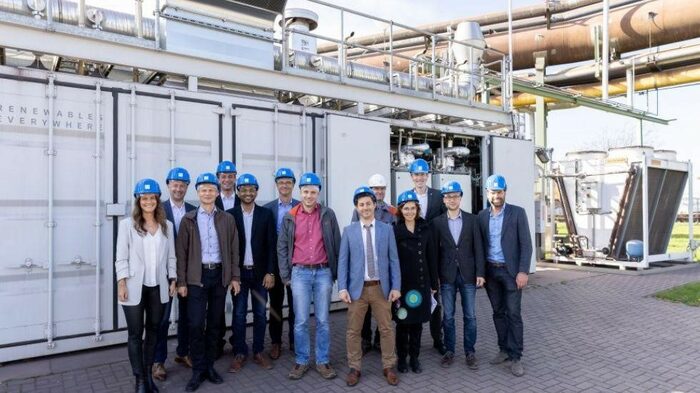
Since 2019, the Dresden-based company Sunfire has been operating a high-temperature electrolyzer on the premises of Salzgitter Flachstahl as part of GrInHy2.0 ("Green Industrial Hydrogen"). The plant is considered the largest and most efficient of its kind worldwide. Now the partners in the EU-funded hydrogen project are drawing a promising balance: almost 100 tons of the valuable gas have been produced in four years for climate-neutral steel production and fed directly into Salzgitter Flachstahl's hydrogen network. This was achieved on the basis of so-called SOEC technology (solid oxide electrolysis cell), in which steam from industrial waste heat is split into its components hydrogen and oxygen with the help of renewable electricity. The Sunfire electrolyzer can produce 200 Nm3 (standard cubic meters) of green hydrogen per hour - an order of magnitude that no other company has yet been able to demonstrate. Sunfire's CTO Christian von Olshausen explains, "GrInHy2.0 is an important lighthouse project for Sunfire, in which we were able to demonstrate our SOEC technology on an industrial scale. At the same time, we have gained valuable insights for further technical development. Projects like this lay the foundation for successful scaling of electrolysis technologies worldwide." The partnership between Sunfire and Salzgitter AG is therefore to be continued beyond GrInHy2.0.
October 21, 2022 | Up to 60 percent savings potential - Dresden-based Fraunhofer FEP develops globally unique window technology
Researchers at the Dresden Fraunhofer Institute for Organic Electronics, Electron Beam and Plasma Technology (FEP) have succeeded in producing the world's first thermochromic layer on thin glass in a roll-to-roll process. Dr. Cindy Steiner, group leader at Fraunhofer FEP, is pleased: "We have thus taken an important step in scaling the technology from laboratory to pilot scale!" The next step is to scale up the technology and bring it to market. By using thermochromic coatings, the FEP research team has succeeded in regulating solar radiation in thin glass windows according to weather conditions. Thermochromic means that the windows change from a transmissive to a reflective state at a temperature of around 20 degrees Celsius - in other words, the solar radiation is blocked. Mechanical blinds could thus soon be a thing of the past. Above all, however, the technology has great potential for energy savings: In extreme cases, a building's cooling and heating energy requirements can be reduced by up to 60 percent. Office complexes, public buildings and new buildings with large, south-facing windows and glass facades will benefit particularly from this innovation. Smart windows can thus make an important contribution to the energy turnaround.
October 14, 2022 | New diabetes center in Dresden explores innovative methods for treating type I diabetes
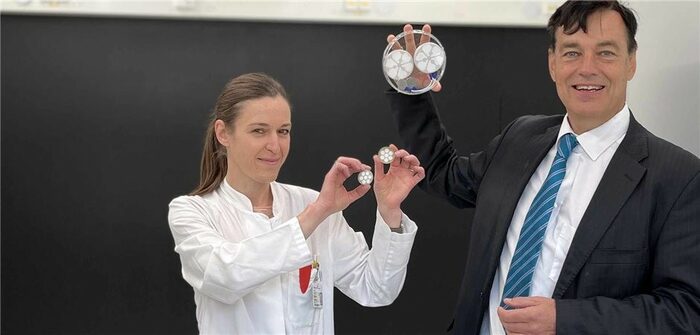
In Germany, more than 6 million people suffer from diabetes. Every year, 500,000 people are newly diagnosed with the disease. And in the last 25 years, the number has risen by more than a third. The statistics show: To put a stop to the widespread disease of diabetes, innovative and more efficient methods are needed to treat rampant metabolic diseases. In the future, researchers at the Center for Metabolic-Immunological Diseases and Therapeutic Technologies Saxony (MITS), which recently began operations, will devote themselves to this task.
Special attention is being paid there to scientific work on the so-called bioreactor, which is intended to make everyday life easier for patients with type I diabetes. Professor Stefan R. Bornstein, the MITS spokesman, explains: "You can think of it like a pacemaker: A small can of five to six centimeters in diameter that is transplanted onto the peritoneum, under the skin." Enclosed in the bioreactor are beta cells, for example from pigs, which are protected from defense mechanisms of the human body. The trick: The cells can produce insulin independently and deliver it to the body. Insulin injections and pumps thus become superfluous. In addition to research on the bioreactor, secondary diseases caused by diabetes and other metabolic disorders are also being studied. These can affect blood vessels, the heart, kidneys, liver or bones. The aim is to prevent them and enable the regeneration of cell functions. The federal government and the Free State of Saxony financed the new buildingwith more than 35 million euros. It provides space for around 100 employees.
October 07, 2022 | Robots welcome as big and small helpers, especially among young people
Whether as a supporter in cleaning work, in the garden or in care - robots are no longer only at home in industry, but are used in a wide variety of work and everyday areas. This is also reflected in the responses to the German Robotics Mirror 2022, which was launched by the German Robotics Association in cooperation with the Office for Economic Development of the City of Dresden and Dresden Marketing Gesellschaft. Younger people in particular can well imagine the use of robots in various fields of application, such as caring for relatives or in entertainment. But even regardless of age, the majority of respondents see robots as having the potential to improve our everyday working lives - more than two-thirds (67.5 percent) of them see robotics as an important future industry for Germany as a business location.
However, the idea of "robots as colleagues" has not yet caught on. When asked what role robots should most likely take on in companies in the future, the vast majority of respondents (76.2 percent) still favor the robot as a machine. The Dresden-based robotics software company Wandelbots would like to change that. "Normally, the implementation of robotics processes is very complex," says Christian Piechnick, CEO and founder of Wandelbots. "Until a robot is ready for use, experienced developers have to program every single step. High costs and a lack of skilled personnel currently hinder the acceleration of automation. This is exactly where we come in." To this end, the company offers the no-code solution Wandelbots Teaching, which enables users to teach robots independently without having any programming knowledge.
In addition to Wandelbots, many players in Dresden are jointly driving development forward, so that the idea of the "colleague robot" could soon become reality. Thomas Schulz, managing director of Robot Valley Saxony, sees the state capital as a hub for synergies that are unique in Germany: "Robot Valley Saxony is the robotics ecosystem in the heart of Europe, actively networking experts from industry, research and startups to promote innovation and growth in the robotics sector in Saxony and beyond."
September 30, 2022 | Together into the future – German Aerospace Congress 2022 in Dresden
Researching together and shaping the future sustainably: This was the motto of the German Aerospace Congress (DLRK), which was held in Dresden this year. From 27 to 29 September, around 500 experts from science and research, industry and politics came together. In many lectures and discussion rounds, the expertise of the location was especially highlighted. Eventually, Dresden offers ideal conditions: There are excellent research institutes and universities.
Aerospace will continue to be promoted in the future. In addition to well-known companies such as Elbe Flugzeugwerke GmbH (EFW), Diehl Aviation or Nehlsen-BWB Flugzeug-Galvanik, the city is particularly attractive for young start-ups. With Herone and Morpheus Space, two promising young companies have settled in Dresden. The space start-up Morpheus Space plans to build a factory in the city to produce thousands of propulsion systems annually.
Aerospace has a long tradition in Dresden: aircraft construction began in the city in 1955. A few years later, Germany's first jet-powered passenger aircraft – a symbol of GDR aircraft construction – was developed in a hangar not far from the German Hygiene Museum. Since that time, large hangars have dominated the cityscape. And even today, passenger aircraft from all over the world are maintained and converted at cargo planes.
September 16, 2022 | In search of plastic substitutes - EU project led by Saxony conducts research into recyclable product materials
Fruits and vegetables wrapped in foil: This is what you see in many supermarkets. In this way the food is supposed to be preserved for longer. However, this is not particularly sustainable. And this is just one example of many.
The industry could record up to 80 percent of a product's subsequent environmental impact, learn from it and act accordingly – already at the design stage. That's according to an assessment by the European Union's Circular Economy Action Plan. However, the linear manufacturing pattern so far has offered few incentives for this. This should change in the future: The ReMade@ARI research infrastructure project, coordinated by the Helmholtz-Zentrum Dresden-Rossendorf (HZDR), is working to develop new materials that are recyclable and competitive as well. In the future, for example, bio-based materials made of wood could provide a sustainable alternative to plastic packaging. The participating institutions also want to exploit the potential in the fields of electronics and textiles. The project is being funded by the EU with a total of 13.8 million euros.
"Anyone from science but also from industry, who wants to develop a new, recyclable material, can approach us," said Dr. Stefan Facsko, scientific coordinator of the project and head of the Ion Beam Center at HZDR. From the research infrastructures, the one where the required research can best be implemented will ultimately be selected.
September 09, 2022 | Rare earths from old energy-saving lamps: Leschs Kosmos about recycling revolution of Helmhotz researchers
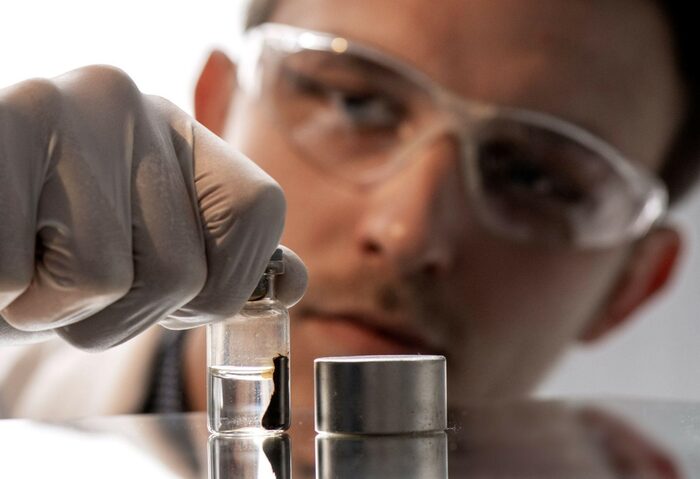
Technological progress is drastically increasing the demand for raw materials. Electronic devices devour high-tech materials such as rare earths. Since natural resources are limited, innovative solutions are needed. Worn-out electronic products, for example, contain such valuable elements. Researchers at the Helmholtz-Zentrum Dresden-Rossendorf (HZDR) have now developed a process to recover rare earths from fluorescent lamps. This is an example that recovery of the elements contained is possible and economically viable. The key to the targeted recovery of rare earths is provided by bacteriophages: viruses that primarily infect bacteria. By combining this with a special magnetic separation process, the researchers have succeeded in selectively filtering raw materials out of mixtures of substances and reusing them. For the recovery, they use magnetic separation based on biocollectors. "In the future, we will be able to bring the rare earths recovered by biocollectors back into the cycle, which will simultaneously reduce the enormous amount of hazardous waste," says Dr. Franziska Lederer, head of the BioKollekt junior research group, explaining the potential for a sustainable economic cycle. Sounds complicated? This innovative recycling also interested the ZDF science series Leschs Kosmos, which illustrates the process in the current episode "Der Schatz in der Mülltonne - Das Recycling-Versprechen".
Read more
September 01, 2022 | German Robotics Mirror 2022: Robots still controversial for securing skilled workforce
In Germany, robotics has risen to become one of the most important technologies of the future and an economic driver in recent years. This trend is also reflected in the latest results of the German Robotics Mirror 2022. In this survey, more than two-thirds of respondents (67.5 percent) rate robotics as an important future industry for Germany as a business location. The survey was initiated by the German Robotics Association in cooperation with the Office for Economic Development of the City of Dresden and Dresden Marketing Gesellschaft. What the mirror also shows is that further education is needed to overcome prejudices in the world of work and to close knowledge gaps.
This is particularly clear when it comes to the issue of a shortage of skilled workers: One in three employed people who have already worked with robots sees the technology as a possible solution to the problem. By contrast, the proportion of employees without experience is significantly lower at 16.2 percent. Dr. Robert Franke, Head of the Economic Development Department in the state capital Dresden, explains: "Today, you don't have to invest millions or have programming skills to automate your processes effectively. We still see a lot of potential here, especially among SMEs." Accordingly, a clear work assignment for policymakers emerges from the survey results. The goal must be to bring the topic of robotics closer to the population in order to dispel unfounded fears. Olaf Gehrels is a board member of the German Robotics Association (Deutscher Robotik Verband e.V.) and says: "We have to emotionally convince operators and operators, especially in SMEs, that robots are a help and not a competition on the shop floor."
One of the driving forces behind Germany's efforts to further expand its status as the leading robotics industry in Europe is the city of Dresden. As "Robot Valley Dresden," it is pursuing a strategy with three focal points: Educational work, technology promotion in research and practice, and networking in the form of congresses and exhibitions that provide the industry with opportunities to exchange knowledge.
August 26, 2022 | Go-ahead for Drakore: Mobile communications network of the future being built in Dresden
Mobile networks are real power guzzlers. Radio access networks alone consume around 750 GWh annually, which is equivalent to the energy consumption of 250,000 private households. By 2030, energy consumption could double. To prevent this from happening, new projects are constantly being launched at the Dresden technology site to pave the way for the mobile communications of the future. One of these is TU Dresden's DAKORE project, which is designing an energy-saving mobile communication base station using novel AI methods. With this approach, which could enable energy savings of up to 60 percent, the DAKORE team was also able to convince at the "GreenICT". They were among the three winning teams in the 2021 Innovation Competition of the German Federal Ministry of Education and Research (BMBF).
Project leader Prof. Frank Ellinger emphasizes that the concept will not only be used to modernize the existing mobile radio network in the future, but will also be used for further network expansion in future macro and micro base stations: "With the help of DAKORE, Germany can significantly strengthen its competencies in the new scientific field of AI-driven optimization of radio access networks and make a significant contribution to reducing energy consumption," says Eillinger.
August 18, 2022 | Robotics software optimizes warehouse automation: International investors support revolutionary technology from WAKU Robotics
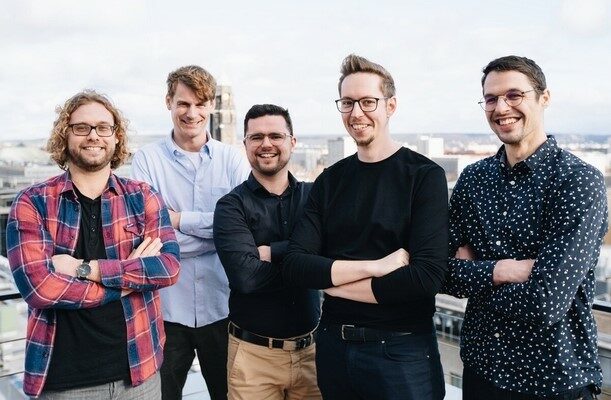
The future of logistics will be defined by collaboration between humans and robots. With it´s product WAKU Sense, the Dresden-based startup WAKU Robotics is making an important contribution to innovative robotics solutions and is thus making its mark on Robot Valley Dresden. The software solution supports robot operators in controlling and coordinating mobile robots in various industries. Victor Splittgerber, founder and CEO of WAKU Robotics, explains: "With WAKU Sense, we empower human operators to ensure the smooth operation of robot fleets. The tool supports customers in this revolutionary transition to even more advanced warehouse automation." Current customers and international partners are also convinced of the potential of the innovative technology. A new investment investment of 1.5 million euros is expected to accelerate the development of WAKU Sense's software. Franz Humer is founder of Agilox, a leading manufacturer of autonomous mobile robots and part of the seed investment round. He says, "WAKU Sense is the first platform capable of orchestrating different AMR/AGV vendors. It puts everything on one dashboard and integrates sensors, forklifts and human operators. Sense is made for robot operators who need to work with more than one robot vendor.
Read more
-
Mobil Robot Guide
"Waku Robotics secures new investment to build AMR software"
- About WAKU Robotics
12.08.2022 | “Knock, knock, it’s 6G.” Barkhausen Institute Dresden founds "Corenext" project for Europe's technical independence in the mobile communications of the future.
The currently most powerful mobile communications standard, 5G, has been fully operational in Germany for just two years - but the network of the future, 6G, is already just around the corner in Dresden. 6G will unleash previously untapped potential not only for cell phone users, but also for the IoT (Internet of Things) and thus for the economy. To ensure that European companies are less dependent on suppliers from Taiwan, South Korea or the USA in the future, the Barkhausen Institute at the Dresden site has launched the "Corenext" project.
Over the next three years, a consortium of 23 partners, including strong international brands such as Nokia, Ericsson, Infineon and NXP, will develop their own processors, antennas, reliable architectures and operating systems for the 6G mobile communications standard. The announcement was made by designated project leader Michael Roitzsch and institute co-managing director Tim Hentschel.
The project is funded with 13 million euros from the EU and has big goals: "The ultimate goal is to develop the prototype of a multiprocessor system that European companies can use to build their own circuits," Hentschel explains.
The Dresden engineers are planning another coup: by declaring the project open source, i.e. making the hardware and software components publicly accessible, sabotage of the later products by secret services, industrial spies or cybercriminals will be virtually impossible. Corenext - another key European project at the high-tech location Dresden.
August 03, 2022 | 45 million euros to combat innovation backlog in medical technology: Federal government funds SEMECO project at TU Dresden for simplified approval processes
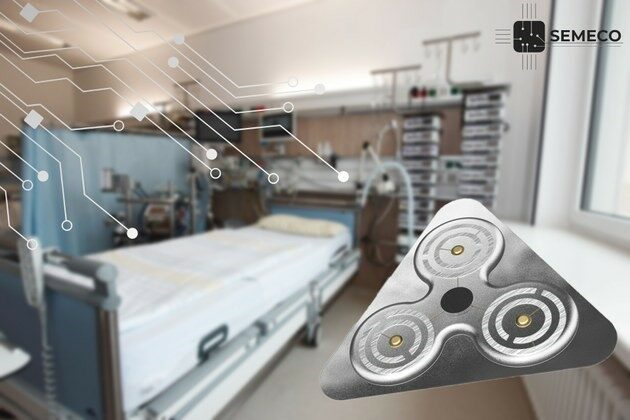
Innovation cycles in medical technology are becoming longer. This is due to increasingly complex technologies and systems on the one hand and ever more demanding and lengthy approval processes on the other. This is why the Technical University of Dresden has launched the SEMECO (Secure Medical Microsystems and Communications) project. Traditional medical regulatory procedures are to be revolutionized in the medium term by artificial intelligence (AI) methods. The interaction of measurement technology, communications technology and information processing will enable smart medical instruments and implants to be developed and approved more quickly. A new platform approach will also enable safe and medical microsystems.
The German Federal Ministry of Education and Research is now funding this innovation cluster at TU Dresden with 45 million euros over the next nine years. One of the strengths of the project lies in the regional bundling of scientific expertise of Saxon research partners. Together with the Else Kröner Fresenius Center for Digital Health, the 5G++Lab Germany, and the Barkhausen Institute, the SEMECO future cluster offers ideal conditions for innovative and sustainable collaboration at one of Europe's leading locations for microelectronics, communications engineering, and explainable AI in Dresden.
SEMECO is one of seven clusters in Germany selected from 117 applications in the second round of the Federal Ministry of Education and Research's Clusters4Future competition. "Our entire team is delighted. Together, we want to create a system that increases the innovation and future potential of the semiconductor and microsystems technology industry for medical technology. The necessary safety requirements have to be taken into account, however we must produce added value for patients much sooner," said Gerhard Fettweis, Professor of Mobile Communication Systems at TU Dresden and scientific coordinator of the SEMECO project.
Read more
July 26, 2022 | SurFunction GmbH founds subsidiary in Dresden to establish sustainable laser technology in industry
Only two years ago, SurFunction GmbH emerged from the spin-off of TU Dresden (TUD), Saarland University and the Material Engineering Center Saarland. Now it is founding its own subsidiary, SurFunction Tec GmbH, which will enrich the high-tech location of Dresden with its know-how in the field of laser beam interference patterning (xDLIP). The highly sustainable xDLIP method uses pulsed lasers to create microscopically small structures that make products more durable, sustainable and efficient. The founders' goal is therefore to firmly establish the technology in industry in the coming years. The first fields of application have already been identified - in the automotive industry, medicine, security technology and even space technology: "Our technology has made it to the International Space Station ISS in several projects, where it was tested by our German astronaut Matthias Maurer," says Dr. Dominik Britz, Managing Director of SurFunction GmbH. Together with Dr. Bogdan Voisiat from TU Dresden, he is now also taking over the management of the subsidiary. "With the strategic decision to establish SurFunction TEC in Dresden, we are also following the recent technology settlements in the Dresden region. With our xDLIP technology, we see many interesting interfaces and further innovation potential," says Voisiat. Thanks to the close cooperation with universities, the rapid transfer of research results into practice is also ensured.
Read more
July 18, 2022 | Carbon concrete bridge from TU Dresden awarded: Double honor at fib congress in Oslo
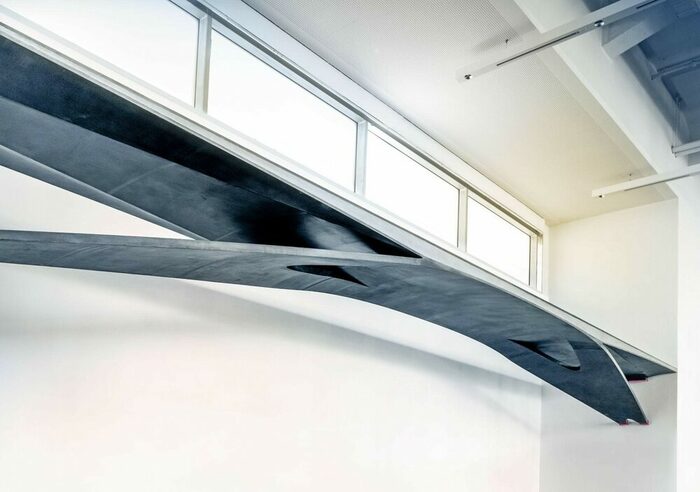
Visitors to the Deutsches Museum in Munich can currently admire the CarboLight Bridge, which was designed and built by scientists from TU Dresden. What's special about it is that thanks to the innovative construction method using carbon and infralight concrete, the bridge not only boasts a slim design, but the filigree structure has also been built in a way that is particularly resource-friendly. These properties have now also attracted the attention of the Fédération international du Béton (FIB), the international concrete association. It presented the carbon concrete bridge with two awards at the renowned fib Congress in Oslo: the special prize in the competition for exceptional concrete structures and the 'Innovation Award 2022' for a paper describing the process from design to implementation. Civil engineer Marc Koschemann, who planned and supervised the construction of the bridge, is delighted with the award and sees further need for action in the use of lightweight materials in the industry: "The construction industry must change significantly so that we can build in a way that conserves resources and reduces CO2 emissions in the future. The use of innovative building materials such as carbon concrete is fundamental to achieving this goal." An important innovation driver in this field is the Dresden-based association "C³" (Carbon Concrete Composites), which is working to bring the building material to market. On their way to practical maturity, the Free State recently granted them funding of 2.15 million euros. According to Saxony's Minister of Economic Affairs, Martin Dulig, the aim is to further expand the knowledge and technological lead that already exists.
July 6, 2022 | Robert Habeck gives Sunfire from Dresden the go-ahead for series production of electrolyzers

Green hydrogen is one of the most important energy carriers of the future, which is why the science location of Dresden is driving the development of the technology in research and industry. One of the key players in this field is the Dresden-based company Sunfire, which wants to bring electrolysers for the production of green hydrogen into series production. For this project, the electrolysis specialist recently applied for financial support under the European funding program "Important Projects of Common European Interest" (IPCEI). Although approval of the funding from the EU Commission is still pending, the German Federal Ministry of Economics and Climate has already approved the early start of the measures. "Sunfire can thus get started as one of the first companies within the framework of the major joint European project. This is a strong sign - also for Germany and Saxony as a business location," explains Economics Minister Robert Habeck, adding, "Especially in these difficult times, we need to move the ramp-up of the hydrogen economy all the more quickly. The industrial series production of electrolysers is a very important building block for this." Sunfire CFO Stephan Garabet is delighted with the signal from Berlin: "The approval for an early project start underscores our central role in the hydrogen value chain. With the funding, we can scale up significantly faster, more innovatively and more extensively than we would be able to with our own resources."
Read more
July 1, 2022 | Cancer therapy with AI: More effect, less side effect
As a leading smart health location, Dresden is one of the key drivers of progress in cancer research. Now, with the participation of Dresden's OncoRay Center, a new international consortium is joining forces to achieve a new standard of radiotherapy. This is to be achieved with adaptive proton online radiation therapy (ProtOnART), which gives the consortium its name. Radiation therapy with protons is a treatment method that is already used in everyday practice. It is considered particularly gentle and effective because it spares the tissue surrounding the tumor to the maximum. However, the anatomical changes of the treated patient are a challenge: Tumors and organs can both change position and vary in size from day to day. To address this challenge, the consortium aims to develop an AI-based proton therapy that detects anatomical changes in near real time. Prof. Mechthild Krause, director of OncoRay in Dresden emphasizes, "Our vision is to develop the technologically and clinically best possible radiation therapy. We achieve this by optimally exploiting the physical advantages of protons, even for variable anatomies. With ProtOnART, we aim to bring AI-assisted adaptive proton therapy to clinical reality, benefiting especially patients with highly variable and mobile tumors." In addition to the OncoRay Center in Dresden, PARTICLE and In Beam Applications (IBA) from Belgium as well as Ray Search Laboratories from Sweden are contributing their technical expertise to the international research project.
Read more
June 31, 2022 | Innovations for the energy transition: Institute for Energy Technology in Dresden moves into new research building
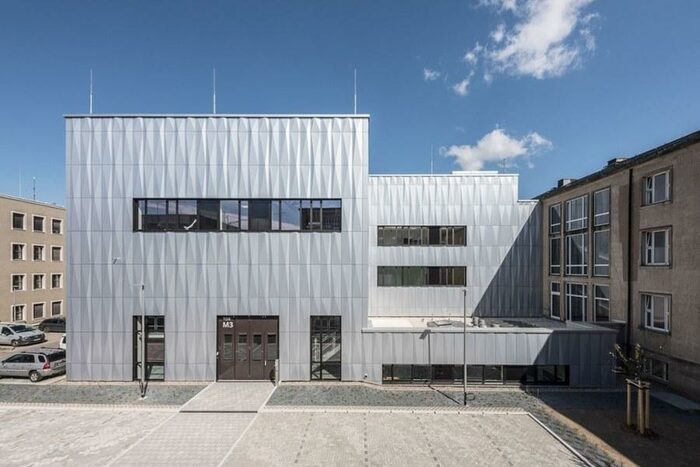
More independence through renewable energies and modern storage technologies - a goal that has been pursued in Dresden not only since the Ukraine war. As one of the leading greentech locations in Europe, the state capital has been driving the energy transition for many years. In the future, a new research building on the TU Dresden campus, which was opened by the Institute of Energy Technology (IET) on June 20, 2022, will contribute to this. It offers the institute's 22 scientists optimal conditions for their research. Thanks to interlinked test and laboratory halls, the innovative new building favors networked work and has space for a total of three professorships. These professorships develop new technologies for energy generation and storage, including hydrogen, nuclear energy, and cooling and heating technology. Concrete applications include research into alternative refrigerants for electric vehicles or household appliances. On the occasion of the opening of the new building, Saxony's Science Minister Sebastian Gemkow (CDU) emphasized: "The success of the energy turnaround depends decisively on how well research in the field of energy technology is positioned. Ultimately, the projects that are realized here will result in benefits for society as a whole."
Read more
June 14, 2022 | From research directly into practice - National Lightweight Construction Validation Center opened.
Lightweight construction technologies are an important key to shaping the future of the economy, which is why the Institute for Lightweight Construction and Plastics Technology (ILK) at TU Dresden has been researching their development since 2010. In order to transfer the results of this research into industrial practice even faster in the future, it has now founded the National Lightweight Design Validation Center (LEIV), a new facility that is intended to benefit small and medium-sized enterprises in particular. At the LEIV's opening ceremony, board spokesman Prof. Maik Gude spoke of a milestone in European lightweight construction research: "Our efforts to take a sustainable approach to the development and manufacture of largely resource-neutral high-tech products are coming to life here at the LEIV." Dr. Robert Franke, Head of Economic Development, and Michael Kellner, Green Party State Secretary at the Federal Ministry of Economics and Climate, were also on hand for the event. One of the new center's first central goals is to reduce resource consumption in the manufacture of high-tech lightweight structures by 80 percent up to 2030. In this way, Dresden's lightweight construction research is making an important contribution on the way to an environmentally friendly circular economy. With the ILK at the helm, Dresden is one of the most important European locations in this research field.
Read more
June 7, 2022 | New center for semiconductor research opened in Dresden
In the direct vicinity of the chip giants Bosch, Global Foundries and AMTC, a lighthouse of semiconductor research with international appeal has emerged: The Center for Advanced CMOS & Heterointegration Saxony, which was officially opened on June 7. In the future, two Fraunhofer Institutes will bundle their competencies here. Their cooperation helps to attract semiconductor companies and system users as well as material and equipment manufacturers from all over the world and to bind them to the location around Silicon Saxony. "Thanks to the close cooperation between the two research institutions made possible by the center with its 4,000 square meter clean room, optimal conditions have been created for outstanding semiconductor research," says Dr. Manuela Junghähnel. Together with Dr. Wenke Weinrich, she will head the center and drive research with state-of-the-art 300 millimeter wafers. Dr. Robert Franke, Head of the Economic Development Department, is also convinced of the charisma of the new research location: "Fraunhofer's new center is an invaluable asset for Silicon Saxony and, more specifically, for our semiconductor campus at Airport Park. This is where the next chapters of Europe's leading microelectronics location will be written."
June 7, 2022 | Volkswagen group IT moves in Universelle Werke
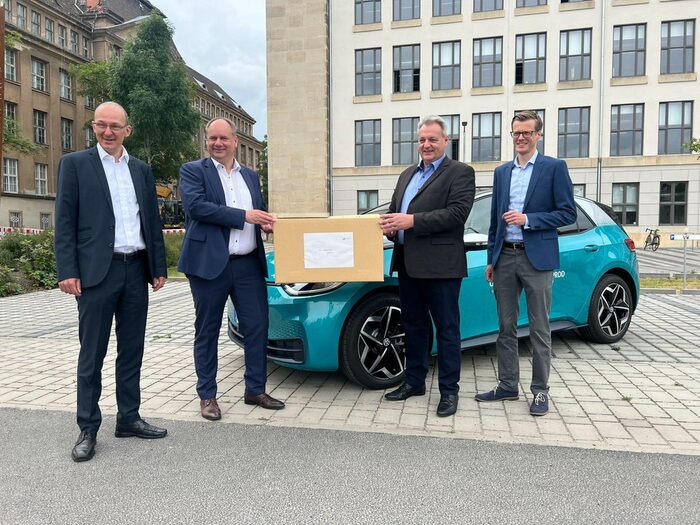
Volkswagen has moved its IT research unit for networking the production of all VW locations into the Innovation Center Universal Works - Dresden's largest innovation hub. The building is operated by Technologiezentrum Dresden GmbH, in which the city also holds a stake. Mayor Dirk Hilbert personally welcomed the new tenants: "Volkswagen not only built the Transparent Factory in Dresden, but has since been driving innovation throughout the city, creating value at the location." A goal to which the Dresden Economic Development Agency and its head Dr. Robert Franke are also dedicated: "Our task as economic developers is to create suitable space for innovative companies and start-ups and then to bind them to Dresden in the long term through support and networking." Prof. Dr. Uwe Wieland, head of the Dresden location of the VW Group Software Innovation & Development, explains how things will continue: "In three years, we have grown to 50 IT specialists. With the so-called Industrial Cloud, we will network all 120 of Volkswagen's group-wide manufacturing plants." One focus is on the use of artificial intelligence, which adequately replicates human vision. "With the pioneering role of TU Dresden and HTW Dresden in communications technology, the city has clear locational advantages," says Wieland.
May 27, 2022 | TU spin-off Heteromerge develops 3D multi-material printer for the nanometer range
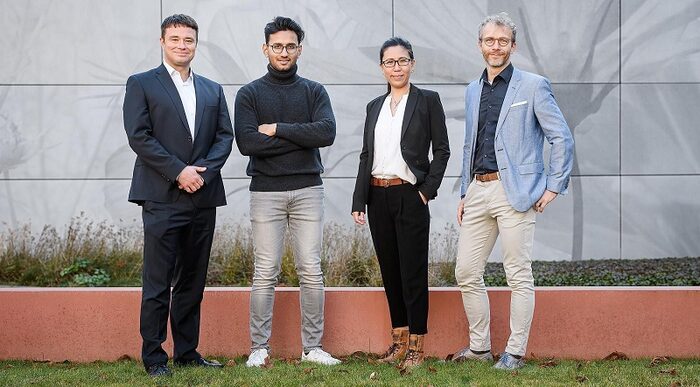
As a spin-off of the research group "3D Mesoscopic Systems" at the Center for Advancing Electronics Dresden (cfaed) at TU Dresden, the startup Heteromerge specializes in the development of high-precision 3D printers. Within the scope of its research, it has developed a patented process for automated material exchange that is capable for the first time of performing multimaterial printing with structure sizes of up to 100 nanometers. This is possible due to the high accuracy of the print head used, which places realignments after material exchange with an accuracy of up to 10 nanometers - independent of the print substrate. This means that the technology can be used on silicon and glass as well as on passive and active printing substrates, such as LEDs or lasers. In order to bring the novel process to market as quickly as possible, Heteromerge has been participating in the EXIST funding program of the German Federal Ministry of Economics and Climate Protection since May 2021. The Dresden-based company has also applied with its innovative technology for the futureSAX audience award of the innovation platform of the Free State of Saxony.
May 20, 2022 | TU neurobiologist Catherina Becker receives Humboldt Professorship
On May 12, 2022, the time had come: Catherina Becker, neurobiologist at TU Dresden, received the Alexander von Humboldt Professorship, the most highly endowed international research award in Germany. The focus of her research at the Center for Regenerative Therapies Dresden (CRTD) is the regeneration of the central nervous system, the brain and the spinal cord. To this end, the world's leading neurobiologist is investigating mechanisms in the spinal cord of zebrafish, which have a special regenerative capacity. Even as a young doctoral student, Becker was fascinated by the ability of fish and frogs to repair their nervous systems which humans can't. "As one of the leading institutes in the field of regeneration research, the CRTD is a very attractive research environment that offers me many research and collaboration opportunities," says Prof. Catherina Becker. "I am very happy to be able to work at the CRTD at TU Dresden with the support of the Humboldt Professorship. Here I am part of the Johannstadt Campus, which offers wonderful opportunities for research collaborations with the surrounding institutes."
May 13, 2022 | Hightech-Gründerfonds passes the baton: Dresden-based startup Arioso Systems acquired by Bosch
Smaller than a one-cent coin and yet with excellent sound - the market for micro-speakers is developing rapidly. At the forefront of this development is Dresden-based startup Arioso Systems, which is working on the market launch of high-performance and energy-efficient micro-speakers. It uses a special technology called "Nanoscopic Electrostatic Drive" developed at the Fraunhofer Institute for Photonic Microsystems (IPMS). The project team at the IPMS, which is based in Dresden and Cottbus, is also where Arioso's founders came from, having brought the technology to market maturity in recent years with the financial support of the Hightech-Gründerfonds. With the entry of Bosch Sensoric, the startup now wants to bring its micro-speakers into mass production and sell them to manufacturers of Bluetooth headphones and smartphones, such as Apple or Sennheiser. The special feature: The membranes of Arioso loudspeakers have an unusually large volume because, unlike the competition, they use not only their surface but also vertically arranged lamellae as a sound space. As a result, this leads to higher energy efficiency and greater sustainability, making Arioso one of the world's most innovative suppliers of micro loudspeakers. Market experts forecast strong growth for this market segment in the coming years. According to tech specialist Yole, for example, the total market for micro speakers is expected to grow from $9 billion in 2020 to $11 billion in 2026.
May 6, 2022 | European Research Council distributes million-dollar grants to TU Dresden scientists
Fresh money for top research from Dresden - the European Research Council (ERC) makes it possible. The renowned institution intends to make around 5.3 million euros available from its funding pots for three TU scientists in the future. The special feature: The funds of the so-called ERC Grants are one hundred percent subsidies, which can be used by the research groups for all costs and requirements of their projects. The three TU scientists Prof. Dr. Triantafyllos Chavakis, Prof. Stefan Kaskel and Prof. Andreas Deutsch can be pleased about the funds. Triantafyllos Chavakis is Director of the Institute of Clinical Chemistry and Laboratory Medicine and, together with his team, is researching the development of metabolic inflammation. To better understand the disease, the team is pursuing an innovative approach in which the mechanisms of inflammation are investigated both locally at the cellular level and holistically at the level of the immune system. Andreas Deutsch of the Center for High Performance Computing is also dedicated to fighting disease. With his funding, he aims to develop chemo-immune therapies against tumor diseases based on a novel experimental method and mathematical modeling. Stefan Kaskel from the Faculty of Chemistry and Food Chemistry takes a different approach, working with his team on the development of a biological interface between humans and computers. Among other things, the technology should reduce the energy consumption of computers and enable on-chip energy management in autonomous microelectronic components. For TU Dresden, the three grants already represent the second award from the ERC grant pots in 2022. In total, the funds from the program now amount to over seven million euros.
Read more:
April 28, 2022 | TU spin-off "herone" is ready for series production
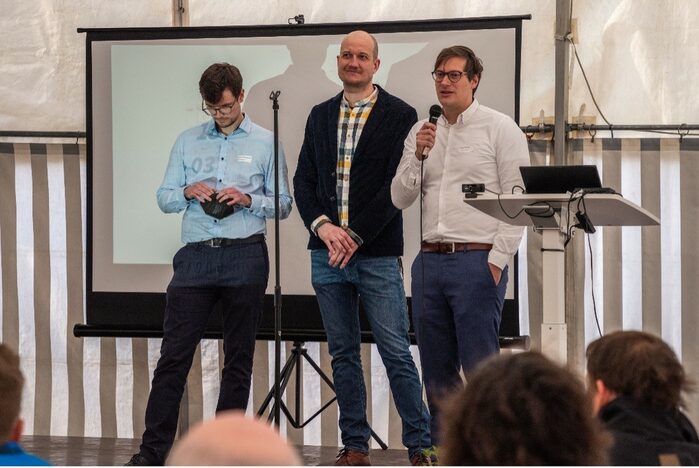
Launched in 2018 as a spin-off of TU Dresden, "herone" has developed a special production technology for lightweight components over the past few years, with which the company intends to supply the aviation industry in the future. The facilities required for this, plus the production hall, have now been inaugurated by herone in a ceremony. After successful commissioning, the company's 13 employees will be able to produce up to 20,000 components per year. In total, the startup received financial support amounting to around 4.6 million euros. The Wirtschaftsförderung Dresden also supported herone in 2018 with an innovation grant as well as the procurement of premises and later with the construction of the new production hall. With its ultra-lightweight components made of recyclable plastics, herone aims to support aviation in the development of emission-free machines. "Our goal is to offer solutions to overcome boundaries, and thus make our contribution to tackling global societal challenges," says co-founder Christian Garthaus.
April 21, 2022 | Progress in deuterium extraction: TU Dresden filters the fuel of the Starship Enterprise
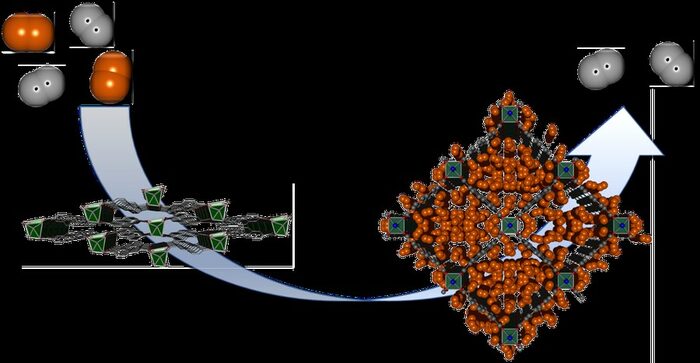
The Starship Enterprise already flew through the galaxy using deuterium as fuel. Even though this was science fiction from the 1960s, research is still being done today on the real application of the hydrogen isotope for energy production. Because deuterium, the heavy brother of hydrogen, is considered a promising substance of the future due to its broad range of applications: whether in science, for energy generation or in the production of medicines. However, the extraction from the natural isotope mixture of hydrogen has so far been complex and expensive. This could now soon be done more efficiently and cost-effectively: with a porous material developed at the Technical University of Dresden. In an interdisciplinary collaboration, the groups of Prof. Stefan Kaskel and Prof. Thomas Heine from TU Dresden, together with Dr. Michael Hirscher from the MPI for Intelligent Systems Stuttgart, have developed a novel separation mechanism for the hydrogen isotopes. This is based on the flexible metal-organic framework "DUT-8" developed at TU Dresden. "Our material enables the separation of gaseous deuterium D2 from hydrogen H2. DUT-8 is highly flexible and can dynamically adjust its pore size. However, this structural reaction proves to be highly selective: only deuterium can open the pores, while hydrogen keeps the framework closed. This highly selective recognition leads to high selectivity with simultaneous high deuterium uptake," explains Stefan Kaskel, Professor of Inorganic Chemistry at TU Dresden.
April 14, 2022 | Innovative technologies for the handicraft business: hand prostheses using 3D printing
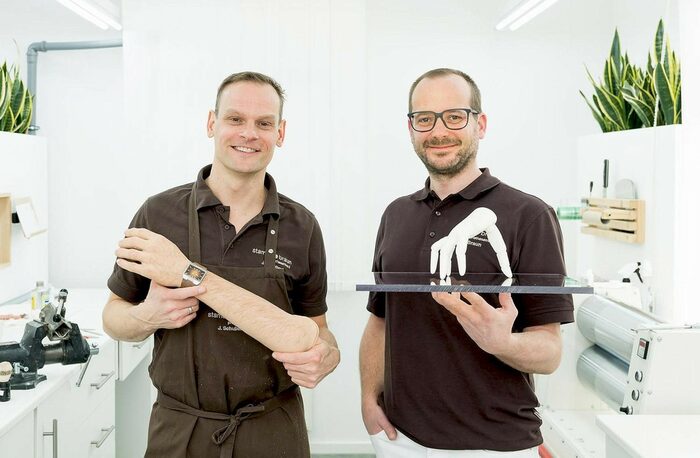
Using a 3D printer, the Dresden-based company "Stamos + Braun" has succeeded in producing customized silicone prostheses from medical silicones - with remarkable results. The high-quality silicone parts, for example, weigh up to 40 percent less than conventional specimens and can also be manufactured with significant material savings. The reason: the robust and viscous silicones are created digitally and printed at high temperatures with minimal quantity input. The process represents a completely new technology and a milestone in the production of prostheses. A particular challenge here is to print the prostheses in full color. Together with the Technical University of Dresden, however, "Stamos + Braun" has succeeded in authentically reproducing the color and shape of lost limbs. The aim of "Stamos + Braun" is to increasingly erode the boundaries between "artificial" and "real". The use of digital technologies plays an important role in this. In order to share his experiences in this field with other craft businesses, Managing Director Christoph Braun will be taking part in the "Zukunftsland Sachsen" conference on April 13, 2022. Under the motto "How digitization helps Saxony's skilled trades", experts will be there to exchange views on the potential of digital tools in the skilled trades.
April 7, 2022 | Turning body heat into electricity: This is how the TU Dresden wants to make organic high-performance thermoelectrics possible
Charging cell phones using body heat - what sounds like dreams of the future could soon become reality thanks to new findings in thermoelectrics. An important step in this direction is the development of organic semiconductors at the Institute of Applied Physics (IAP) at TU Dresden. Compared to inorganic materials, organic semiconductors are more flexible and at the same time lightweight and have low thermal conductivity. Until now, however, the technology has always had limitations in terms of conductivity. Researchers at TU Dresden have now been able to circumvent this, by developing a highly efficient modulation doping for the thermoelectric components. The results were recently published in the renowned journal "Science Advances". Team leader Prof. Karl Leo sees great potential in the research: "Our work paves new paths to flexible thermoelectric devices that make it possible to generate electrical energy directly from heat in an elegant and efficient way."
April 1, 2022 | Dresden startup funding for Carbon Clouds: With duckweed to clean water and biomass
Killing two birds with one stone - that's the plan of Dresden-based biotech startup Carbon Clouds. The company has developed a method in which duckweed can be taken to clean up wastewater and then used as biomass. The method removes nitrates and phosphates from wastewater, providing significant cost savings in water treatment. The control of the process is to be automated as far as possible with the help of artificial intelligence. The duckweed processed into biomass can be used as fertilizer, among other things. Chemist Marko Dietz, managing director of Carbon Clouds GmbH, wants to turn this into a business model: "We want to transform today's problems into solutions for tomorrow", he announced the credo of his startup. In order to further develop the technology and convince investors, Carbon Clouds opened a research and show container in Dresden on March 29. Around half of the investment costs of 200,000 euros came from the state capital. Dr. Robert Franke, Head of Office of the Dresden Economic Development Agency: "With the innovation funding, we enable companies and research institutions to implement forward-looking ideas with urban relevance. Carbon Clouds has already convinced us in 2019. We are proud that the startup has persevered and that we were able to play a part."
March 28, 2022 | Gaps in mobile communications, superconductors, organic electronics: Four researchers awarded the DRESDEN EXCELLENCE AWARD 2021.
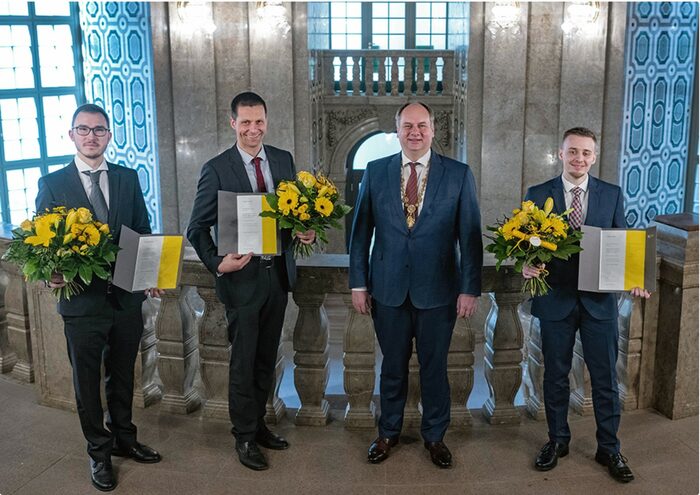
In March, the state capital Dresden and the network "Dresden – City of Science" honored excellent research and final theses with the DRESDEN EXCELLENCE AWARD. Lucas Grambole received the award for his research on energy supply issues and Andrey Ruzhanskiy for his findings on the stability of 5G networks. Dr. Shreenanda Ghosh, who conducts research on superconductors, is also among the award winners, as is Dr. Habil Hans Kleemann, who received the award for his research on organic semiconductor materials.
Central criteria of the jury's decisions for the four award winners are the relevance for research as well as the future orientation for the development of Dresden's urban society. "Current social issues are reflected in the work: from climate protection, sustainability and energy supply to digitalization and the consequences of pandemics. All the award-winning works have practical application references and high value for our lives - today and in the future," said Dr. Robert Franke, Head of the Office for Economic Development, commenting on the jury's choice.
March 16, 2022 | "Quantum Cat" aims to bring research into schools: Dresden center of excellence develops digital learning games for quantum physics
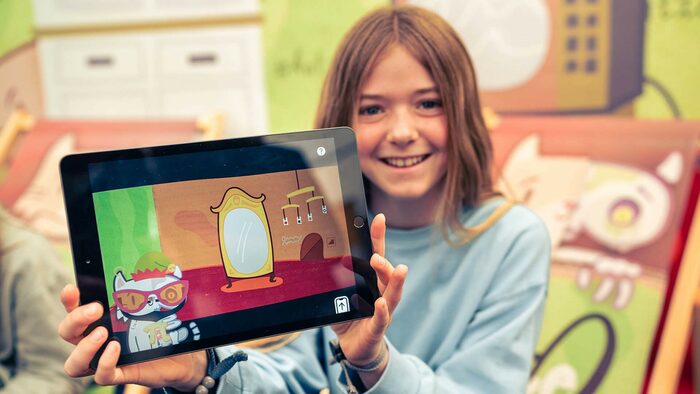
Quantum physics is highly complex and difficult to communicate - this is the common image, but researchers from Ct.qmat in Dresden want to counteract this. The goal: The physicists of the Cluster of Excellence plan to prepare current research content from quantum physics for a younger target group by means of digital learning games. Among other things, they have developed a learning app ("Cat Q") in which children are guided through age-appropriate learning content by a "dead-living" cat - known from Erwin Schrödinger's famous thought experiment. The award-winning app for children aged eleven and up has already been downloaded more than 80,000 times and could also be used in sixth-grade school classes in the future, according to Carsten Albert, who is in charge of educational games in the Ct.qmat network. Currently, quantum physics phenomena are only taught in high school and above. Ct.qmat (Complexity and Topology in Quantum Matter) is a cluster of excellence founded in 2019 by the University of Dresden and the University of Würzburg. It is known worldwide for its leading research in quantum materials and hosts about 270 researchers from 34 countries.
March 11, 2022 | ILK installs interactive outdoor thermometer at the institute building
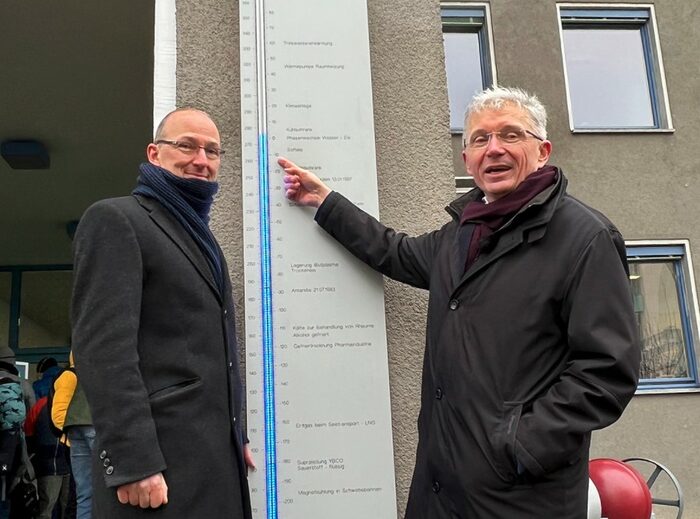
Under the curious eyes of students at Dresden's Kreuzgymnasium, the Institute of Air and Refrigeration Technology installed a new outdoor thermometer at the beginning of March. The 2.5-meter-high thermometer on the exterior facade of the ILK Dresden covers a temperature spectrum from -273°C to +100°C, which is marked with a series of tags and QR code. Passersby can use the QR code to call up information on the thermometer's various temperature readings, for example freeze-drying, dry ice, liquid oxygen or the coldest day in Dresden. The campaign is intended to increase the institute's visibility - especially among schoolchildren. "It is particularly important for us to reach out to school principals and teachers so that, together with them, we inspire Dresden's students to become interested in natural sciences," said ILK Director Prof. Uwe Franzke. With its excellent research in the field of air and refrigeration technology, the ILK is an absolute flagship for the science location Dresden and the nationwide research landscape.
March 2, 2022 | Dresden spin-offs on growth course: Senodis receives 1.5 million in venture capital, Infrasolid with new investor

The Dresden-based high-tech company Senodis receives a financial injection of 1.5 million euros. The investors are High-Tech Gründerfonds, Technologiegründerfonds Sachsen and Fraunhofer Technologie Transfer Fonds. Senodis intends to use the venture capital to further develop and market its innovative Ceracode process. The system is based on a special ceramic ink that can be used to print heat-resistant codes on metal components so that they can be digitally tracked during the production process. As a spin-off of Fraunhofer IKTS from Dresden, Senodis was supported with financial resources from the Dresden Economic Development Corporation as part of the 2019 Innovationsförderung program. Investments that are now paying off. This also applies to the Dresden TU spin-off Infrasolid, which was also part of Innovationsförderung 2019. The company, which specializes in the development of technical infrared solutions, changed its owner at the end of February. Instead of Technologiegründerfonds Sachsen, Infrasolid now belongs to Innovative Sensor Technology AG from Switzerland and intends to grow further with its new partner. This is evidence of the successful work of the business and innovation promotion in Dresden, which serves as an incubator for many start-ups.
Read more
February 25, 2022 | 150 million for the fight against cancer: Dewpoint wants to advance research in Dresden
The Dresden-based biotech company Dewpoint Therapeutics recently attracted a lot of attention with a cash injection of 150 million euros. Now, CEO Ameet Nathwani reveals what the money from the Series C financing will be used for. The Boston-based company is planning to research a total of 20 new diseases for which individualized drugs will be developed in the future. To this end, the Dresden site is to be expanded to 2,000 square meters of space and the number of employees is to be increased from around 220 at present to more than 300. Rapid growth for the company, which was founded in 2018 and has made a name for itself with the development of an AI-based analysis method and individualized drugs. It has also been able to benefit from the work of some of the research institutions in the Dresden biotech cluster, such as the Max Planck Institute for Molecular Cell Biology and Genetics in Dresden. The institute, founded by director Anthony Hyman, was involved in the discovery of so-called biomolecular condensates, among other things, which Dewpoint is investigating for the development of individualized drugs. A low-cost and highly effective approach in the fight against cancer, HIV, and a range of nerve, viral and heart diseases. In this effort, Dewpoint is receiving support from major pharmaceutical companies, including Bayer and Pfizer.
February 16, 2022 | Dresden researcher develop ultra-bright light for semiconductor industry and microbiology
A million times brighter than the sun - that's how powerful the white-light laser, which has been developed by Dresden researchers at the Fraunhofer Institute, is. In the future, the ultra-bright laser will be used for quality control in the semiconductor industry and in microbiology. The intensity of the light source can be used, for example, to characterize the surface profile, deeper structures and even the back of microchips in a single process. Microbiology could also benefit from the laser, for example in the study of cell cultures. The light used shines about a million times brighter than the sun and yet can be easily integrated into industrial manufacturing processes. The technology was developed as part of a doctoral thesis by scientist Dr. Tobias Baselt at the Fraunhofer Application Center for Optical Metrology and Surface Technologies (AZOM) and the West Saxony University of Applied Sciences Zwickau (WHZ).
February 14, 2022 | Dresden "CUBE" celebrates topping-out ceremony: The shell of the world's first carbon house is complete
Innovative, sustainable and almost finished - with the topping-out ceremony of the CUBE, the day of the completion of the world's first carbon house from Dresden is taking a big step closer. Work on the building, which is made entirely of the completely new and sustainable building material, has already been underway for several years. Following the topping-out ceremony on February 3, work is now continuing on the installation of the window fronts, the interior fittings and the building services equipment. The building is scheduled to be officially opened in September 2022. The building is an important demonstration of the market maturity of the new material, which, in addition to conserving resources, could also lead to significant CO2 savings in the construction industry. Building owner Prof. Manfred Curbach, professor of solid construction at TU Dresden and chairman of the board of the C³ association, thanked the construction workers involved for their tireless commitment and willingness to work with the unfamiliar building material. The C³ consortium, funded by the German Federal Ministry of Education and Research, is researching and developing a completely new type of construction using carbon concrete as a composite material. The CUBE is a milestone for broad application in practice.
February 4, 2022 | Smart Systems Hub expands IoT lab with edge cloud, 5G network and co-bots
In view of the growing interest of the business community in the Internet of Things (IoT), the Dresden-based excellence initiative Smart Systems Hub is expanding its "IoT Lab" in Dresden's Neustadt district. As a result, companies and institutes in the 50-square-meter lab can now use a new edge cloud infrastructure to remotely control robots via a 5G campus network. The collaborative robot was installed by the tech company "Universal Robots" and can be trained for a wide range of human-machine tasks via an app from the Dresden-based robotics specialist "Wandelbots". One promising field of application for the technology is in industry and the skilled trades, where co-bots could help address the growing shortage of skilled workers in the future. In total, the Smart Systems Hub and its partners from industry plan to invest around half a million euros in the new laboratory by 2023. It is designed as a nucleus and testing environment for the flourishing IoT community in Saxony.
January 25, 2022 | Greentech company Heliatek from Dresden nominated for the German Innovation Award for Climate and Environment
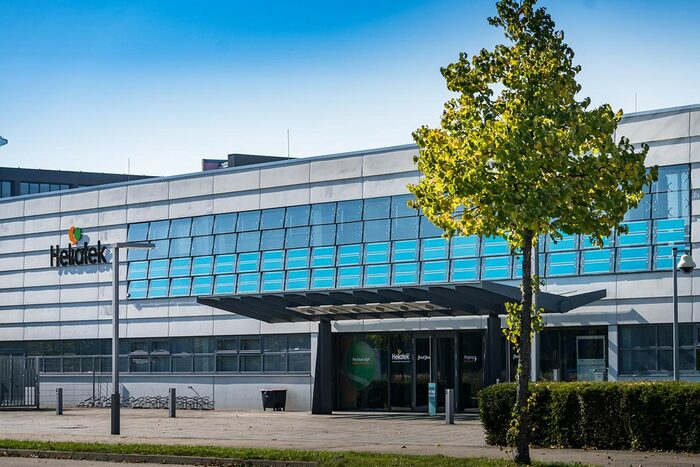
The German Innovation Award for Climate and Environment (IKU) recognizes the commitment of industry and research to the development of environmentally and climate-friendly technologies. The prize, which is endowed with 175,000 euros, is awarded by the German Federal Ministry of Economics and Climate Protection (BMWK). Around 150 companies submitted their forward-looking developments for this year's award, including Dresden-based greentech company Heliatek, which made it into the list of 21 nominees with its climate-friendly solar films. Heliatek's particularly thin, lightweight and flexible solar films are manufactured on the basis of organic photovoltaics and feature a very low CO2 footprint (10 gCO2e/kWh). The company is part of a Dresden-based greentech cluster of around 360 players, including about 70 research institutions and more than 270 start-ups, spin-offs, medium-sized companies and internationally operating corporations. With the development of numerous leading climate technologies, the cluster is making a decisive contribution to combating climate change and securing green growth with sustainable jobs for the region.
January 24, 2022 | Federal Ministry brings Science Year 2022 to Dresden: TU takes pop-up knowledge sites to the city
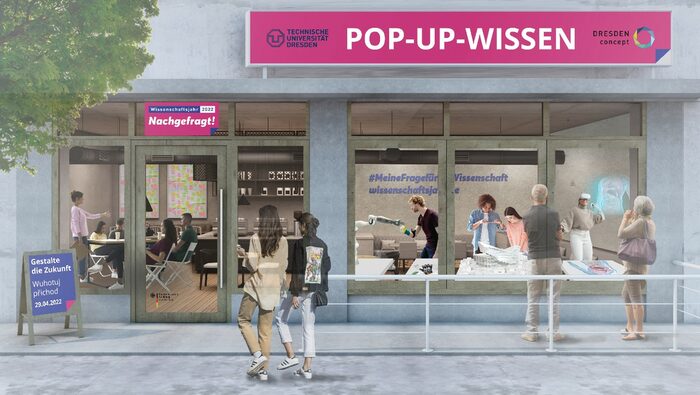
Collecting questions for tomorrow's research - that is the approach of this year's " Wissenschaftsjahr 2022 - Nachgefragt!", an initiative of Wissenschaft im Dialog and the Federal Ministry of Education and Research, in which the TU Dresden also participates. Thus, together with partners from Dresden and Weißwasser, the TU has launched the project "POP-UP-WISSEN - Wissen schafft Dialog" (POP-UP Knowledge - Knowledge Creates Dialog), which transforms vacant storefronts into "pop-up knowledge sites" to more strongly promote dialog between citizens and science. In the first quarter of the project, the focus is on collecting questions for science and presenting current TU Dresden projects. From the second quarter until the end of the year, the questions will then be answered in analog and digital formats. Questions can be submitted directly to the project or via the umbrella campaign throughout the year.
January 13, 2022 | TU Dresden builds world's leading driving simulator for autonomous driving
The development of autonomous cars is one of the greatest challenges facing engineers The development of autonomous cars represents one of the greatest challenges of the present time for engineers. However, the same applies for drivers, who often still have to get used to operating this new technology. For this reason, the TU Dresden has built a driving simulator that is specially designed for the special features of autonomous vehicles and with which handover scenarios in driving between technology and humans can be explored particularly well. In addition, the simulator is also capable of making medical assessments of the driver's fitness to drive or of researching the perception of movements, driving comfort and drivability. This involves the use of a new simulation technology that enables a realistic perception of vehicle behavior, including the sensation of acceleration and changes in direction. A "highly immersive" technology in which the conscious mind believes the virtual world to be real. The development of the simulator, which costs around 12 million euros, has received seven million euros in funding from the German Federal Ministry of Transport. The spherical facility is considered the world's most advanced simulator of its kind and is scheduled to officially go into operation in Dresden in 2023.
January 10, 2022 | Collaborative robots, the world's first carbon house and growth in future technologies - the business location of Dresden enters the new year stronger than ever
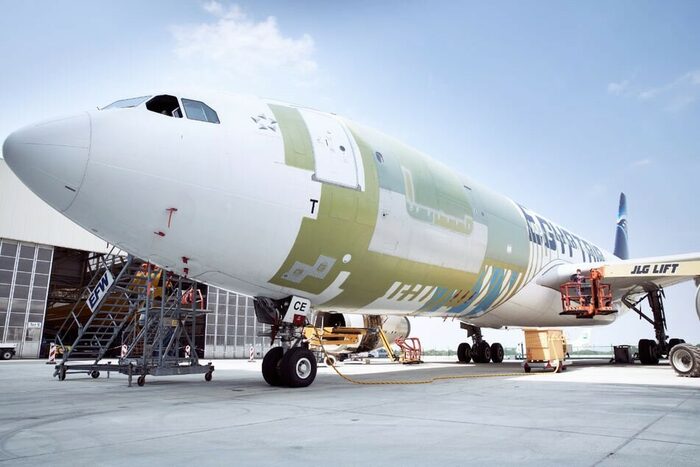
Dresden as a business location is looking forward to the coming year, which holds a number of exciting projects in store for the region. With the opening of the "CUBE", for example, a major milestone is already on the horizon in spring. The CUBE is the world's first house made of carbon concrete, a recyclable and sustainable building material that was developed in Dresden and is now being brought to market maturity. This is a success for Dresden's greentech site, whose 360 members plan to continue growing in 2022. The same goes for Dresden's robotics scene, which has declared a battle against the shortage of qualified employees with smart co-workers and collaborative robots. With the second Robotics Festival and other projects, the growing Dresden cluster wants to further boost the technology's breakthrough in 2022. It could also be helped by the networking of theory and practice at the site, which is to be further strengthened in 2022 by government grants worth millions. The project involves TU Freiberg, HTW Dresden and TU Dresden, which want to use the funding to expand the technology transfer between science and industry so that new research results find their way into practice even faster in the future. Elbe Flugzeugwerke (EFW), which maintains a site in Dresden for the conversion of aircraft using state-of-the-art lightweight components, is a good example of where this can lead. EFW is now looking for 300 new employees for this future-oriented industry, who will continue to drive the company's growth.
December 14, 2021 | Vattenfall and Cloud&Heat launch pilot project to provide sustainable computing capacity.
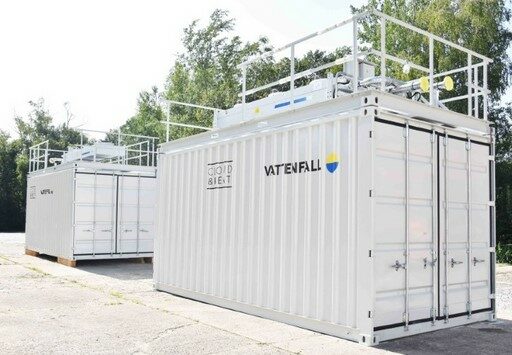
Data centers are consuming more and more electricity and resources - a problem that the Dresden-based startup Cloud&Heat wants to solve by using sustainable technologies and building the most energy-efficient digital infrastructure possible. To this end, the IT specialist has now partnered with the energy company Vattenfall. In a pilot project, the two partners want to work on the development of fossil-free high-end servers that can fulfill extremely high computing requirements thanks to artificial intelligence and high-performance computing. And they will do so while consuming as few resources as possible, for which purpose the servers will be connected to a biomass heating system for cooling. In this way, the excessive waste heat from the data center, which is located in two containers near Stockholm, is dissipated and fed into the nearby district heating system. With the increasing importance and demand for Green IT, Cloud&Heat and Vattenfall intend to improve this project further and offer more solutions to promote more sustainable data infrastructures.
December 8, 2021 | Dresden scientists increase the efficiency of sustainable perovskite solar cells
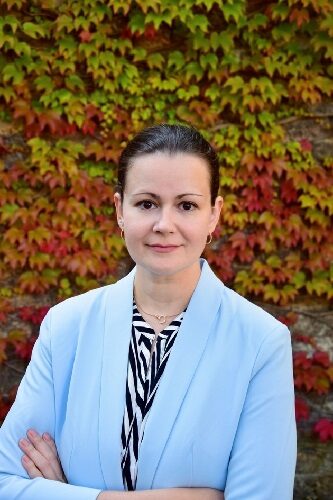
Electricity from solar energy is an important component of the energy transition, therefore researchers are constantly working on improving the efficiency of solar cells. Prof. Dr. Yana Vaynzof, head of the Chair of Novel Electronic Technologies at TU Dresden, in collaboration with colleagues from the Italian University of Pavia, has succeeded in doing so with so-called perovskite solar cells using an "inverted architecture". The Dresden researcher was able to increase the efficiency of the small power plants from 23 to 23.7 percent by adding organic salts. But that's not enough: The altered composition of the cells has also increased their stability. In view of these improvements, Prof. Vaynzof says the company is a big step closer to the market launch of this promising technology. Perovskite cells with an inverted architecture are considered a sustainable alternative to conventional silicon cells, because their production consumes significantly less energy. Until now, however, this has been at the expense of the efficiency of the particularly lightweight solar power plants, which has now changed with the modified composition. We already reported on Prof. Vaynzof's research successes in mid-April, when she caused a stir with a new manufacturing process for perovskite cells that enabled better reproducibility.
December 2, 2021 | 22 million for digital twin: TU Dresden receives order to research the future of the road
The future of the road is digital - that seems obvious. In order to research digital transportation, a special department was set up at the TU Dresden to study so-called digital twins. Digital twins are computer models that virtually map physical processes by using real-time sensory monitoring in order to optimize them regarding specific goals. In connection with the further development of autonomous driving, they are expected to play an important role in the future. The contract from the German Research Foundation (DFG) has therefore been awarded a funding budget of more than 22 million.
Professor Michael Kaliske from the "Institute for Statics and Dynamics of Structures" at TU Dresden will lead the new field called "Digital Twin Road - Physical-Informational Mapping of the Road System of the Future". Other institutes are joining the project as partners, for example from RWTH Aachen University. In addition to the new research area, the project also includes two graduate colleges, which are now being established at TU Dresden. In acquiring the project, the Dresden research location was able to compete against a large number of other applicants.
November 26, 2021: German astronaut conducts experiments on the ISS for TU Dresden
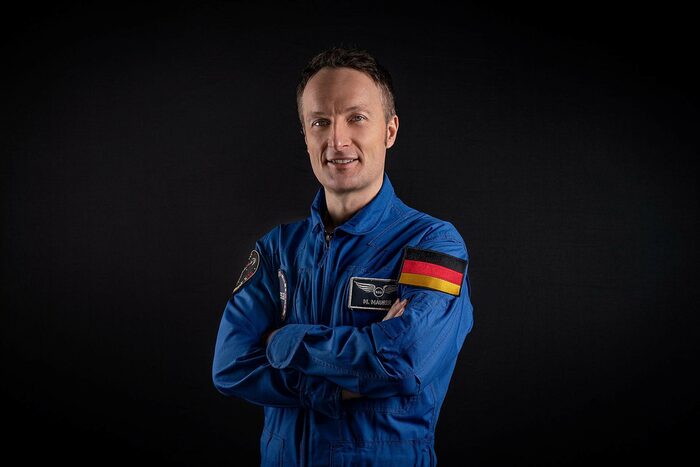
Flying into space as an astronaut - a dream that finally came true for Matthias Maurer after long preparations. On November 12, the German ESA astronaut traveled in a SpaceX rocket for the first time toward orbit to conduct a series of scientific experiments on the International Space Station (ISS). Also on board were two research missions accompanied by the TU Dresden. The first is a 3D printer known as "Bioprint First Aid," which can produce a tissue-forming "bio-ink" that can be used to accelerate the healing of abrasions. The second experiment is designed to develop a smart breathing gas analysis system. Unlike previous systems, this should allow significantly more mobility and enable the wearer's physical performance to be determined more accurately. Matthias Maurer is expected to spend the next six months on the ISS.
Read more
-
German Aerospace Center
"Matthias Maurer's Cosmic Kiss mission"
- About TU Dresden
November 18, 2021: Dresden researchers develop novel cancer therapy
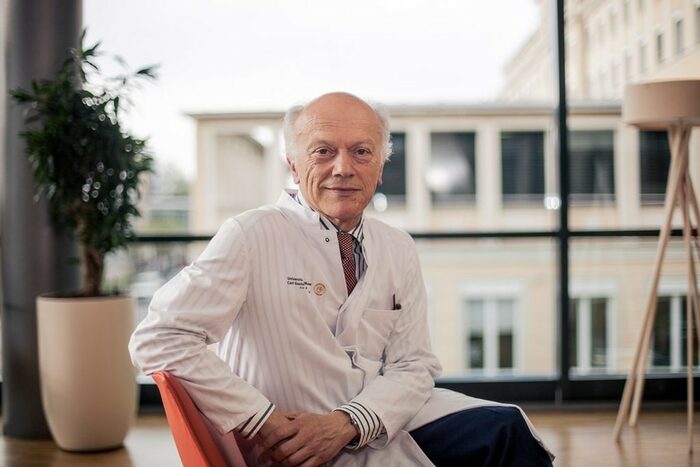
Digital technologies are revolutionizing medicine and promise new opportunities for cancer therapy. The Dresden-based company GEMoaB's research supports so-called CAR-T therapies, in which blood cancer patients are treated with genetically modified immune cells. These killer cells fight cancer, but they often cause an excessive immune reaction of the body, which can be life-threatening. GEMoaB technology is designed to prevent this immune reaction by turning the killer cells on and off. The founder of GEMoaB is stem cell expert and physician Prof. Gerhard Ehninger, who already co-developed the CAR-T approach. Ehninger was the director of Medical Clinic I at the Carl Gustav Carus University Hospital and a physician at the TU Dresden Hospital. He is co-founder of the German Bone Marrow Donor Center (DKMS) and founder of the company Cellex, based in Dresden and Cologne. Blackstone Life Sciences currently invested a quarter of a billion US dollars in GEMoaB. In the future, the company will be the european head office of the newly founded international company Avencell Therapeutics. Dresden will become the site of Avencell Europe.
November 15, 2021 | NTT DATA Business Solutions strengthens Sachsen’s IT network
The digitization of companies is advancing. Cloud Computing is becoming more and more important in this regard. NTT DATA Business Solutions AG (formerly itelligence AG), based in Dresden, Germany, also continues to expand driven by the increasing need for cloud management: In the current second half of the year, the world's leading SAP service provider for SMEs and corporate customers has reported a positive trend in business. The growing demand for SAP support and cloud management is also strengthening the company's location in Saxony, where the company has invested over 40 million euros to date. In the future, NTT DATA Business Solutions intends to expand innovation partnerships in topics such as Smart City, 6G Connectivity and Industrial Internet of Things. Plans include a more intense cooperation with the Smart Systems Hub, the Silicon Saxony cluster and the region's universities. In doing so, the company is promoting the boom in the IT and software industry in Dresden as a center of innovation.
Read more
-
NTT Data
"Transformation is not about technology. It’s about making it work for you."
November 4, 2021 | Amt für Wirtschaftsförderung and KarriereStart bring nationwide start-up week to Dresden
Dresden offers high-tech founders the best conditions for a successful start to the market. Among many regional supporters there are the Amt für Wirtschaftsförderung (Office of Economic Development) and the KarriereStart education, job and startup fair: On the occasion of Startup Week Germany, the two institutions invite you to the startup seminar "On your mark, get set, ... Stop - Develop concepts with new ideas and confidence". Decision-makers from companies in a wide range of industries as well as investors will report on topics such as innovative startup models or new strategies during the corona crisis. The event will take place from 4 to 8:30 p.m. in the New City Hall, registration is required and possible until November 11.
The motto of this year's StartUp Week Germany from November 15 to 21 is "Founding means diversity." Its aim is to get young people excited about entrepreneurship, to enable the exchange of ideas, experiences and opinions about startups and self-employment, and to present initiatives to promote start-ups.
October 27, 2021 | Dresden-based hydrogen company secures multi-million investment
The market for climate-friendly green hydrogen is growing - also in Europe. Investor funds totaling 109 million euros are to enable the Dresden-based company Sunfire to industrialize its novel electrolysis technology in the future and set up its first giga-factories. The investors include lead investors Lightrock and Planet First Partners as well as Carbon Direct Capital Management and HydrogenOne Capital. With the development of its high-temperature electrolysis (SOEC), Sunfire is setting new standards for the production of green hydrogen: the startup's electrolysers are capable of producing a synthesis gas in just one step that can be converted into products such as kerosene or diesel. In this way, Sunfire's technology helps replacing fossil feedstocks such as petroleum or coal. By 2023, the company headquartered in Dresden also plans to build a production facility for alkaline electrolysers in Germany with a capacity of 500 megawatts per year. Further expansion is already being planned.
October 20, 2021 | TU Dresden researcher receives prize for innovative material combination for robot arms
More cost-effective robot drives through innovative material combination: For this achievement, Moniruddoza Ashir, a mechanical engineering expert from Bangladesh, has now been awarded the Innovation Prize by the Industrieclub Sachsen e.V. The textile and clothing engineer and mechanical engineer with a doctorate has been researching alternative materials for kinetic systems at the Institute for Textile Machinery at TU Dresden since 2013. While gripper and robot arms are traditionally mostly based on metal, Ashir's dissertation recommends shape memory alloys made of nickel and titanium that can return to their original shape despite deformation. These are already established, he said, but expensive. His presented new combination with fiber-plastic composites such as glass or carbon requires less alloys and is therefore more cost-efficient in production.
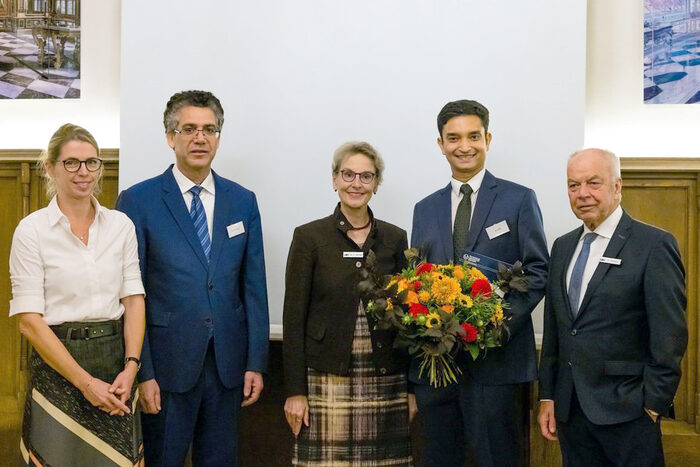
October 15, 2021 | Dresden-based startup helps plastics manufacturers with recycling
In the European Union, and thus also in Germany, numerous single-use plastic products have been banned since July 3, 2021. This is intended to reduce the amount of plastic waste in the environment. The Dresden-based startup Holy Poly supports manufacturers of plastic products in meeting the stricter requirements for more recycling in companies and in society and in achieving self-imposed waste reduction targets. Holy Poly's customers in this regard are primarily B2C brand manufacturers that bring higher-value plastic products to the market. The development goal, according to Holy Poly, is products that are 100 percent recycled and 100 percent recyclable - and a plastics industry that is committed to a circular economy. In this step, Holy Poly supports companies with various service packages - from consulting to design and engineering to implementation. Initial projects have already been realized with Mattel and Innocent.
Read more
October 8, 2021 | Dresden AI software simplifies leukemia diagnosis
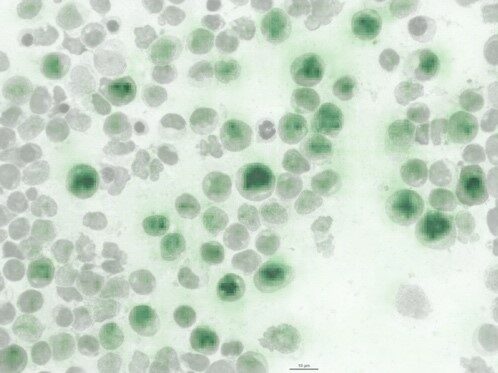
Digital technologies are revolutionizing medical technology and creating new opportunities, such as for the early detection of cancer. Researchers at the National Center for Tumor Diseases Dresden (NCT/UCC), the University Hospital Carl Gustav Carus Dresden and TU Dresden have developed a novel computer system based on artificial intelligence (AI). For the first time, an analysis software supports physicians with high precision in diagnosing acute myeloid leukemia (AML). AML is the most common form of rapidly progressing blood cancer in Germany and affects the bone marrow. In addition, the AI solution makes it easier to detect a gene mutation that is important for the treatment of the disease. The scientists developed the system using artificial neural networks that mimic human abilities. The technological approach can be applied to many other image-based examination methods and is currently being expanded.
Read more
-
Nature.com
"Deep learning detects acute myeloid leukemia and predicts NPM1 mutation status from bone marrow smears"
October 7, 2021 | Dresden is up-and-comer of the year in the Smart City Index
Dresden made the biggest leap in this year's Smart City Index of major German cities: from 24th place last year to sixth place in the current shortlist. The nationwide digital ranking is compiled annually by the ICT industry association, which collects and reviews around 11,000 data points in five thematic areas for this purpose. Dresden is one of Europe's leading high-tech locations and uses digital technologies for future-oriented urban development, among other things. Dresden's research and business players are global pacemakers for smart city solutions in many areas, such as the development of 6G. The IT and software industry is now the largest job generator in Dresden. The Dresden city administration is also taking a leading role in the smart city issue, for example in the implementation of the Online Access Act in Germany. For example, more than 80 different administrative services can already be applied for electronically using the online assistant. By the end of 2022, 200 services are to be available online.
Read more
September 24, 2021 | Flywheel at TU Dresden stores wind energy at record levels
Storage technologies, such as lithium-ion batteries, pumped storage plants or synthetic fuels, play an important role in the energy transition. Another technology that has received little attention so far are so-called flywheels, in which excess energy is stored in the form of rotational energy. The potential of this technology is demonstrated by a flywheel developed by the TU Dresden in Boxdorf in Lusatia, which can store half a megawatt hour of energy and deliver up to 500 kilowatts at peak times. The demonstrator is thus five times larger than the largest flywheel storage system to date. Set up near a wind farm, the technology could help capture electrical energy from power peaks in the future and store it for windier periods. According to the TU Dresden, the demonstrator could be operated economically without any problems.
Read more
September 24, 2021 | TU Dresden becomes part of the European University Eutopia
Eutopia is a network of partner universities that aims to build the European university of the future. For this purpose, Eutopia wants to prepare students, teachers and learners for the disruptions and challenges of the 21st century. At the same time, the Europeanization of the study program is to be further pushed, in which the Technical University of Dresden, which recently joined the network, is now also participating. Rector Ursula M. Staudinger hopes that this membership will enable her to shape joint European teaching projects at the TU Dresden. The admission ceremony took place on Thursday, September 23, at the residence of the Italian ambassador in Belgium. Together with the TU Dresden, the Università Ca'Foscari Venezia and the Universidade Nova de Lisboa joined the association. Thus, Eutopia consists of a total of nine universities.
Read more
September 16, 2021 | First "Dresden Robotics Festivals" brings together the leading minds of the robotics scene

The first Dresden Robotics Festival brings together the international robotics scene from industry, research and new business in the Saxon capital from September 16 to 22. Among the 350 participants and 60 international speakers of the event are leading robotics manufacturers such as Fanuc, Siemens, Stäubli and Yaskawa, as well as well-known scientists, executives and start-ups. The Dresden Robotics Festival was initiated by "Robot Valley Saxony", an industry association that works with Saxon startups, suppliers, service providers, research institutes and public institutions to promote Saxony as a leading robotics location. With the Dresden Robotics Festival, the innovation region of Dresden once again underlines its ability to play a decisive role in shaping the future of the growth industry of robotics.
Read more
September 9, 2021 | Project launch for 6G-Life research hub in Dresden
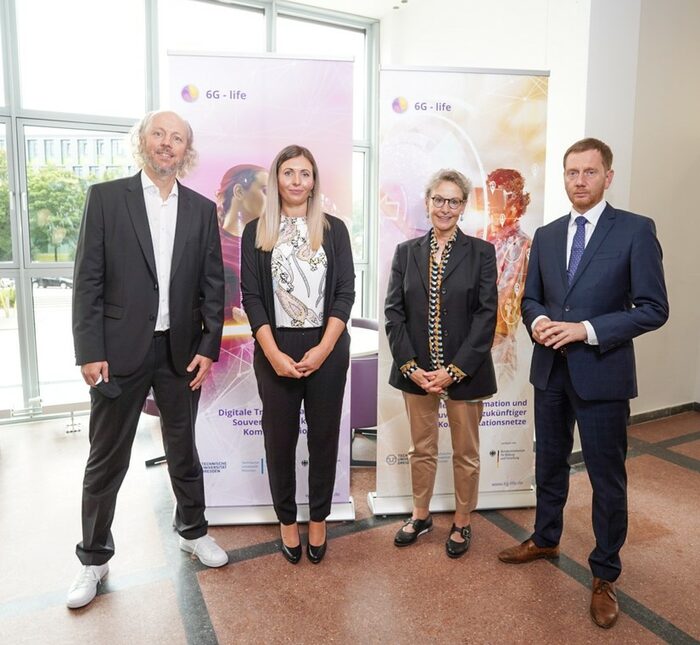
With " 6G-Life " a new research hub has been opened at the Technical University of Dresden, which is all about 6G - the mobile communications standard of the future. The project is funded by the German Federal Ministry of Education and Research (BMBF) and aims to advance the development of quantum communication and artificial intelligence in mobile communications. In this way, developments such as virtual reality or the tactile Internet (real-time remote control of physical objects) are set to be lifted into the broad mass market in the future with the introduction of the 6G network. Currently, such applications are mainly limited to local 5G campus networks. In comparison to the 5G standard, this requires significant improvements in latency, resilience and network security, which the 6G Life Hub is now researching. In addition, another focus is on promoting startups. With regard to 6G development, Dresden is considered one of the world's leading research centers. With its funding, the BMBF aims to establish Germany as a world-leading technology partner and to shape technological change.
Read more
September 2, 202 | Climate protection through digital technologies: Federal Ministry awards prizes to two Dresden research projects
August 25, 2021 | Artificial intelligence as an early indicator: Scientists at TU Dresden achieve breakthrough in implantable AI systems
Artificial intelligence (AI) is already used in many areas of medicine, for example in the evaluation of patient data in order to detect diseases at an early stage. But scientists at TU Dresden have now gone one step further: With a bio-compatible AI platform, for the first time they succeeded in implanting AI into the human body. The goal of the research team led by Prof. Karl Leo, Dr. Hans Kleemann and Matteo Cucchi of the Chair of Optoelectronics is to use the AI platform to detect healthy and pathological patterns in biological signals, to classify heartbeats in real time and thus to detect pathological changes at an early stage without permanent medical monitoring. The basis for the AI chip are polymer-based fibre networks that structurally resemble the human brain and enable the complex processing of data (“reservoir computing”). The scientists see this approach as an opportunity to develop further intelligent systems in the future that can help save human lives.
August 20, 2021 | Dresden researchers develop new hardware for the artificial brain
The human brain works highly dynamically and extremely efficiently. Neuroinspired computers try to mimic this - so far mainly through software solutions. But according to Dr. Alina Deac, project leader at the Helmholtz-Zentrum Dresden-Rossendorf (HZDR), the brain's mode of operation should also be able to be reproduced on the hardware level in the future. Together with her research team, she is investigating extremely small materials, so-called nanodisks, which, when manipulated with ion beams, show an activity pattern similar to that of communicating nerve cells in the brain. This opens up new possibilities for miniaturized hardware applications in the field of artificial intelligence, whose practicality can be excellently researched at the science location Dresden, says Dr. Alina Deac: "Dresden is a unique location for innovations around neuromorphic computing or Wi-Fi technologies. It is a huge advantage that we can already test our development here on site for its practical suitability. For example, we can also integrate the nanodisks into more complex electronics in the long term with our partners at the TU Dresden and with industry." The range of applications for nano-disks is enormous. Comparable technologies can already be found in commercial magnetic storage devices and for new wireless technologies.
August 12, 2021 | Dresden researchers develop solid-state batteries for electric aircraft
From basic research to industrial application – this is the goal of "SoLIS", a research project of the German Federal Ministry of Education and Research, which has been working on the marketability of solid-state batteries since 2021. Among others, the TU Dresden and the Fraunhofer Institute for Material and Beam Technology (IWS) from Dresden are involved in the project, where the latter is responsible for project coordination. Unlike conventional lithium-ion batteries, solid-state batteries consist of a lithium-sulfur mixture and have comparatively high storage capacities and low material costs. The project will test and optimize innovative manufacturing processes for the new technology. The research results could help to use the particularly lightweight and cost-effective batteries in electric aviation in the future. The project is funded by the German Federal Ministry of Education and Research with almost 1.8 million euros.
Read more
-
Fraunhofer IWS
"Solid-state battery to leap into industrial application"
- About Fraunhofer IWS
August 4, 2021 | Volkswagen and TraceTronic launch neocx: A joint venture for automated software integration
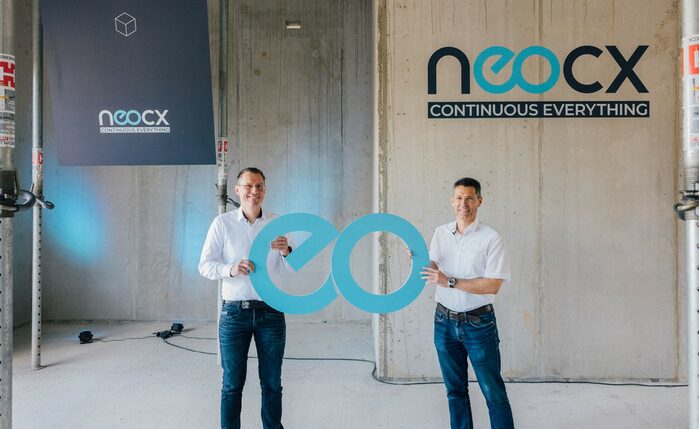
High-performance vehicle functions are based on the networked interaction of many individual software and hardware components. Bringing these components together and testing them as a whole is currently one of the most important development tasks in the automotive industry. The joint venture neocx, founded by Volkswagen and the Dresden-based IT specialist TraceTronic, aims to solve it. TraceTronic was founded in 2004 as a spin-off from the Technical University of Dresden and today, with around 300 employees, is one of the world's leading providers of solutions for testing and integrating vehicle software.
For Dr. Robert Franke, head of the Dresden Economic Development Agency, TraceTronic is a prime example of Dresden as a business and science location: "The new joint venture neocx with Volkswagen is a special milestone in TraceTronic's success story. In the future market of integration and testing of highly networked vehicle software, it will not be the last chapter of the Dresden-based company. The major topics in the automotive industry - CO2 reduction, electromobility and high-automated driving - are driving the complexity of electronics and software and thus also the need for automated testing. This is precisely where Tracetronic's globally sought-after expertise lies."
Volkswagen and TraceTronic each have a 50 percent stake in the joint venture neocx.
Read more
July 29, 2021 | NCT in Dresden discovers new therapy options against colorectal cancer
In Germany, more than 58,000 people are diagnosed with colorectal cancer every year. Still, there are few effective therapies against the disease, especially when it is already at an advanced stage. But a team of researchers led by the National Center for Tumor Diseases (NCT) in Dresden and Heidelberg could now change that. In their research, they have discovered a protein complex (cyclin K/CDK12) that can be used to target colorectal cancer tumor cells. The substance used to do this could be a previously unknown substance from the new group of active pharmaceutical ingredients known as molecular adhesives, which was also discovered by the team of researchers at the NCT.
"This is an important basis for developing new drugs for patients with colorectal cancer in the future or for testing existing CDK12 inhibitors for their efficacy against these tumors," says Prof. Hanno Glimm, director at the National Center for Tumor Diseases in Dresden. The NCT is a joint institution of the German Cancer Research Center (DKFZ), the Dresden University Hospital, the Medical Faculty of TU Dresden and the Helmholtz Center Dresden-Rossendorf (HZDR).
Read more
July 22, 2021 | The AI-music plays in Dresden
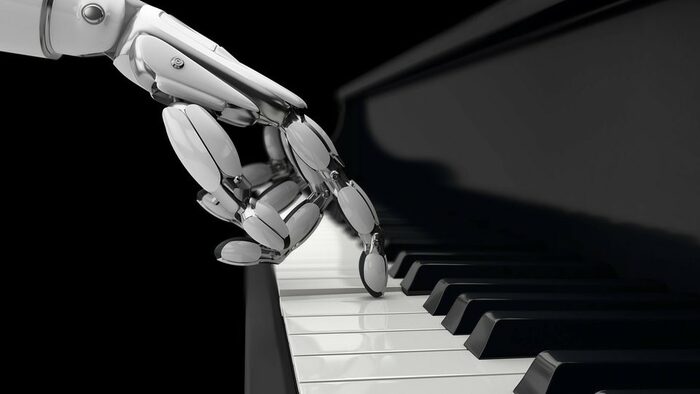
The human hand playing the piano: a complex interplay of tendons, sensory cells and a wide variety of muscles. A research team from the TU Dresden and the "Centre for Tactile Internet with Human-Machine Interaction" (CeTI) is investigating exactly how it works. With the help of artificial intelligence, the researchers want to digitise the ability to play the piano in order to transfer it into learning programmes subsequently. To do this, they asked the pianist Inhye Park to sit at a piano in a sensor suit and analysed her every movement using artificial intelligence. Each of her keystrokes is recorded in real time on the computer. The data collected in this way can now serve as the basis for learning programmes in which learners can also slip into an AI suit and use vibration feedback to train themselves the right movements. For example, they learn "that by cushioning the wrist, a softer or harder tone is created", explains Karl-Heinz Simon, piano methodologist at CeTI Dresden. In just a few years, such learning programmes could help teach people a wide variety of skills, regardless of language or other barriers.
Read more
July 2, 2021 | TU Dresden develops laser robot for disposal of radioactive toxic waste
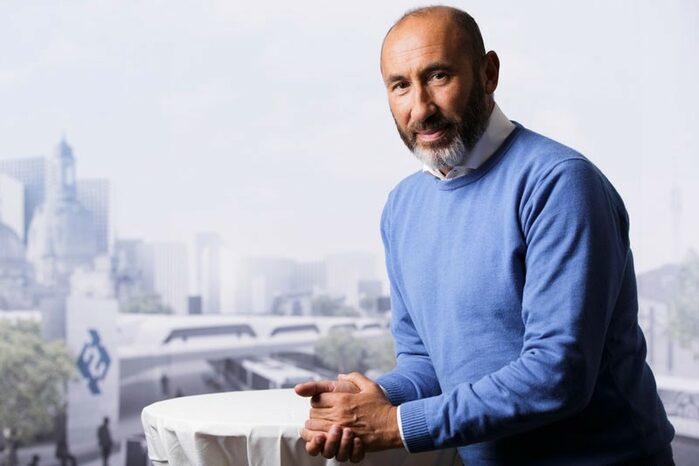
The demolition of old nuclear power plants produces large quantities of radioactive waste. The removal of this waste can be extremely dangerous for humans. Researchers at Technische Universität Dresden now want to make a change. For this purpose the team of the Chair of Hydrogen and Nuclear Energy Technology has developed a new laser robot that is intended to render contaminated materials harmless before they are demolished and make them accessible for future reuse.
Their focus lies on a paint made of plasticizers that was common in the 1970s, which is usually found on the walls and metal parts of old power plants and is considered to be carcinogenic. Currently, the radioactive paints are still removed with sandblasters, which leads to contamination of the sand used. To get around this, the Dresden robot was equipped with special lasers that can heat the paints in such a specific way, that the radioactive materials decay and can then be extracted. According to the TU Dresden, there is already international interest in this technology as the number of ramshackle nuclear power plants continues to rise.
June 25, 2021 | Lightweight Symposium 2021 of TU Dresden: With neutral lightweight construction to more resource savings
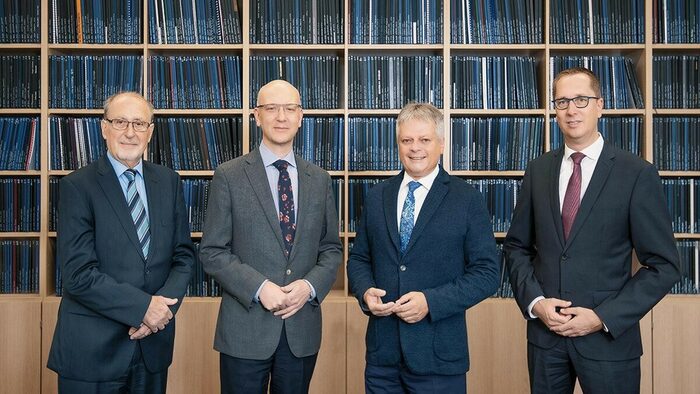
"Neutral lightweight construction - added value through resource savings" was the motto of the Dresden Lightweight Symposium 2021, which was all about sustainable and future-proof business practices. Together with selected experts, the guiding principles of resource-saving lightweight construction in the 21st century were discussed at the event organized by the Institute for Lightweight Construction and Plastics Technology at Dresden University of Technology. Whether "Cradle-to-Cradle" or innovative solution approaches for the recycling of material flows - the platform covered a wide range of topics with its about 100 digital events. In addition to the presentations, the more than 1.000 participants from industry, politics and science were also able to take advantage of several opportunities for interactive networking. The Dresden Lightweight Symposium is regarded for many years as an important cross-industry platform for the exchange of experience between international decision-makers. This year's symposium once again hit the nerve of the time with the topic of neutral lightweight construction.
Read more
June 18, 2021 | Digital Product Factory: Smart System Hub from Dresden enters third round with new challenge

Eyes from Infineon, muscles from Wandelbots, a nervous system from SAP and objective partner: this is what the third round of the Digital Product Factory, DPF for short, looks like. The DPF is an innovation program of the Smart Systems Hub from Dresden that aims to develop digital industrial applications. Its projects are limited to a term of three months and bring together cooperation partners from various disciplines. In the third, current edition of the Digital Product Factory, technology company Infineon is now working with software specialists SAP, objective partner and Wandelbots to improve human-robot interaction using artificial intelligence (AI). To this end, the co-innovators have set themselves two goals: The development of a flexibly deployable robot that can be taught and monitored with a sensor fusion-based edge AI solution, and the ability to digitally make the robot AI billable.
Both together form a holistic and scalable business model, which is also referred to as "robot and asset as a service". The Smart Systems Hub Dresden provides the virtual and physical spaces for this, methodically leads the product development and takes over the organization and acquisition of know-how.
Read more
June 14, 2021 | Jenoptik, Vodafone, Bosch - Dresden's high-tech location on course for growth
Vodafone, Jenoptik and Bosch are bringing growth to the hightech region of Dresden. While the mobile communications specialist Vodafone wants to establish a global competence center for research and development in the state capital, Jenoptik and Bosch are setting up new production facilities in "Silicon Saxony". At the new Vodafone innovations center, up to 200 researchers will work on the further development of 5G and 6G technology and drive concrete applications in the fields of autonomous driving, connected agriculture, chemistry and construction. Photonics group Jenoptik is acquiring land to invest in a new cleanroom factory with a state-of-the-art manufacturing building and office complex. Industrial giant Bosch, on the other hand, has just opened a new semiconductor factory in the north of Dresden. The site is considered one of the most modern of its kind and one of the largest investments made by the traditional company. The Office for Economic Development was directly involved in all three additions to Dresden’s business community. Dresden's Lord Mayor Dirk Hilbert emphasizes the advantages of Dresden for businesses: "The interaction of numerous companies, institutes and startups makes Dresden one of the leading high-tech locations in Europe. The future is at home in Dresden". Dresden's excellent universities educate globally sought-after talents, especially in the STEM subjects, who are now offered further very attractive opportunities locally.
Read more
June 3, 2021 | Vodafone chooses Dresden as location for new global innovations centre
The Vodafone Group will establish a global competence centre for research, development and innovation in Dresden. With this new facility, the company will create more than 200 highly qualified jobs in the state capital in the coming years. In January 2021, the Vodafone Group launched an international competition in which eight pre-selected European cities were able to apply as locations for the new centre. Dresden prevailed in this competition. The competence centre will have a clear focus on future technologies such as 5G, 6G and OpenRAN - as well as on concrete applications in the areas of autonomous driving, connected agriculture, chemistry and construction. Dresden is already a world-leading research location in all these areas.
Hannes Ametsreiter, CEO Vodafone Germany: "The decision is another strong commitment to industry in the heart of Europe. [...] from 2021, we now want to develop 6G in Dresden from Germany for the world. Our message to this country: the future of digitalisation is forged in Germany." German Federal Minister of Economics Peter Altmaier: "The attractiveness of Dresden and Saxony as a region of innovation is once again visible here." Dirk Hilbert, Lord Mayor of Dresden: "The interaction of numerous companies, institutes and start-ups makes Dresden one of the leading high-tech locations in Europe. Vodafone's decision once again underlines this: Dresden is tomorrow’s home."
Robert Franke, Head of the Office for Economic Development, adds: "We are proud that we were able to convince Vodafone with our application. An important argument for choosing Dresden as a location for a technology business are always our excellent universities, which train talents who are in demand worldwide, especially in the STEM subjects."
Read more
May 28, 2021 | Dresden researchers make technical surfaces as pure as a lotus
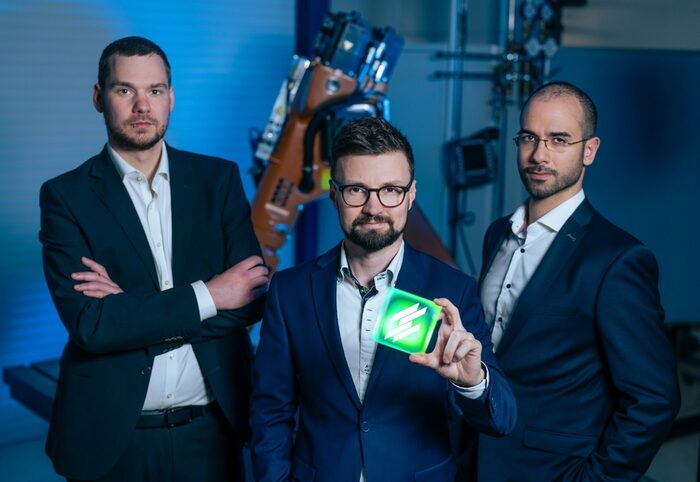
May 20, 2021 | Science Communication Award: Doctoral student from Dresden competes for Germany
When you play the video, a connection to an external website is established, your user information is transmitted and possibly processed there. Further information can be found in the privacy policy. (Privacy policy).
Dresden scientist Stefan Golfier prevailed among competitors from all over Germany and emerged as the winner in the final of FameLab Germany 2021. FameLab is an internationally renowned science communication competition in which young scientists have to present their work to a jury in a three-minute presentation. The participant with the most comprehensible and exciting content wins and can qualify for the international final at the Cheltenham Science Festival in Great Britain via a series of regional competitions.
This year, Stefan Golfier, a scientist from Dresden who recently completed his doctorate at the Max Planck Institute for Molecular Cell Biology and Genetics and the Max Planck Institute for the Physics of Complex Systems, succeeded in doing so for Germany. With his presentation "Our Untangled Genome" he is now competing against the best communicators of the international science scene: "Qualifying for the final is a great experience and a great opportunity to share my fascination for science with a broad audience. For the opportunity to take part, I would like to thank the Dresden Max Planck Institutes and the Dresden science community, through whom my enthusiasm for science communication was awakened." FameLab has taken place annually since 2005 and is one of the leading events of its kind.
Read more
-
Statement by Max Planck Society
"Stefan Golfier wins the FameLab Germany 2021"
- About FameLab
May 12, 2021 | TU Dresden climbs further in the ranking of the best universities
The RUR World University Ranking 2021 analyzed a total of 867 universities for its ranking of the world's best universities. Among them is the TU Dresden, which this year has landed in 67th place. After finishing 229th in 2013, it has thus moved up 162 places in eight years. It also climbs in the ranking of German universities: From 17th place in 2013 to 3rd place in 2021. The TUD gets particularly good marks in the area of teaching, where it is ranked second in Germany for the second time in a row. In the area of research, the TUD also shows consistently good rankings in a global comparison. Here, the University has once again made it into the top 50 in 2021, as well as 6th place in Germany.
As a result, the RUR World University Ranking now classifies the TU Dresden in the so-called Diamond League. The results confirm the long-lasting upward trend of the TU Dresden in international rankings. This can also be seen in the QS World University Ranking 2021, in which the TU Dresden improved and took a place among the top 200.
Read more
-
TU Dresden
"RUR World University Ranking 2021: TU Dresden climbs the ranks"
- RUR World University Ranking
- About TU Dresden
May 7, 2021 | Senodis moves into new company headquarters - supported by the Dresden Economic Development Agency
Digital component tracking plays an important role in smart industrial applications, yet in some cases it poses a major technical challenge. An example are metallic components that are exposed to extreme temperatures during processing. This is why the Dresden-based startup Senodis has developed a marking process that labels metal parts with a resistant ink made of ceramic pigments that allows them to be recognized and digitally tracked even at temperatures of over 900 degrees. In order to bring this process to market maturity, the Dresden Economic Development Corporation supported the start-up in the past with financial resources amounting to 80,000 euros and the arrangement of office space for new company headquarters in Dresden’s TechnologieZentrum Nord.
Senoris recently opened its new business premises in a business park brimming with innovation: "We would like to thank the city of Dresden for its support and confidence during the early founding phase of Senodis. For us, this confirms on a daily basis that Dresden, with its technology environment and growing startup scene, is an excellent location to put our ideas into practice," said Dr. Christoph Kroh, co-founder and technical managing director of Senodis. Dr. Robert Franke, Office Director of the city’s Office for Economic Development, is happy to welcome the company, which was founded in 2019 as a spin-off of Fraunhofer IKTS, at its new location: "Senodis convinced us with a really innovative technology that we definitely wanted to keep here in Dresden. The City’s Innovation Support Programme has once again proven to be a successful catalyst for turning excellent ideas into promising business models," says Dr. Robert Franke.
Read more
April 30, 2021 | Dresden-based car software manufacturer Tracetronic on course for growth
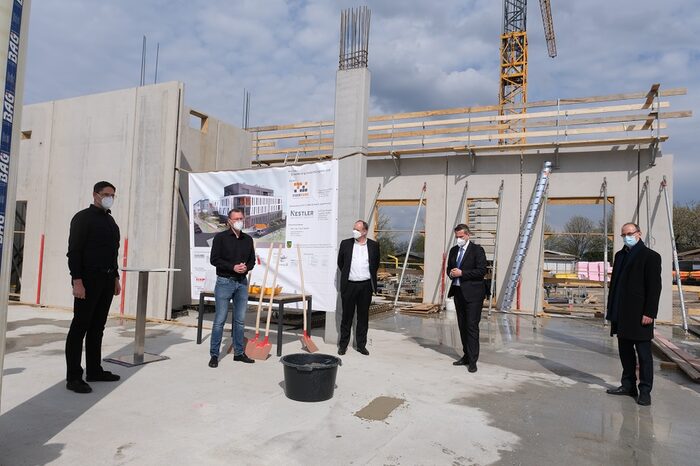
Whether driver assistance systems, autonomous driving or infotainment: the complexity of automotive software is increasing exponentially. Up to 100 control units are now installed in the vehicle. The Dresden-based company Tracetronic has developed software solutions so that electronic control units can be tested fully automatically in a wide variety of environments - from testing individual software components to the final test in vehicles. As a result, errors can be detected earlier and time-to-market can be shortened considerably. To cope with the growing demand, the company is constructing a new building complex for up to 350 employees at its headquarters in Dresden. The foundation stone was laid yesterday.
Founded in 2004 from the Technical University of Dresden, Tracetronic has since developed into a global company with further locations in Germany, the USA and Korea. Tracetronic supports more than 150 companies in the international automotive and supplier industry with software products and innovative solutions for the development and safeguarding of complex embedded systems in vehicles. These include Audi, the BMW Group, Bosch, CLAAS, Continental, Daimler, Denso, Ford, Geeley, IAV, John Deere, Magna, Porsche, Rivian, Siemens and Volkswagen. "TraceTronic is a prime example of Dresden as a location for business and science. Spun off from TU Dresden in 2004 and staying here for good reasons, it now radiates from the Coschütz-Gittesee industrial estate to all corners of the automotive world, from Korea to Silicon Valley," said Dr. Robert Franke, head of the Office for Economic Development of the City of Dresden at the laying of the foundation stone.
Read more
23th April 2021 | Artificial muscle for the robot of the future - PowerON wants to accelerate development in Dresden
The up-and-coming start-up PowerON has set itself the goal of revolutionising robotics. This involves developing products based on so-called "artificial muscles" that enable the transformation of robots from stiff, inflexible and lumbering assembly line workers to silent, compliant, flexible and agile everyday assistants. "Whether in the home, shopping or healthcare, numerous new applications will open up that we cannot even imagine at the moment" says Dr Markus Henke, CEO of PowerON.
The founding team has already been researching together on the technology used for this purpose since 2015. With the foundation of PowerON Limited in New Zealand in 2019 and PowerON GmbH in Dresden in the summer of 2020, another milestone has been reached. "Dresden is the ideal location for us. Every year, numerous first-class graduates leave the local universities, which means we can draw on an excellent network in the field of research and development. For example, we work very closely with the TU Dresden as part of a junior research project. In addition, the city of Dresden is one of the leading locations in the field of robotics," says Dr Henke.
Currently, the international team is working primarily on the development of compliant sensors that, among other things, make it possible to equip robot grippers with a sense of touch. However, there are hardly any limits to the possible fields of application for the technology. Based on the same materials, it is also possible to develop flexible actuators that can be used, for example, as pumps or as drives for prostheses. Following an expansion of the team, this area is to come into sharper focus in the coming months.
Read more
April 16, 2021 | Leap in perovskite research: TU Dresden makes production of highly efficient solar cells reproducible
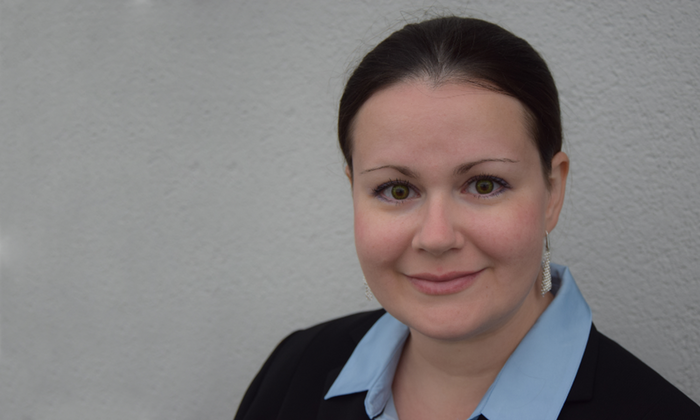
High-performance, low-cost solar cells are an important part of the energy revolution, this is why there has been intensive research on this technology for many years. One area that has caused much excitement in recent years, deals with so-called perovskite cells. These small solar power plants are significantly lighter and less expensive in production than conventional silicon cells, and have recently seen significant efficiency improvements. For a long time researchers were faced with a major riddle when it came to manufacture, as the manufactured cells showed inexplicably large differences in quality. However, a research group at the Technical University of Dresden (TU Dresden) has successfully solved the riddle. They identified a specific anti-solvent as the cause of the low reproducibility. In their study, they were able to show how different applications of the substance led to deviating results in production. The researchers were also able to derive recommendations for optimal application from their work. "Our results offer valuable insights for the perovskite research community, that are necessary for the further development of this promising technology into a commercial product", said director of studies Prof. Vaynzof. The results were published in the prestigious journal ‘Nature Communications’.
April 9, 2021 | TU Dresden advances into the gigahertz range for the first time with organic diodes
The Institute of Applied Physics (IAP) at Dresden University of Technology is one of the world's leading research institutions in the field of organic electronics. The goal of institute director Prof. Karl Leo and his team is to develop completely metal-free components to enable new fields of application such as roll-up screens, organic man-machine interfaces or body-compatible electronic implants. Until now, however, diodes made of purely organic materials were considered too slow (computing power of about 20 to 30 megahertz), thus they were always supplemented with silicon components. A new technology from TU Dresden, which combines carbon-based transistors using a novel vertical design, could change that. It can be used to create purely organic diodes that achieve switching frequencies of up to 3 gigahertz. Prof. Karl Leo and his team are confident that the vertical technology will soon enable them to produce complex organic circuits that are as fast as silicon chips. With them, even fully rollable OLEDs would get closer.
April 1, 2021 | Dresden start-up Packwise launches international business with fresh money
The Dresden-based start-up Packwise is digitizing value chains for companies in the chemical and food industries by equipping industrial packaging with small Internet-of-Things sensors. The technology offers clients a variety of functions to make their supply chains more transparent, secure and efficient, for which Packwise was awarded the “IQ Innovationspreis Mitteldeutschland” last year. The company, which was founded in 2017, has now been able to raise a seven-figure euro amount from its investors, including Technologiegründerfonds Sachsen, in a Pre-Series A financing round. Packwise wants to use the money to expand its software platform, accelerate growth in the European market and prepare its market launch in North America. For this purpose, the start-up plans to further expand its development and sales team.
Read more
March 26, 2021 | AI-based identification method for cells: Biophysicist Herbig receives Dresden Excellence Award.
The Dresden Excellence Award is a science prize awarded once a year by the city of Dresden to outstanding research work that is of particular relevance to Dresden's city development. The prize is awarded in the categories Bachelor, Master, PhD and Habilitation. This year's winner in the category PhD is biophysicist Dr. Maik Herbig from the Center for Regenerative Therapies (CRTD) at the Technische Universität (TU) Dresden. In his thesis, the scientist was able to develop a new method for identifying cell types that is based on the use of artificial intelligence and machine learning and can distinguish cells based on mechanical and morphological properties. The new technology (called RT-DC) does not use color markers, which makes it cheaper and faster than conventional methods and increases its range of applications.
The process is already used by a TU Dresden spin-off. For Dr. Robert Franke, head of the Dresden Office of Economic Development, this is an important contribution to the innovative strength and attractiveness of the location: "Whether new treatment approaches in the fight against multiple sclerosis or the revolutionary identification of cell types - all the award-winning papers have practical applications and high value for our lives - today and in the future". The City of Dresden’s Office for Economic Development runs the award since 2017.
March 19, 2021 | Infineon and GLOBALFOUNDRIES: Working together for the high-tech valve
"Silicon Saxony" in Dresden is one of the world's leading semiconductor clusters and is home to the largest and most modern chip factory in Europe. The branch of the American chip manufacturer Globalfoundries recently became the venue for a special challenge of the Smart Systems Hub industry association. The task of the Challenge was to develop a new monitoring system for the factory's special valves. As a result, the participants have now presented an AI-based control system with high-tech sensor technology and edge computing solution that can detect defective valves at an early stage and thus avoid production interruptions. In addition to Globalfoundries, Infineon Dresden, Sensry, Coderitter and T-Systems Multimedia were also involved in the development. Their prototype will be brought to market maturity in the future.
Read more
March 12, 2021 | Dresden chip manufacturers relieve the automotive industry
The Dresden semiconductor industry cannot complain about empty order books at present. Quite the opposite: The rapidly growing use of silicon wafers in the automotive industry has caused a veritable boom in demand in the recent past. The result: there is pressure for expansion in Silicon Saxony, Dresden's renowned semiconductor cluster, which is home to three leading manufacturers: Bosch, Infineon and Globalfoundries. While the chip specialist Globalfoundries is currently busy expanding its existing capacities, Bosch is preparing for the opening of its first chip factory at the site. The factory is scheduled to start producing in June.
The chip factory, in which Bosch has invested a total of around one billion Euros, is one of the most modern in the world and is supported by the German government. The same applies to the expansion of the Globalfoundries factory. The state subsidies are intended to bind the strategically important key industry even more strongly to the location.
When you play the video, a connection to an external website is established, your user information is transmitted and possibly processed there. Further information can be found in the privacy policy. (Privacy policy).
Read more
March 5, 2021 | ZEISS and TU Dresden enter into strategic cooperation
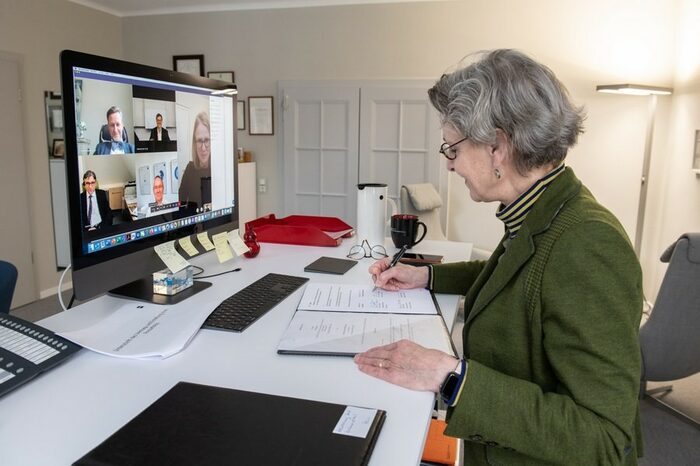
Whether in microelectronics, quantum materials, semiconductor technology or 6G - business and science are working hand in hand in the Dresden innovation space. This also applies to Dresden University of Technology and the technology company ZEISS, which recently entered into a long-term cooperation. The optics specialist from Jena wants to use the cooperation to network closely with students and scientists at TU Dresden, physicians at the university hospital, as well as start-ups and innovative companies from the region. The cooperation will not be limited to optical technologies, but will also cover areas such as life sciences, medical technology, microelectronics, nanotechnology, computer science and artificial intelligence. The first project is in the field of organoids, in which the Leibniz Institute of Polymer Research and the Else Kröner-Fresenius Center for Digital Health are participating. Organoids are artificially created tissue parts that resemble human organs. The cooperation is initially scheduled to run for three years.
February 26, 2021 | TU Dresden develops sniffing robot for disaster operations
When you play the video, a connection to an external website is established, your user information is transmitted and possibly processed there. Further information can be found in the privacy policy. (Privacy policy).
In accidents, disasters or the removal of war damage - gases can pose a great danger, especially if they are odorless. For this reason, seven chairs at TU Dresden, led by Dean Prof. Dr. Uwe Aßmann, have jointly developed the SNIFFBOT, a remote-controlled robot that can inspect and secure the area using gas sensor technology. In the future, the robot will be used in hazardous situations in larger numbers and be able to communicate with humans, its physical environment as well as the other robots. In addition to securing catastrophic events, the technology is also suitable for industrial applications such as monitoring complex production facilities. The SNIFFBOT project is funded by the Sächsische Aufbaubank as part of the Smart Systems Hub Dresden with a total of 1.78 million euros and will run until the end of 2021.
Read more
February 19, 2021 | Fraunhofer-Gesellschaft launches research project to develop 6G standard
The Fraunhofer-Gesellschaft's 6G SENTINEL research project aims to drive forward the development of important technologies for the 6G mobile communications standard. Among others, the Fraunhofer Institute for Reliability and Microintegration (IZM) from Dresden is involved in the project, which aims to perform important pioneering work in a key market of digitalization with its research. The 6G mobile communications standard is intended to ensure better performance in terms of data rate, energy efficiency, latency and reliability of the mobile network. It is considered an important prerequisite for the widespread real-time remote control of physical objects, which is central to IoT applications or self-driving cars, among others. This is an area of research which various research institutes in Dresden such as the Barkhausen Institute or the 5G Lab Germany of Dresden University of Technology have worked on intensively for many years.
A co-founder of the 5G Lab Germany is long-time 5G expert Prof. Dr. Gerhard Fettweis, who was recently awarded the European SEMI Award. As one of the leading researchers in the field of communications engineering, Fettweis is involved in the development of a unified 6G radio spectrum to handle both cellular and sensory communication of robotic applications. To this end, the first IEEE International Online Symposium on Joint Communications & Sensing will take place from 23-24 February 2021, organised by the Barkhausen Institute and TU Dresden.
February 05, 2021: Dresden-based research cluster SaxoCell wins funding in the millions
About SaxoCell
January 29, 2021 | Volkswagen starts series production of the ID.3 in the Gläserne Manufaktur Dresden
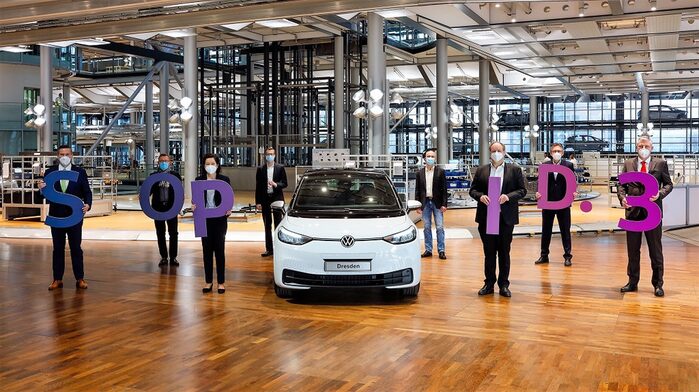
After six month of conversion work on the production line, the time has finally come: The first ID.3 rolls off the production line at the Gläserne Manufaktur in the presence of the Saxon Minister of Economic Affairs, Martin Dulig. This makes Dresden the second production site after Zwickau for Volkswagen's compact electric vehicle, which was launched in 2019 as the successor to the Golf and the first model in the ID. series.
Like all electric vehicles from the Volkswagen Group, the ID.3 is based on the Modular E-Drive Toolkit (MEB), the technological backbone of the Volkswagen E-Offensive. Mayor Dirk Hilbert sees this as a step that will also benefit the city of Dresden: "We want to develop Dresden into a model city for sustainable and integrated urban mobility. Thus we have included the new e-model in the fleet of the state capital. We have also been working as a community to ensure that the charging infrastructure is steadily improving." Parallel to the start of production of the ID.3 in the manufactory, the neighboring Volkswagen visitor center is also opening a new chapter. As the "Home of ID." it will deliver up to 9,700 ID. vehicles to customers each year. Another focus of the strategic realignment is the expansion of the research site. New opportunities now arise to test innovative projects in small series in the manufactory before they are used at the large volume sites.
Read more
January 19, 2021 | NorcSi wants to bring silicon batteries to market maturity - Helmholtz Center involved in development
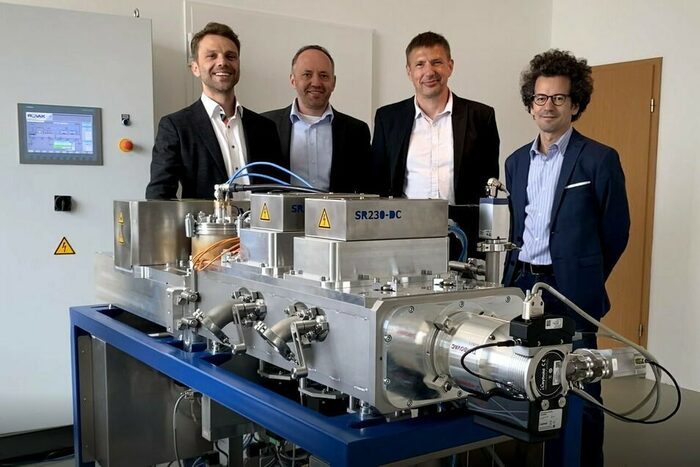
From flashlights to electric cars – lithium-ion batteries have become increasingly powerful in recent years, but today they have virtually reached their technological limits. In the expectation of future leaps in development, new materials are needed. One promising candidate is silicon. The semimetal could increase the storage capacity of batteries tenfold in the future, but it changes its chemical structure very quickly, which has impeded industrial applications so far. However, thanks to a new manufacturing technology that treats the silicon with lightning, this could change. Developed at the Helmholtz-Zentrum Dresden-Rossendorf (HZDR), this new technology is to be brought to market by the Dresden-based start-up NorcSi. The company, a spin-off of the HZDR, wants to bring the silicon batteries to series maturity in the coming years. It is confident that the new technology is not only more powerful, but also more cost-effective than current batteries. As e-mobility is currently on the rise, the international demand for such energy storage devices is high.
January 12, 2021 | Saxony supports Senorics with two Million Euros
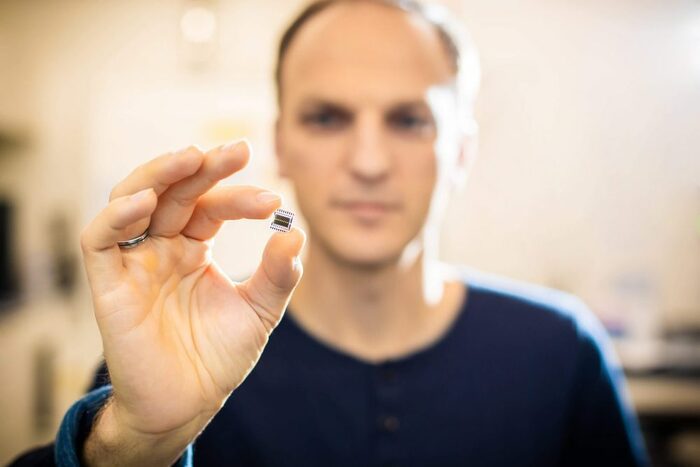
Senorics GmbH is a high-tech company from Dresden that develops organic sensors for the substance analysis of food, beverages and textiles. Their mini-sensors, which are suitable for everyday use, represent a low-cost alternative to laboratory analyses and are expected to enable a wide variety of consumer applications in the future, for example to determine the sugar content of fruit. The Free State of Saxony is therefore supporting the company on its way to mass production with a grant of two million euros. The grant will be used to set up a pilot line and is provided by the joint funding scheme of Saxony and the EU, which has so far supplied 50 million euros to saxon companies. On the occasion of the funding, Saxony's Minister of Economic Affairs Martin Dulig emphasized Senorics' innovative strength and its importance for Dresden as a business site. Senorics emerged from the Institute of Light Physics (IAP) at TU Dresden in 2017 and currently employs around 40 people.
Read more
-
Press Release
Near-infrared sensors: Ministry of Economics funds pilot line of Senorics with two million Euro
08th January 2021 | Coding platform EntwicklerHeld raises fresh money for expansion
Technologiegründerfonds Sachsen and Björn Bak, founder of the dating platform Lovoo and venture capital fund Edition.VC from Dresden, are investing a high six-figure sum in Dresden-based coding platform EntwicklerHeld. Founded in 2018, the company offers online coding challenges that software developers can solve to compete with others while attracting attention in the job market. The platform is home to professionals actively seeking for a job, as well as to those who are currently employed but could imagine a job change in the future. The company assumes around 70 percent of all developers to be open to new job opportunities. Since many of them also code in their free time, the investors still see a lot of potential in the platform. Their capital raise will therefore be used to further expand in the coming years. So far, around 20,000 people have registered on EntwicklerHeld. The platform was designed by the founders during their studies at TU Dresden and later developed in cooperation with the university service dresden|exists and numerous IT partners from the region.
Read more
-
Oiger - News from business and science
Lovoo founder Bak invests in Dresden platform "EntwicklerHeld" (article in german)
-
Startup Mitteldeutschland
Capital from Lovoo founder (article in german)
-
Startbase
Lovoo founder invests in EntwicklerHeld (article in german)
- About EntwicklerHeld
30th December 2020 | Dresden-based chip company FMC collects 20 million US dollars for new storage technology
The Dresden-based chip company Ferroelectric Memory GmbH (FMC) has received around USD 20 million in a Series B financing round for the further development of a promising data storage technology. The financing round was led by new investors M Ventures and imec.xpand, and also included Hynix, Robert Bosch Venture Capital and other investors from the technology sector. FMC specializes in the development of ferroelectric memories, which are characterized by particularly high speeds, enormous scalability and extremely low power consumption. The small chips are regarded as next-generation memory solutions and open up new application possibilities for technologies from the fields of artificial intelligence, Internet of Things, Big Data and 5G. The Dresden-based company intends to bring the innovative memories to market maturity in the coming years. To this end, the company plans to enlarge the team and drive its international expansion forward, including in the US and Asian markets. FMC has developed its technology together with Globalfoundries at the Nanoelectronics Laboratory of TU Dresden.
Read more
-
Electronics Weekly
FRAM startup raises $20m series B
23th December 2020 | Dresden researchers turn electricity into quantum honey
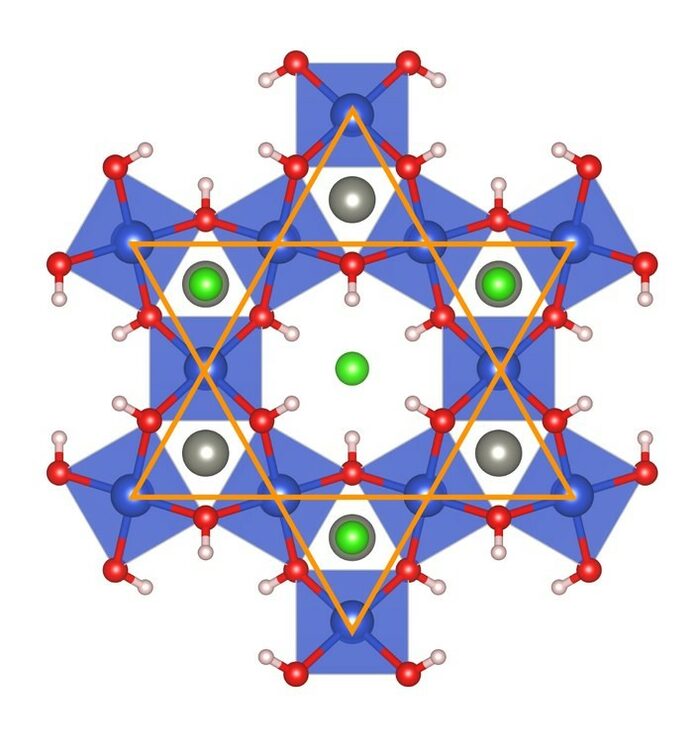
Herbertsmithite is a quantum material that was discovered by scientists of the Dresden Cluster of Excellence ct.qmat and could play a decisive role for future developments in the field of microelectronics. The reason: The material has a special lattice structure in which electrons not only move individually, but like a viscous liquid, which is hardly disturbed by the lattice. A phenomenon that Johanna Erdmenger and Ronny Thomale, scientists of the Cluster of Excellence, call "quantum honey". In the future it could be used for the faster and more efficient transport of electricity. Johanna Erdmenger has many years of research experience with the physics of black holes, Professor Ronny Thomale with the physics of solid bodies. The two researchers only succeeded in discovering the material because they combined two previously separate theories of quantum gravity and solid state physics. The research results were recently published in the journal Nature Communications.
Read more
-
Technische Universität Dresden
Quantum honey from black holes
16th December 2020 | Jenoptik invests in production plant for the manufacture of future sensor generations
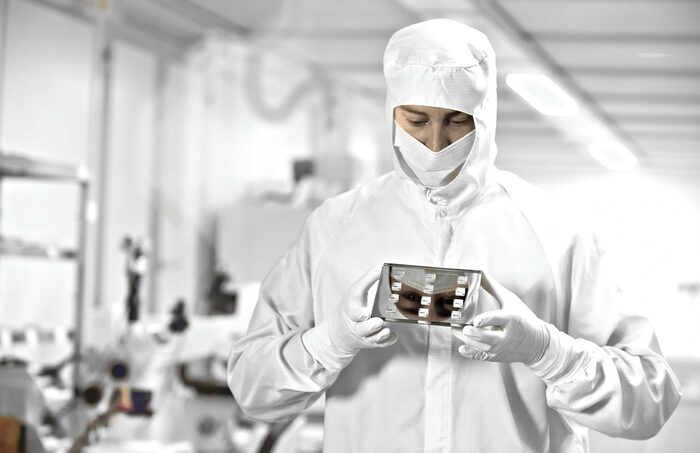
Jenoptik is investing in a new electron beam facility which will be put into operation in Dresden by mid 2022. The new facility will be built by the Jena-based specialist Vistec Electron Beam. The facility will form a core element in the development and production of new generations of precision sensors. Due to its enormous accuracy, it is capable of processing materials in the 10-nanometer range, which corresponds to approximately one 2,000th of a hair. The system is versatile and is used in Dresden, among other things, for the production of micro-optics, the core of Jenoptik sensors. The sensors are indispensable for the semiconductor industry, which also operates under high-precision requirements. Jenoptik is one of the world's leading development and production partners for optical and microoptical systems.
Read more
-
LaserFocusWorld
Jenoptik invests in e-beam lithography tool to strengthen micro-optics capabilities
- About Jenoptik
09th December 2020 | Schaufler Lab@TU Dresden discusses AI with artists and scientists
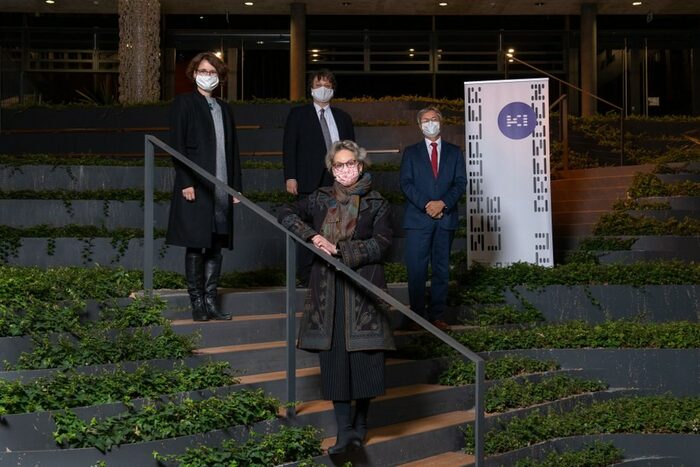
The Schaufler Lab@TU Dresden is an initiative of the Schaufler Foundation and the TU Dresden, which brings together scientists and artists to discuss technological innovations and changes in society and culture. The lab consists of two pillars, the Schaufler Kolleg@TU Dresden and the Schaufler Residency@TU Dresden. It was officially opened on October 28 with a virtual kick-off event. The first project phase of the Lab will focus on the question of how artificial intelligence (AI) changes cultural and social structures and how it is itself created and changed by them.
At the TU Dresden, many research units from mathematics, natural sciences and engineering contribute significantly to the development of AI. All participants are committed to a transdisciplinary research method at the interface of science and art.
Read more
26th November 2020 | Handelsblatt ranking - Fabmatics ranks 35th place among the most innovative medium-sized companies 2020
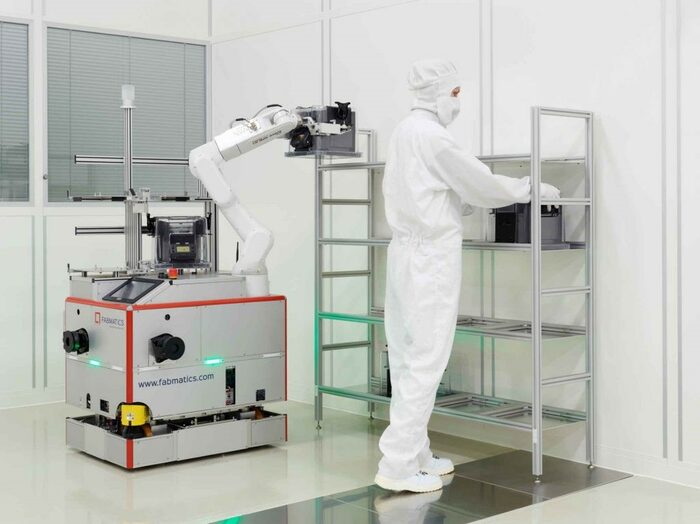
Fabmatics is a Dresden-based service provider for factory automation that offers its customers innovative solutions for highly technical production environments. The company was formed in 2016 from a merger of Roth & Rau – Ortner GmbH and HAP GmbH, two automation specialists from the Dresden semiconductor industry. The merger enabled Fabmatics to establish itself as a system integrator in the field of smart factories and Industry 4.0, where it is now one of the leading providers. In recent years, Fabmatics has been able to expand widely thanks to strong demand from the high-tech industry, which recently earned it the 35th place in the Handelsblatt ranking of Germany's fastest-growing medium-sized companies in 2020. More than 4,000 German medium-sized companies were examined for the "TOP 100 Mittelstand 2020" ranking.
Read more:
19th November 2020 | Dresden Cluster of Excellence ct.qmat develops customized crystals for quantum chips
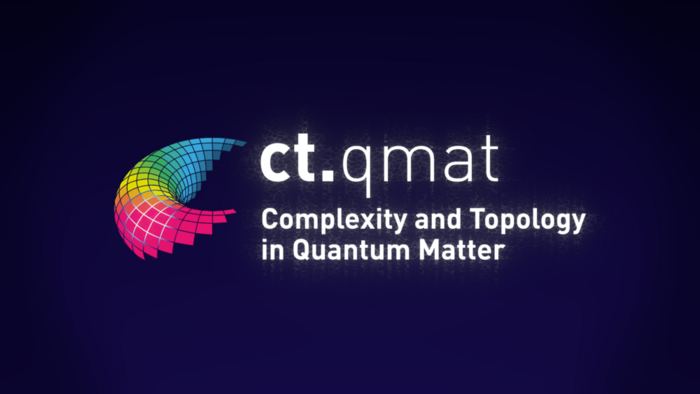
Atom by atom, the researchers of the ct.qmat cluster of excellence create the materials of the 21st century in their laboratories. Quantum materials, such as manganese-bismuth-telluride: a custom-made crystal that can conduct electricity on its surface with no loss whatsoever while being insulated on the inside. Hope of a material revolution is pinned on the material. Its discoverers, among them Dresden Junior Professor Anna Isaeva and Dr. Alexander Zeugner, are working on the material together with a scientific community from 29 nations. Applied in thin layers, the miraculous material can be used on all surfaces - even on so-called quantum chips. They have the potential to drastically reduce the energy consumption of computers while significantly increasing their storage capacity and computing power. They represent an important development on the way to more sustainability in information technology.
Read more
12th November 2020 | Digital Infrastructure for Renewable Energies - Kiwigrid continues to develop software platform
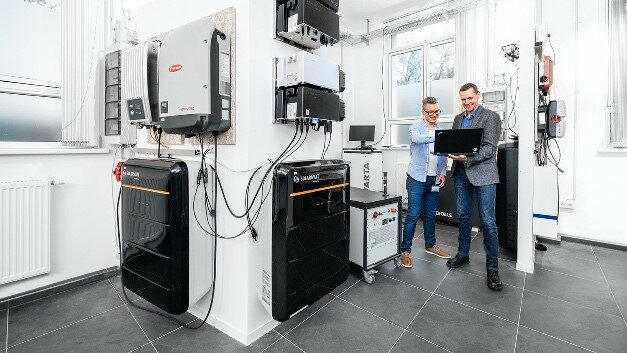
Whether in private households or at energy suppliers - energy management systems play an important role in the efficient use of renewable energies. Thanks to state-of-the-art software, they can connect photovoltaic systems to stationary storage facilities, the power grid or an electric car. The Dresden-based manufacturer Kiwigrid already networks around 150,000 devices in this way on a decentralized platform.
With a new generation that couples the heat sector to the platform in addition to photovoltaics and e-mobility, the number is set to grow even further. The goal: millions of devices form a software-controlled unit so that electricity is made available in real time and across national borders. Being situated in Dresden could help Kiwigrid achieve this goal, as the location’s university landscape and expertise in electrical engineering are considered particularly favorable for greentech companies. With Solarwatt and Heliatek, Kiwigrid also has two other energy companies in its immediate neighborhood, which are also funded by technology investor Stefan Quandt.
6th November 2020 | Battery tests for the automotive industry – Novum receives capital injection in the millions
Novum Engineering is a Dresden-based startup that offers AI-based monitoring for batteries. Shareholders of the company, which was founded in 2014, are High-Tech Gründerfonds and the venture capitalist Dr. Hettich Beteiligungen, who together have already invested around 3.5 million euros before. They want to support Novum in improving a diagnostic device that can test the wear condition of batteries within seconds. The device works with a patented method and independently from internet connection. Conventional methods, on the other hand, require the batteries to be permanently online. In addition to large-scale storage systems, Novum plans to use the offline method for discarded automotive batteries in the future. So-called 2nd life rapid tests will allow them to be checked much more quickly for their suitability for later use as stationary storage devices. The investors see great potential in their application in the automotive sector.
28th October 2020 | Additive Drives secures seed financing of EUR 1.3 million
Three months after its foundation, the Dresden-based startup Additive Drives has completed a seed financing round. Its new investor is Munich-based AM Ventures Holding, which specializes in additive manufacturing technologies – it will invest 1.3 million euros. The financing is intended to support Additive Drives in advancing the market launch of 3D printed components for electric motors. The company's goal is to halve the development time of electric motors using these components. The startup is a spin-off of the Technical University Bergakademie Freiberg near Dresden. In addition to being part of the SAXEED startup network, Additive Drives also cooperates with various universities and commercial enterprises.
22th of October 2020 | Globalfoundries presents new AI chip "made in saxony": Serial production to start 2022 in Dresden
The novel chip was developed by the semiconductor manufacturer Globalfoundries in cooperation with the Belgian research company Imec. Its strength lies in the processing of large amounts of data, such as those found in Big Data and AI applications. For these, the chip needs to work extremely energy-saving and to be more powerful than conventional chips. A functional demonstrator was recently presented to the public. The start of serial production is planned for 2022. The exclusive production site is Dresden, Europe's largest semiconductor production site. Globalfoundries operates a plant there, which is considered to be world-leading in semiconductor production. Globalfoundries plans to invest around 1.4 billion euros in its own expansion in 2021.
15 October 2020 | CO2 in steel production: Blast furnace hydrogen extraction in Dresden saves eight million tons a year
Around seven percent of global CO2 emissions are generated in steel production. One reason for this is the CO2-intensive use of coke to reduce iron ore. To reduce CO2 emissions, coke is now to be replaced by hydrogen. To this end, scientists from Fraunhofer Institute, including its Dresden-based ceramics institute IKTS, are researching a new process called direct reduction. It would make it possible to save 95 percent of the current CO2 emissions – in Germany around eight million tons a year.
The savings are made possible by hydrogen extraction integrated into steel production, which uses a special electrolysis system developed by IKTS. Thanks to heat-resistant ceramic cells, it should be able to use not only green electricity but also the heat from the blast furnaces for the hydrogen extraction. The process has already been examined by IKTS researcher Dr. Matthias Jahn in a feasibility study and is to be further tested as part of a Saxon hydrogen competence center.
09th of October 2020 | Dresden-based manufacturer of mini wind turbines prepares IPO
With only three employees and four installed systems, the Dresden-based technology start-up iQron is at the very beginning of its corporate history. But it already has big plans. The company intends to set up production with 50 employees in Saxony and sell around 4,000 small wind turbines annually on the world market. To achieve this, however, additional capital is needed, which iQron now wants to raise by going public on the Paris stock exchange, which offers technology start-ups a good investment climate through its Access Segment. The sale of 25 percent of the shares should generate proceeds of eight million euros. Of this, 4.5 million are planned for the development of production and sales, the rest will flow back to the owner, the Dresden venture capital holding E2C3, according to the "Sächsische Zeitung".
There is great potential in the small wind turbines: With a diameter of only 4.4 meters and an output of 2.5 to 7 kilowatts, they are ideal for the emission-free and cost-effective operation of mobile phone masts and water pumps. iQron would be the first manufacturer to mass-produce the mini wind turbines. There is no shortage of potential customers for the company: there are around two and a half million mobile phone masts worldwide that come into question. With Deutsche Telekom, the ambitious start-up has already found an important cooperation partner for initial field tests in Nuremberg.
Read more
02.10.2020 | Dresden-based car sharing provider Carl and Carla expands into four more cities
Carl and Carla is expanding rapidly. The Dresden-based car sharing service provider for vans, minibuses and campers is expanding its fleet by 100 additional VW vans and is now also present in Dortmund, Bonn, Erlangen and Fürth. The company currently offers a total of 500 vehicles in 21 German cities. As its latest model, the startup added an electric minibus from VW, the Elektro-6.1T, to its fleet. With this prototype, the team wants to find out how the new offer is accepted by customers and how they handle it. Carl and Carla originated in the Future Mobility Incubator of VW's “Gläserne Manufaktur” in Dresden. The start-up program is a cooperation between Volkswagen and the City of Dresden to promote innovative business ideas related to future mobility.
25th of September 2020 | Modern technology against cancer - New National Center for Tumor Diseases at Dresden University Hospital
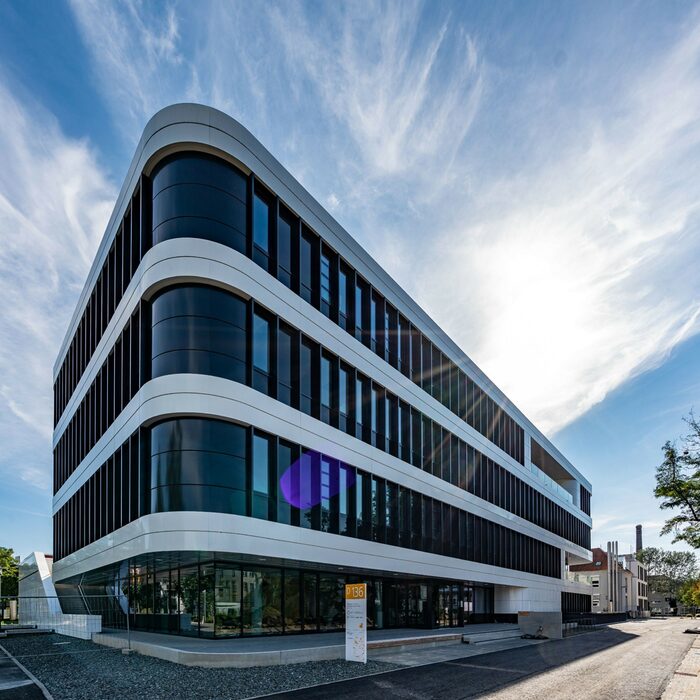
With the National Center for Tumor Diseases (NCT/UCC), a new hotspot for research and treatment has opened in Dresden. The NCT is supported by the University Hospital and the Helmholtz Centre Dresden-Rossendorf (HZDR). he Medical Faculty Carl Gustav Carus of the TU Dresden and the German Cancer Research Centre (DKFZ) are also represented at the NCT, which thus brings together a large number of renowned research institutions in one location.
Scientists and medical experts have access to the most modern facilities for analysis and treatment available in Germany. The close proximity also facilitates the intense interdisciplinary cooperation of different specialists and disciplines required for complicated cancer diseases and simplifies processes from cell analysis to the surgical removal of malignant tissue. The networking of instruments and equipment by experts from medicine and computer science is decisive in this context. In total, up to 500 peoplewill make valuable contributions to the fight against tumour diseases at the NCT in Dresden.
This further reinforces Dresden's status as one of the leading biotech locations in Europe. Only in July, the newly founded company Innate Repair Saxony GmbH (iRSN) added another biotech player to the site. The city of Dresden is supporting the company, which is active in the field of diabetes research, with 70,000 euros in funding as part of its this year's Innovation Promotion Program.
Read more
17th of September 2020 | Dresden's Innovation Promotion Program - 2020 award winners presented
In its fourth year of its innovation promotion program, the city of Dresden supports seven exceptional projects that use new and clever approaches to tackle problems of relevance to the city. An expert committee evaluated the submitted applications in June 2020. The decisions over funding amounts between 10,000 and 100,000 euros have now been announced during an award ceremony. This year's winners are the companies Innate Repair, coboworx, SEMRON, eMAXX, PIKOBYTES, scoolio and IoT-Plan. They represent the broad spectrum of innovations emanating from Dresden. The innovations tackle global challenges such as energy efficiency and sustainability as well as very practical issues such as the use of robots in small and medium-sized enterprises or securing skilled workers.
The city’s Innovation Award is open to all topics and enables projects in the fields of Industry 4.0 , Smart City, new materials, future energy systems or non-technical innovations. The applicants are founders and start-ups from the high-tech sector, small and medium-sized enterprises (SMEs) based in Dresden, as well as research institutions and non-SMEs within the framework of company alliances.
Read more
www.dresden.de
Dresden's Innovation Promotion Program
Information for applicants
DAWO press release
Innate Repair
coboworx
SEMRON
eMAXX
PIKOBYTES
scoolio
IoT-Plan
10th of September 2020 | CeTI Dresden founds “Campus Genius” - 5G-networked robots support companies worldwide
The CeTI ("Center for Tactile Internet with Human-in-the-Loop") of the TU Dresden has founded the company "Campus Genius" in order to provide solutions for individual 5G networks to the market. With this, the CeTI Cluster of Excellence is reacting to the increasing demand for 5G networked robots, which can be used to make processes in companies more efficient, faster and more cost-effective. Fifth generation mobile communications (5G) are significantly more responsive than their predecessor LTE and can coordinate many hundreds of operations in parallel. The startup offers campus network cores and containers which are mobile 5G transmitting stations in the 3.7 and 3.8 gigahertz frequency window. They are also attractive for the path towards Industrial Internet of Things from a data protection and industrial espionage perspective as they are isolated from public mobile networks. Moreover the team around Thomas Höschele and Sebastian Itting does not use any controversial technology, but only well-known brand products and in-house developments.
4th of September 2020 | Dresden-based start-up WAKU Robotics expands internationally – Marketplace for industrial robots grows
Dresden is one of Europe’s leading robotics hubs. Young companies such as Wandelbots, which offers no-code robotics solutions, or Coboworx, where tailor-made robotics concepts are developed for SMEs, take advantage of the city’s innovative power. The young players in Dresden also include the start-up WAKU Robotics, which offers two main solutions to its international customers from the fields of logistics and e-commerce for finding the right robots for their respective applications: the independent comparison platform "LotsOfBots" and the Online Robot Solution Designer. Internationally, the demand for robots is high, but procurement is often difficult and time-consuming. WAKU Robotics has therefore set itself the goal of becoming the world's largest marketplace for mobile robots. In expanding internationally, they get support from well-known investors such as Technologiegründerfonds Sachsen, the innovation platform Plug and Play and Hans-Jürgen Cramer, former managing director of Vattenfall Europe, who recently invested one million euros in the start-up.
Read more
founderella.de
wirtschaft-markt.de
25th of August 2020 | Dresden-based company develops Corona app for tracking event participants
From September 1st on, the "pass4all" app developed in Dresden to track contacts with corona infected persons at events will be available for download in app stores. The app reduces the effort of documenting the attendees of an event, as there will no longer be a need to issue personalized tickets. Instead, health authorities can effectively track possible chains of infection via the app. This is made possible by using a QR code or Bluetooth on the cell phone to store information on visitors’ data regarding location, time, area, row and seat. This information is already encrypted on the user’s mobile phone and thus transmitted anonymously to the health authorities. pass4all thus supplements the official Corona warning app of the German government.
Read more
www.dnn.de
www.mdr.de
Company Website:
www.pass4all.de
20th of August 2020 | The first construction site in Germany automated via 5G mobile communications is emerging in Dresden
In Dresden, a pilot construction site automated via 5G mobile communications is to go into operation in mid 2022. This is the aim of a project coordinated by the Institute for Mechatronic Mechanical Engineering at the TU Dresden, in which over 20 construction companies, construction machinery manufacturers, software companies and other institutes are involved. By retrofitting construction machines with digital assistants and 5G modules and connecting them with a new type of construction site cloud, a more efficient construction process will be facilitated. This however constitutes only a partial automation. The robots will continue to be controlled by people on the construction site, whose work will be supported by digital assistance systems. Nevertheless, the innovation is also intended to counteract the shortage of skilled workers.
12th of August 2020 | Research team at TU Dresden works on the development of Corona rapid test
An interdisciplinary team of researchers at the TU Dresden is working on the development of a Corona rapid test, aiming to deliver results much faster than previously possible. Based on the analysis of blood drops, the test is planned to take only a few minutes, whereas the results of currently existing tests are only available after about four hours in the best case scenario. The method is planned to be ready for use in 2021. In the long term, it is also planned to develop a test methodology that will enable sensors on smartphones to detect an infection through skin contact. Employing faster tests enables the timely interruption of chains of infection, thus making an important contribution to containing the pandemic.
6th of August 2020 | Expansion of the “Universelle Werke” planned – New Innovation Campus for Robotics and Lightweight Constructions in Dresden
The “Universelle Werke“, the Dresden innovation center for high-tech companies, is to be expanded by 2022. Already now, the centre on the site of the old factory is home to start-ups, research and technology companies in the fields of lightweight construction and new materials, digitalization as well as future mobility and robotics. Since its inauguration in 2019, the location enjoys great popularity and its capacity is fully utilized. Therefore the Dresden Economic Development Agency together with the real estate experts from Immopact are now planning the spatial expansion. This will create a completely new innovation campus focusing on robotics and lightweight construction in the heart of the city. The reactivation of an additional 15,000 square meters will almost quadruple the usable area of the Universelle Werke and provide space for many further innovative companies.
Further Information:
30th of July 2020 | Coboworx opens new office at the “Universelle Werke” – Business location Dresden attractive for up-and-coming robotics-startup
The company coboworx with its headquarters in Osann-Monzel near Trier opens a new office at the “Universelle Werke”, a technology centre in Robot Valley Dresden. The startup offers robot-based automation solutions for small and medium-sized enterprises. The founders cite the innovative strength of the TU Dresden and the exciting ecosystem of the location in the field of robotics as decisive factors in the choice of location. In addition, the city's fast decision to grant an innovation support contributed to the decision. coboworx specializes in collaborative robots, so-called cobots. The company has developed a new software-based method for significantly shortening the risk and hazard assessment of new cobots and offers an online platform for the digitalised recognition of automation potential and the calculation of the ROI.
Learn more: Automationspraxis
and DNN
14th of July 2020 | Dresden companies take part in the HANNOVER MESSE DIGITAL DAYS
Several companies from Dresden presented their work at the virtual HANNOVER MESSE DIGITAL DAYS on 14 and 15 July. N+P Informationssysteme GmbH presented its development of a "Digital Twin" which acts as a human-centered information point in industrial software, FCP Fuel Cell Powertrain GmbH presented innovative fuel cells and powertrains for the international market and Wandelbots showcased its latest product, the TracePen. Two Fraunhofer Institutes also participated, EAS Dresden of the Fraunhofer Institute for Integrated Circuits IIS participated with an innovation in the field of sensor technology and predictive maintenance, and the presentation of the Fraunhofer Institute for Ceramic Technologies and Systems IKTS featured an innovation in the field of green hydrogen.
10th of July 2020 | TU Dresden Cluster of Excellence makes spectacular discovery in the field of solid state physics
The Cluster of Excellence Complexity and Topology in Quantum Matter (CT.QMAT) of TU Dresden opens up new fields of research for physicists from all over the world with a spectacular discovery. The research group was able to demonstrate phenomena of quantum physics in ultrapure metals on a macroscopic level for the first time. Previously, most of these phenomena had only been observed at the smaller microscopic level, thereby on the scale of atoms and electrons. Experimental evidence was obtained on the ultrapure metals palladium cobalt oxide and platinum cobalt oxide by measuring periodic superpositions of electron waves over a length of 20,000 atomic distances. Previously, only measurements over a length of ten to 100 atomic distances were common.
8th of July 2020 – Three Dresden startups are awarded the Saxon Founders Prize - Morphus Space GmbH wins first place
Three of the five winners of the Saxon Founders Prize 2020 are companies from Dresden. The prize was awarded as part of the digital format of the futureSAX innovation conference.
The first place was awarded to Dresden-based Morpheus Space GmbH for amazingly small and efficient propulsion solutions for the autonomous operation of satellites.
The second place went to Semron GmbH, also based in Dresden, for manufacturing semiconductor chips with the energy efficiency of a brain.
The third place also went, partly, to Dresden, to Peerox GmbH for a self-learning assistance system for operating machinery. The third place was also awarded to LiGenium GmbH from Chemnitz, the audience award went to BSW-Education from Thalheim.
The Award:
medienservice.sachsen.de
founderella.de
The Startups:
Morpheus Space
Semron
Peerox
24th of June 2020 | New laboratory complex in Dresden – Institute for research on quantum materials planned
The Leibnitz Institute for Solid State and Materials Research (IFW) is planning the construction of a new building complex on premises of about 10,000 square meters in Dresden. From 2024 onwards, it will offer space for laboratories specialising on industry-related research as well as a newly planned institute for research on quantum materials. Research on these materials, which have particularly special properties due to quantum effects, is expected to help achieve breakthroughs in the fields of quantum computer construction, the energy industry and medical technology. The IWF is already located in Dresden, but the currently used premises already provide insufficient space.
Read more
17th of June 2020 | Microsoft and Siemens invest in Dresdner Startup Wandelbots – TracePen successfully launched
The TracePen, the latest innovation of the Dresden start-up Wandelbots, is now available on the market. The device allows for the uncomplicated programming of industrial robots without special previous knowledge. In its Series B financing round, Wandelbots recently raised a total of 26 million euros. Among the investors were the London-based venture capital firm VC 83North, as well as Microsoft and Siemens. Additionally, investors who had already participated in the last financing round in 2018 further expanded their investments.
product launch
robot teaching and installation (german)
financing round (german)
international news coverage
16th of June 2020 | Dresden uses climate-friendly concrete - foundation stone laid for the carbon house "CUBE"
The first house made entirely of carbon concrete is now under construction. On 16th of June the foundation stone for the Carbonhaus "CUBE" was laid on the premises of the TU Dresden. The university has been developing the carbon fibre reinforced concrete in many years of research. The material is significantly lighter and more durable than steel reinforced concrete and thus saves up to 70% CO2 due to less material needed. Completely new architectural forms can also be realized, as is impressively demonstrated by the curved roof of the carbon house. In Dresden, carbon concrete is already being used for a bridge extension. The renovation work on the "Carola Bridge" is already well advanced and the building material has proven itself to be viable.
digital laying of the foundation stone
CUBE: "We're writing history"
german press: "Dresden gets house from super concrete"
construction progress of the "Carola bridge"
international news coverage
17th of May 2020 | Dresden offers optimal job prospects also after the crisis
In a comprehensive study conducted by the London-based provider of training and further education FutureLearn, which assessed the job prospects of cities after the corona crisis, Dresden is ranked 14th globally. It thereby ranks third among the German cities following only Munich (9th place) and Stuttgart (13th place). The study is based on forecasts of the economic stability and career opportunities of the location. Factors such as the cost of living, labor law, the quality of healthcare, opportunities for immigrants and equal rights, as well as forecasts for unemployment and economic growth were all considered in the study.
6th of May 2020 | 5G NetMobil presents research results on information exchange in road traffic
The 5G NetMobil research project, coordinated by TU Dresden, has presented its results. The 5G NetMobil is a merger of 16 partners from research, medium-sized businesses and industry, who develop digital communication concepts for road traffic.
In addition to five concrete applications for networking between vehicles and their communication with the traffic infrastructure, requirements for the future 5G network have also been developed. The results will be incorporated into the worldwide standardization of infrastructure, as well as into business models and first serial projects of partners such as BMW, Volkswagen and the traffic light manufacturer Dresden Elektronik Ingenieurtechnik GmbH:
4th of May 2020 | Wandelbots presents TracePen for robot control
The Dresden-based startup Wandelbots has introduced a new product, the TracePen, which is designed to facilitate the introduction of robots into smaller companies. Movements which are performed manually can be transferred to be imitated by via the TracePen, thus eliminating the cost-intensive effort of programming. Wandelbots hereby launches its first product available on the market in higher quantities.
Further information:
www.wandelbots.com/tracepen
automationspraxis.industrie.de
www.k-zeitung.de
www.saechsische.de
9th of April 2020 | Magazine "Business Punk" declares Dresden an ideal location for high-tech
Heliatek, Sunfire and Cloud&Heat are just three examples of Dresden-based companies offering solutions for climate change due to the development of new technologies and products. The magazine Business Punk visited them and took a close look at Dresden as a high-tech location. Read more
2nd of April 2020 | Fraunhofer spin-off launches revolutionary audio technology
The Dresden-based Fraunhofer IPMS spin-off Arioso Systems GmbH has launched a new silicon-based transducer principle into the market. The new technology enables a new type of extremely small micro loudspeakers. These are used, for example, in miniaturized headphones, which can now integrate applications such as instant translation or other voice-based internet services. The project is supported by the Technologiegründerfonds Sachsen, the High-Tech-Gründerfonds III and business angels, among others. Read more
2nd of April 2020 | Dresden located Barkhausen Institute involved in development of the Corona Proximity Tracking System
The Dresden Barkhausen Institute, which works closely with the TU Dresden and specializes in the core fields of the Internet of Things (IoT), is a member and contributor to the European initiative Pan-European Privacy-Preserving Proximity Tracing (PEPP-PT). This initiative develops a basis for digital tracing in accordance with European data protection law in order to reduce the impact of the corona pandemic on life and society. The initiative has been able to contribute to the development of the security architecture, to operating system connectivity and to radio measurement for proximity detection of two individual mobile phones.
Read more
31st of March 2020 | Researchers at TU Dresden develop 3D-knitted mouth-nose mask
The technicians and scientists of the Institute of Textile Machinery and High Performance Materials Technology (ITM) at the TU Dresden, together with a cooperation partner, have succeeded in developing a fast variant for the production of novel textile 3D knitted masks for mouth and nose and have produced a prototype for immediate use. The production does not require any additional manufacturing effort.
Read more
23rd of May 2020 | DRESDEN-concept partner in the fight against the coronavirus - urgently needed parts for respirators can be manufactured by 3D printing processes
Due to the worldwide spread of the coronavirus, supply chains are currently partly interrupted, which leads to bottlenecks in production. In various European countries, 3D printing companies have established platforms to produce missing components, e.g. for ventilators by means of additive manufacturing processes, thus supporting medical technology companies. The European Commission's call for research clusters to register their 3D printers and to participate in the production of required materials, which was launched last week, has already been followed by several DRESDEN-concept partners, such as the Fraunhofer Institute for Material and Beam Technology IWS, the Chair of Technical Design at the TU Dresden, the Center for Translational Bone, Joint and Soft Tissue Research at the Carl Gustav Carus Medical Faculty of the TU Dresden and the Makerspace at SLUB.
Read more
16th of March 2020 | Globalfoundries Dresden wins new customers and orders
The Dresden-based chip factory of the semiconductor company Globalfoundries (GF) is expected to be fully utilized by the end of 2020 due to new customers and orders. The circuits manufactured there consume comparatively little electricity, which makes them particularly interesting for mobile devices and battery-powered machines. The company is currently expecting the corona crisis to have a negative impact of two to three months...
Read more
5th of March 2020 | Dresden solar module factory doubles production capacity
The Dresden-based photovoltaic system provider "Solarwatt" is on course for growth even in difficult times. Following sales records, the company is investing ten million euros in research and development as well as a new production line in Dresden. Solarwatt is thus doubling its production capacity at this location.
Read more
5th of March 2020 | Wandelbots Co-Founder Christian Piechnick receives German Startup Award in the category Best Newcomer
The prize for the best newcomer of the "German Startup Award" goes to Dresden - to Christian Piechnick, one of the five founders of Wandelbots. In Berlin, the German Startups Association selected actors of the German startup scene in five categories for the first time.
www.germanstartupawards.de
www.handelsblatt.com
www.saechsische.de


